Arzo Travels
Solo Female Travel – Switzerland, Europe and Beyond


Ultimate Germany and Switzerland Itinerary (7-14 Days)
HOW TO SEE GERMANY AND SWITZERLAND IN 7-14 DAYS
Table of Contents
Germany and Switzerland are both fascinating countries to visit – both offer diverse attractions and activities. You surely cannot go wrong with planning a Germany and Switzerland itinerary to see some of the most beautiful places in Europe. Given the geography, it is quite easy to visit both countries on one trip, one after another.
And though Switzerland is not part of the EU, it is part of the Schengen Agreement. This will allow you to visit it if you have a visa for the EU. So, today I share my favorite tips with you so that you can have a fantastic trip to Germany and Switzerland. Whether you visit for 7, 10, or 14 days – this itinerary for Switzerland and Germany will help you plan your trip.
TRAVEL TIPS FOR YOUR GERMANY AND SWITZERLAND ITINERARY
So, as a German and Switzerland enthusiast, I share my tips for having an amazing time in Switzerland and Germany.
HOW TO GET AROUND SWITZERLAND AND GERMANY
Driving in Germany
- The streets are mostly well-paved and safe, and people drive well. However, there are a lot of construction projects on the motorways which often result in traffic jams.
- There are many motorway streets without speed limits, but many do have a speed limit you should stick to (speed cams are placed throughout the country). There are no tolls for cars in Germany.
Public Transportation in Germany
- Getting around via trains and buses is actually easy and, overall, okay in Germany. The trains are not always on time, some connections might be canceled, and it isn’t cheap. However, compared to places that do not have any train service, I guess we Germans should consider ourselves lucky.
Driving in Switzerland
- Mountain streets are usually a bit more challenging, but overall, I looooove driving in Switzerland. The roads are mostly well-paved and safe, and people drive well.
- Check out my post with driving tips for Switzerland .
Public Transportation in Switzerland
- You cannot go with when choosing public transportation in Switzerland.
- Trains and buses are punctual and reliable. And the window views are out of this world.
TIP: If you plan to get around via public transportation, make sure to check out the Swiss Travel Pass, which is perfect for tourists.
- There are different Swiss Travel Passes available regarding flexibility and duration. Flexible passes allow you to use the pass for a certain amount of days within one month or the regular, more affordable option, which means you have to use the pass on consecutive days of travel.
- Yes, the Swiss Travel Pass is quite expensive but it will pay off.
- You can use buses and trains without any extra costs .
- Also, most boat cruises and some mountain excursions are included.
- The Swiss Travel Pass also covers most museums and entrances to castles .
- The great thing about it is that you never have to worry about finding parking spaces and instead use buses and trains.
- Click here to find the rates for a Swiss Travel Pass.
COSTS OF TRAVELING TO GERMANY + SWITZERLAND
Prices always depend on where you stay, what kind of accommodation you choose, what mode of transport, and more. It is almost impossible to give numbers, but I will try (though it is very vague).
If you are a mid-budget traveler and travel with someone, you should expect to pay 120-250€ per person per day. This includes public transportation and eating out (in Switzerland, you should try to go vegetarian, as meat prices are high) but no alcohol.
The costs in Switzerland will probably be much higher if you eat out each day and use a lot of cable cars. Check out my tips for Switzerland on a budget here .
If you are on a budget, you can travel for less (assuming you stay in hostels and cook for yourself at least once in a while) – but public transportation or renting a car will always be quite high.
ARE SWITZERLAND AND GERMANY SAFE?
If you are a solo (female) traveler, you will be happy to hear that Switzerland and Germany are great to travel alone, and there are no extra precautions I take – except for avoiding dodgy areas (especially at night) and watching my surroundings. Just keep your eyes open and exercise common sense, and you should be fine as both are quite safe travel destinations overall.
MORE TIPS FOR GERMANY + SWITZERLAND
- Bring your reusable water bottle and refill it at the hotel, etc. You can just refill your bottle with fresh mountain water from fountains in the southern parts of Germany an d Switzerland . Unless it says “KEIN TRINKWASSER, “ – then don’t drink it.
- Tap water is fine in many places.
- If you don’t like “Sparkling water,” then shy away from “Wasser mit Kohlensäure” and ask for “still” water. You will not get free tap water with your food (you might get a little glass of tap water if you order an espresso).
- If you buy water bottles in Germany (or soft drinks in bottles or cans), you have to pay a small deposit of about 0.25€, which you will get back when you return it to any supermarket.
- Credit and debit cards are accepted widely. However, in smaller shops and villages, that might not be the case.
- You cannot pay at some ticket centers with your credit card, so always have cash on you (American Express is, unfortunately, not as widely accepted as Visa or MasterCard).
SWITZERLAND AND GERMANY ITINERARY FOR 7 DAYS
- Munich – 1- 1,5 Days
- Neuschwanstein Castle & Füssen – 1 Day
- Lucerne – 1 Day
- Interlaken – 3 Days
Travel Time Around 12 Hours in Total
With only one week in Switzerland and Germany, I focus on destinations that are very close to each other, so travel time is reduced. But these places are still stunning – so there is no compromise on the beauty, just on travel duration. However, to see some of the best places these countries have to offer, you will need to travel to some degree.
MUNICH – 1-1,5 DAYS
Munich is a perfect starting destination – with a big airport and many trains arriving in Munich, it is easy to start international travel here.

From lakes, and parks to museums, historical sites, and shopping opportunities: Munich has something for everyone. It is one of Germany’s biggest cities, so there are tons to do and see, but in this case, I suggest spending only 1 or 1.5 days in Munich.
THINGS TO DO IN MUNICH
- Visit Marienplatz
- Rest at English Garden
- Visit Munich Residenz Palace
- Check out Viktualienmarkt
NEUSCHWANSTEIN CASTLE & FÜSSEN – 1 DAY
Then, early in the morning, continue your journey. The crowds will come, so early in the morning is really the best time to leave Munich).
One of the most beautiful and gorgeous pieces of architecture must be the Neuschwanstein Castle, south of Munich. However, it is very popular amongst visitors from all around the world, so be prepared to rub shoulders with many of them.

Spend the afternoon and evening in the cute town of Füssen and have dinner here before continuing your journey to Switzerland.
Tip: Since prices in Füssen (which are quite high for Germany) are still cheaper than in Switzerland, I suggest spending the night here.
Even with so few days in Germany, it is a perfect day trip as it is also close to the Swiss border.
THINGS TO DO IN/AROUND NEUSCHWANSTEIN CASTLE & FÜSSEN
- Get to Marienbrücke
- Visit Neuschwanstein Castle
- Walk around Alpssee (lake)
- Visit Hohenschwangau Castle
- Learn at the Museum of the Bavarian Kings
- Check out more tips for Schloss Neuschwanstein here
You will have to skip many gorgeous places in Germany. However, in Switzerland, you will find out what “beyond breathtaking“ scenery really means.
LUCERNE – 1 DAY
Traveling from Füssen to Lucerne, whether by public transportation or car, will take several hours. One day in Lucerne is not a lot, so make the most of it by not arriving late.
Lucerne is one of the prettiest towns in Europe . Whether you come here in winter or during any other season, this place doesn’t disappoint.
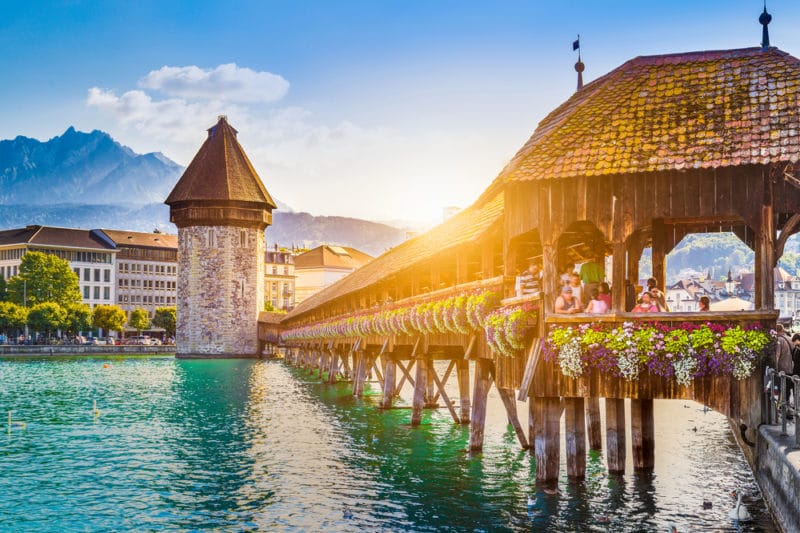
Nestled between the Swiss Alps , this town offers the chance to have a city trip while being surrounded by stunning nature. That is also why I preferred Lucerne over Zurich for this itinerary.
After exploring the old town (and the famous Chapel Bridge) and marveling at the unique and historic buildings, you can add a mountain excursion for the afternoon.
THINGS TO DO IN LUCERNE
- Explore the old town
- Pass Chapel Bridge
- Visit Lion Monument
- Enjoy the Views from Mount Rigi
- Spend time in Mount Pilatus
- Here are more Lucerne travel tips
INTERLAKEN / JUNGFRAU – 3 DAYS
Then it is time to head to the final destination – may I introduce you to my most favorite area in the world?
The train ride , or drive, from Lucerne to Interlaken is scenic. If you take the train, make sure to take the Luzern-Interlaken Express (not all train rides have the same route and the Express trains are normally the most scenic ones).
If you road trip, plan in some time at Brüning Pass and have a cold drink while parking your car and enjoying the views.
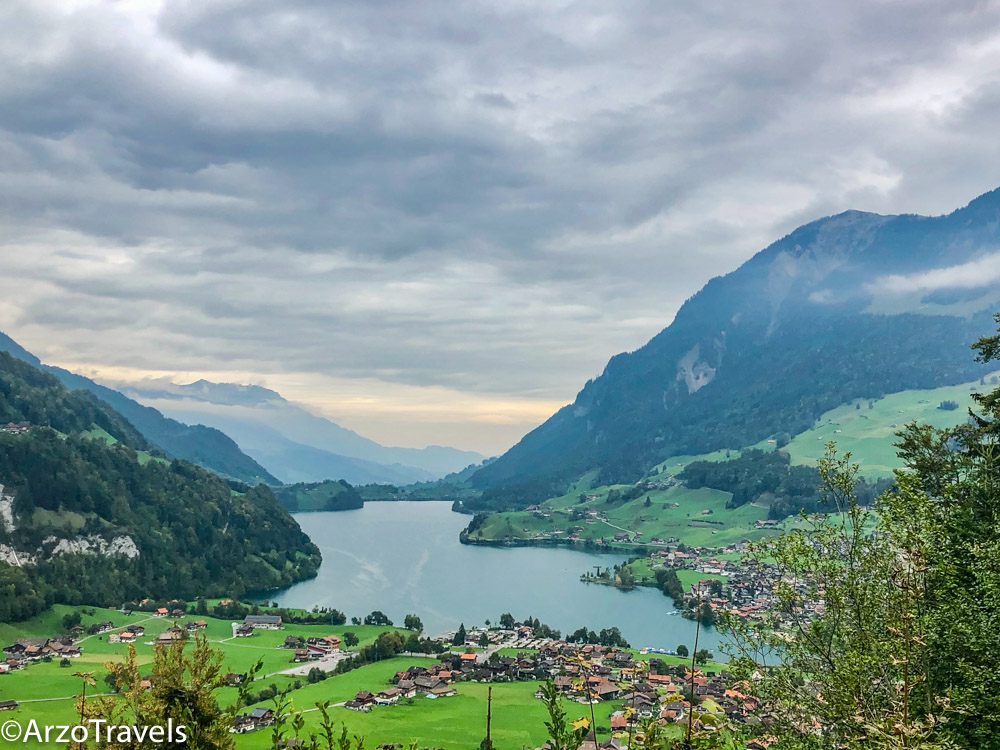
Then spend the rest of your time in one of the most unique destinations in the world, where you will have an abundance of stunning lakes, mountain peaks, cute towns and villages, and more. Yes, I meant Interlaken.
There is surely no shortage of activities. And while Interlaken itself is cute, the scenery is actually what makes this place amazing.
I have spent many weeks in Interlaken – and I am sure, I will never tire. Check out my post on top activities to do in Interlaken for more tips.
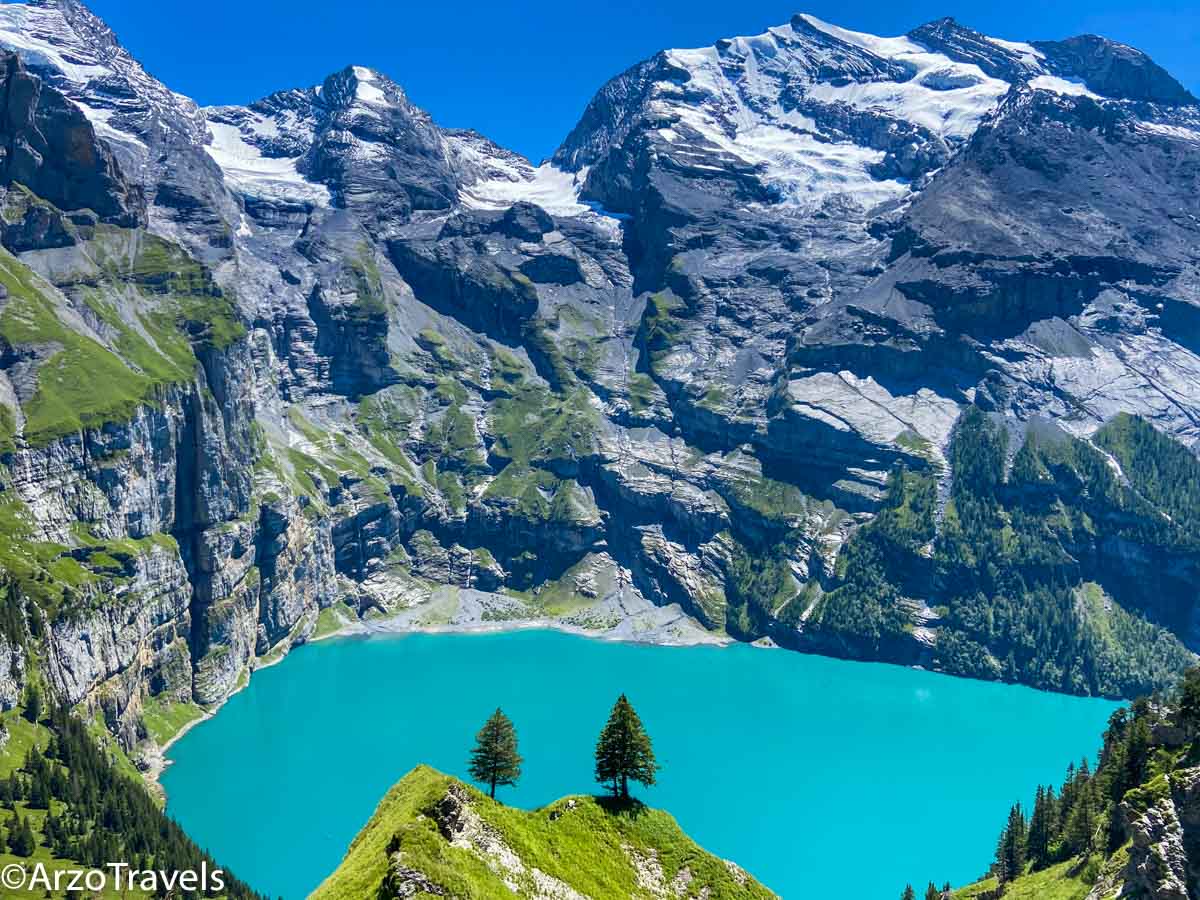
THINGS TO DO IN INTERLAKEN IN 4 DAYS
- Visit Oeschinensee (see picture) above
- Explore Thun and Lake Thun
- Go up Brienzer Rothorn and Lake Brienz
- Explore Lautrebrunnen
- more tips for Interlaken
With that itinerary, you will see some of the most beautiful places in Germany and Switzerland in only 7 days.
10 DAYS IN SWITZERLAND AND GERMANY ITINERARY
- Munich – 1,5 Day
- Eibsee or Rothenburg ob der Tauber – 1 Day
- Zurich – 1 Day
- Lucerne – 1,5 Day
- Interlaken – 3,5 Days
Travel time is around 12 hours (with Eibsee) in total or 17 hours (Rothenburg ob der Tauber)
ROTHENBURG OB DER TAUBER – 1 DAY
Rothenburg ob der Tauber is north of Munich and also further away from Switzerland. However, this detour is actually well worth it.
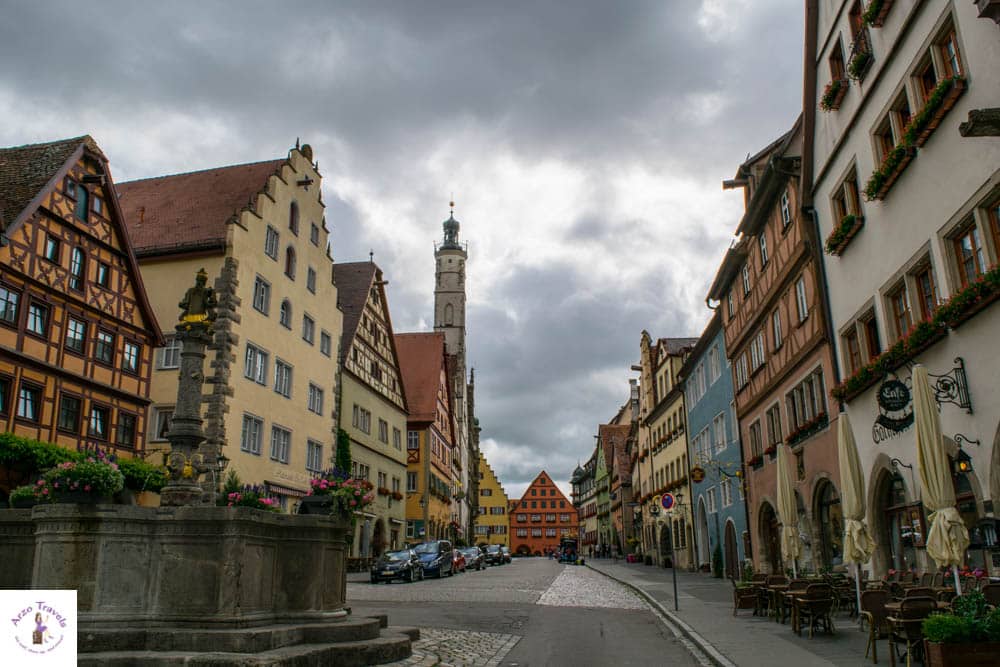
Rothenburg is one of the best-preserved medieval towns in Germany. What this actually means is that the old buildings are picture-perfect, and since Rothenburg is small, you can do quite a lot in half a day or a full day.
If you do not want to take the detour (which is somehow understandable since it takes about 2,5-3 hours one way) then I suggest heading to Eibsee which is Germany´s prettiest lake close to Neuschwanstein Castle.
THINGS TO DO IN ROTHEBURG OB DER TAUBER
- Stroll the old town
- Walk Around the Old Walls
- Visit the Christmas Museum
- Have a Coffee at Cafe Einzigartig
- Check out more travel tips for Rothenburg
EIBSEE & ZUGSPITZE – 1 DAY
Located right at the foot of Zugspitze mountain it is a perfect place to explore what the German Alps have to offer.
Just walk around the Eibsee and have a picnic.

You have amazing mountain peaks in Switzerland but if you want to enjoy views from Germany´s highest mountain, Zugspitze, then you can also take a cable car to get up or hike up.
Tip: If you visit Eibsee and Füssen/Neuschwanstein Castle, I suggest visiting Eibsee first and then go to Neuschwanstein Castle.
ZURICH – 1 DAY
In Switzerland, I suggest adding Zurich to your itinerary for one day.
It will be the first stop in Switzerland coming from Germany. While I normally recommend staying 2 days in Zurich, one day is good to see the main sights.

Though Zurich is not the capital of Switzerland, it is the busiest and biggest city with the most expensive shopping street in the world (Bahnhofstrasse), a beautiful lake, and an old town that you should not miss during your day there.
THINGS TO DO IN ZURICH:
- Stroll Bahnhofsstrase
- Swim in Lake Zurich (and do a boat Cruise)
- Enjoy the views from Lindenallee
- Explore the Old Town
- Find more travel tips for Zurich here
After that, head to Lucerne and follow the itinerary I talk about for 7 days.
GERMANY AND SWITZERLAND FOR 14 DAYS
This 2-week itinerary will allow you to visit even more places in Germany, as well as in Switzerland. So, compared to the 10-day itinerary, you will have 2 new destinations and can spend 2 full days in Lucerne and Munich.
Also, you can give yourself more time to enjoy the actual traveling, as road tripping and train travel (at least in Switzerland) give you the option to enjoy the breathtaking scenery, and you can take some rest and just soak in the beauty.
- Berlin – 1,5 Days
- Munich – 1,5 Days
- Appenzellerland – 1 Day
- Lucerne – 2 Days
BERLIN – 1,5-2 DAYS
Berlin is new on the 2-week itinerary. Germany´s capital is for sure an interesting place to visit. But it is located quite far up north, and with 10 days in both countries, you would stress yourself out too much by adding it to a shorter itinerary.
However, with 14 days, start your itinerary in Berlin and spend 1,5-2 days there.
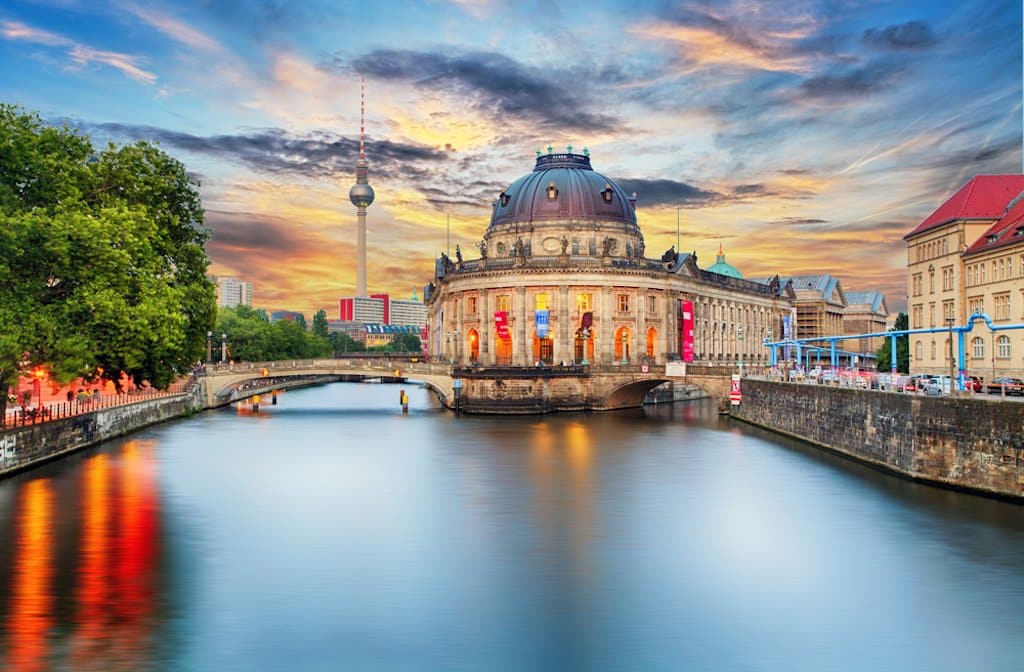
It is quite a big city, but thanks to good public transportation, you can get around easily and see some of the best places in a short time.
Then either take a train to Munich or drive south (it is a rather long train ride, which takes around 6 hours) and stop in Rothenburg first before continuing your trip to Munich.
Tip: If you plan to rent a car, I suggest renting the car after your time in Berlin and not driving in the city itself. Even though taking a plane from Berlin to Munich may sound better at first, you will not save tons of time considering that the airport in Munich is very far from the city center, and then add in all the check-in times, etc.
THINGS TO DO IN BERLIN
- Visit Brandenburger Tor
- Head to Reichstag
- Visit the Holocaust Memorial
- Check out…Checkpoint Charlie
- Stroll Gendarmenmarkt
- Here are more travel tips for Berlin
APPENZELLERLAND – 1 DAY
Appenzellerland has become popular because of the stunning mountain restaurant, the Aescher. However, it is not on many Switzerland itineraries though it should be.
The Aescher is a mountain restaurant located on Ebenalp Mountain in the Alpstein area.
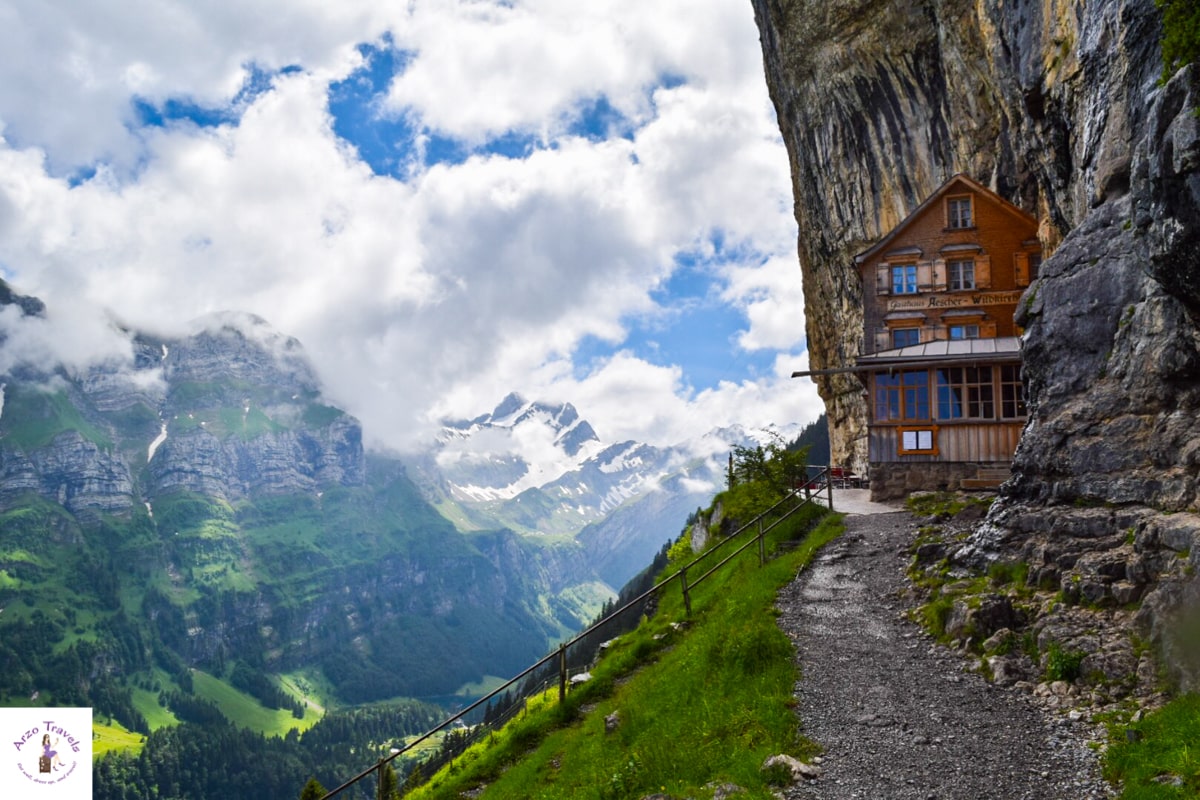
It is a unique destination and it is quite easy to get there (okay, only by cable car, if you hiked it would take 1-2 hours but it is quite steep).
On your way up – or down – make sure to also see Seealpsee (a beautiful mountain lake) and rest before continuing your journey.
You can either stay overnight at a guest house, which is located even higher than the Aescher, or you can book a room in the cute and colorful village of Appenzell.
I have added Appenzellerland to this itinerary because the landscape is different from many other places in Switzerland . Personally, it felt that no hills and mountains are greener and lusher than here, which makes driving here even more fun.
From there, continue your trip to Zurich and add the places mentioned above.
THINGS TO DO IN APPENZELLERLAND
- Have lunch at the Aescher
- Hike Up Ebenalp Mountain Guest House
- Rest at Seealpsee
- Explore Appenzell town center
- More travel tips for Appenzellerland
CREATING A PERFECT SWITZERLAND & GERMANY ITINERARY
As you can see, you can combine your Switzerland and Germany trips quite easily. That surely will not be the most budget-friendly trip you can take, but it is a trip to remember!
And if you can make it happen, try to visit Switzerland and Germany for 14 days or at least 10 days.
Thanks to good public transportation in both countries you can just lay back and enjoy window views while getting around or you can rent a car and explore both countries by car. Either way, it surely will be fun!

Pin It on Pinterest
Security Alert May 17, 2024
Worldwide caution, update may 10, 2024, information for u.s. citizens in the middle east.
- Travel Advisories |
- Contact Us |
- MyTravelGov |
Find U.S. Embassies & Consulates
Travel.state.gov, congressional liaison, special issuance agency, u.s. passports, international travel, intercountry adoption, international parental child abduction, records and authentications, popular links, travel advisories, mytravelgov, stay connected, legal resources, legal information, info for u.s. law enforcement, replace or certify documents.
Before You Go
Learn About Your Destination
While Abroad
Emergencies
Share this page:
Travel Advisory May 1, 2024
Germany - level 2: exercise increased caution.
Reissued after periodic review with minor edits
Exercise increased caution in Germany due to terrorism .
Country Summary: Terrorist groups keep planning attacks in Germany. Terrorists may attack with little or no warning. They target tourist locations and transportation hubs. They also target markets/shopping malls and local government facilities. They target hotels, clubs, and restaurants. They also attack places of worship, parks, and major sporting and cultural events. They target schools, airports, and other public areas.
Read the country information page for additional information on travel to Germany.
If you decide to travel to Germany:
- Be aware of your surroundings when traveling to tourist locations and crowded public venues.
- Follow the instructions of local authorities.
- Monitor local media for breaking events and adjust your plans based on new information.
- Enroll in the Smart Traveler Enrollment Program ( STEP ) to receive Alerts and make it easier to locate you in an emergency.
- Follow the Department of State on Facebook and Twitter .
- Review the Country Security Report for Germany.
- Visit the CDC page for the latest Travel Health Information related to your travel.
- Prepare a contingency plan for emergency situations. Review the Traveler’s Checklist .
Embassy Messages
View Alerts and Messages Archive
Quick Facts
Three months beyond planned date of departure from the Schengen area.
Not required for stays under 90 days.
10,000€ (euros or equivalent).
Embassies and Consulates
U.S. EMBASSY BERLIN Clayallee 170 14191 Berlin Federal Republic of Germany Telephone: +(49) (30) 8305-0 Emergency After-Hours Telephone: +(49) (30) 8305-0 Fax: +(49) (30) 8305-1050 Email: [email protected]
U.S. CONSULATE GENERAL FRANKFURT Giessener Str. 30 60435 Frankfurt am Main Federal Republic of Germany Telephone: +(49) (69) 7535-0 Fax: +(49) (69) 7535-2252 Passport, Consular Report of Birth Abroad, and Citizenship: [email protected] All other questions: [email protected]
U.S. CONSULATE GENERAL MUNICH Koeniginstrasse 5 80539 Munich Federal Republic of Germany Telephone: +(49) (89) 2888-575 Emergency After-Hours Telephone: +(49) 89-2888-0 Fax: If you need to send a fax, please email first to obtain a one-time use fax number. Email: [email protected]
U.S. CONSULATE GENERAL DUSSELDORF Willi-Becker-Allee 10 40227 Duesseldorf Federal Republic of Germany Telephone: +(49) (69) 7535-0 Emergency After-Hours Telephone: +(49) (30) 8305-0 Fax: +(49) (69) 7535-2252 Consular services are provided through the U.S. Consulate in Frankfurt.
U.S. Consulate General Hamburg Kehrwieder 8 20457 Hamburg Federal Republic of Germany Telephone: +(49) (30) 8305-0 Emergency After-Hours Telephone: Contact the U.S. Embassy in Berlin: +(49) (30) 8305-0 Fax: +(49) (30) 8305-1050 Consular services are provided through the U.S. Embassy in Berlin.
U.S. Consulate General Leipzig Wilhelm-Seyfferth-Str. 4 04107 Leipzig Federal Republic of Germany Telephone: +(49) (30) 8305-0 Emergency After-Hours Telephone: Contact the U.S. Embassy in Berlin: +(49) (30) 8305-0 Fax: +(49) (30) 8305-1050 Consular services are provided through the U.S. Embassy in Berlin.
Destination Description
See the Department of State’s Fact Sheet on Germany for information on U.S. - Germany relations.
Entry, Exit and Visa Requirements
Traveling Through Europe : If you are planning to visit or travel through European countries, you should be familiar with the requirements of the Schengen Agreement.
- In Europe's Schengen area , your passport generally must be valid for at least six months at the time of your entry. Although Germany only requires travelers to have three months of validity remaining beyond their intended departure date, airlines may still deny boarding for having less than six months validity, especially if transiting additional Schengen countries.
- If you plan on transiting a Schengen country, review our U.S. Travelers in Europe page .
- You will need sufficient proof of funds and a return plane ticket .
- For additional information about visas for the Schengen area, see the Schengen Visa page.
- If traveling with prescription medication, review the information below regarding pharmaceuticals to avoid potential fines and confiscation.
Carry identification with you at all times.
The U.S. Department of State is unaware of any HIV/AIDS entry restrictions for visitors to, or foreign residents of, Germany.
Find information on dual nationality , prevention of international child abduction and customs regulations on our websites.
Safety and Security
Terrorism: Credible information indicates terrorist groups continue plotting possible attacks in Europe. European governments are taking action to guard against terrorist attacks; however, all European countries remain potentially vulnerable to attacks from transnational terrorist organizations.
Terrorist groups and those inspired by such organizations are intent on attacking U.S. citizens abroad. Terrorists are increasingly using less sophisticated methods of attack –including knives, firearms, and vehicles – to more effectively target crowds. Frequently, their aim is unprotected or vulnerable targets, such as:
- High-profile public events (sporting contests, political rallies, demonstrations, holiday events, and celebratory gatherings)
- Hotels, clubs, and restaurants frequented by tourists
- Places of worship
- Schools
- Shopping malls and markets
- Public transportation systems (including subways, buses, trains, and scheduled commercial flights)
For more information, see our Terrorism page.
Crime: Violent crime is rare in Germany, but can occur, especially in larger cities or high-risk areas such as on large metropolitan subway systems and in train stations, primarily during late night or early morning hours. Most incidents of street crime involve the theft of unattended items and pickpocketing. Theft and pickpocketing primarily take place at train stations, on public transportation, at tourist attractions, and at large public events. Always pay close attention to your valuables!
Be cautious and aware of your surroundings.
U.S. citizens should exercise caution when congregating in known expatriate hangouts.
Don’t buy counterfeit and pirated goods, even if they are widely available. They are illegal to bring back into the United States, and you could also be breaking local law.
Demonstrations: Demonstrations occur regularly in Germany. Large, public demonstrations take place for a variety of political and economic issues. Demonstrations tend to take place on politically significant holidays like German Labor Day (May 1) and during international summits hosted in Germany. Demonstration organizers must obtain prior police approval, and police routinely oversee participants.
- Demonstrations can be unpredictable; avoid areas around protests and demonstrations.
- Check local media for updates and traffic advisories.
- Strikes may interfere with travel plans. We strongly encourage travelers to check transportation schedule information prior to travel.
International Financial Scams: See the Department of State and the FBI pages for information.
Internet romance and financial scams are prevalent in Germany. Scams are often initiated through Internet postings/profiles or by unsolicited emails and letters. Most scammers pose as U.S. citizens who have no one else to turn to for help.
Tips to avoid scammers:
- Look for red flags like their location is far away, their profile was recently created or seems to be too good to be true, the pace of the relationship is moving too quickly, or they ask for money.
- Set up a phone call/video chat in the initial stages.
- Do a reverse image search on the profile picture.
- If they ask for help, you should refer to them to the closest U.S. Embassy or Consulate so we can work with local authorities to assist.
- If you believe you have been scammed, report the incident to local law enforcement right away and stop all communications with the scammer.
Common scams include:
- Romance/online dating
- Money transfers
- Lucrative sales
- Gold purchase
- Contracts with promises of large commissions
- Grandparent/relative targeting (kidnapping, arrested, medical emergency)
- Free Trip/luggage
- Inheritance notices
- Work permits/job offers
- Bank overpayments
Technology Usage Abroad: Mobiles Devices are vulnerable to compromise, theft, and physical damage anywhere in the world. Best practices prior to traveling abroad are keeping all software (operating system and apps) updated and using virtual private network and encrypted voice over IP (VoIP) applications if possible. Make sure that all VPN/VoIP are reputable, and U.S.-based. Do not connect to unknown open Wi-Fi. GPS Navigation Apps are helpful in getting U.S. citizens around in a foreign country. Prior to using the GPS app, make sure you research the route to make sure it is safe. GPS navigation app may give you the shortest route without safety consideration. Be cautious of using dating apps/online dating websites abroad as U.S. citizens can be targeted by scammers. Make sure to inform your friends and family of your whereabouts, meet at a well-known public location, and not consume suspicious food or drinks. Avoid traveling alone to bars or nightclubs.
Victims of Crime: Report crimes to the local police: in an emergency dial 112 for ambulance and 110 for the police and contact the U.S Embassy or nearest U.S. Consulate (see contact details above).
Remember that local authorities are responsible for investigating and prosecuting crimes.
See our webpage on help for U.S. victims of crime overseas .
We can:
- Help you find appropriate medical care
- Assist you in reporting a crime to the police
- Contact relatives or friends with your written consent
- Provide general information regarding the victim’s role during the local investigation and following its conclusion
- Provide a list of local attorneys
- Provide information on victim’s compensation programs in the United States
- Provide information on victim’s compensation and support in Germany
- Provide an emergency loan for repatriation to the United States and/or limited medical support in cases of destitution
- Help you find accommodation and arrange flights home
- Replace a stolen or lost passport
We also maintain information on our website on how to report child abuse situations to the local authorities.
Domestic Violence: U.S. citizen victims of domestic violence may contact the Embassy or the Consulates General in Frankfurt or Munich for assistance. Call 110 if you are in immediate danger.
Tourism: The tourism industry is generally well regulated, and rules are regularly enforced. Hazardous areas/activities are identified with appropriate signage, and professional staff is typically on hand in support of organized activities.
Germany sometimes experiences extreme weather conditions including floods, long periods of drought, and unusually harsh winters with vast amounts of snow even in urban areas. Numerous injuries and deaths occur every year in Germany’s Alpine and coastal regions. Most of the emergencies relate to the following sports: skiing, hiking, snowboarding, mountain biking, sledding, rock and mountain climbing, paragliding, and swimming. Those engaging in Alpine sports are strongly encouraged to register with German “Alpen Verein.”
In the event of an injury, appropriate medical treatment is widely available throughout the country. Outside of a major metropolitan center, it may take more time for first responders and medical professionals to stabilize a patient and provide life-saving assistance. U.S. citizens are encouraged to purchase medical evacuation insurance. See our webpage for more information on insurance providers for overseas coverage.
Local Laws & Special Circumstances
Criminal Penalties: You are subject to local laws. If you violate local laws, even unknowingly, you may be expelled, arrested, or imprisoned. Individuals establishing a business or practicing a profession that requires additional permits or licensing should seek information from the competent local authorities, prior to practicing or operating a business.
Furthermore, some laws are also prosecutable in the United States, regardless of local law. For examples, see our website on crimes against minors abroad and the Department of Justice website.
Arrest Notification: If you are arrested or detained, ask police or prison officials to notify the U.S. Embassy or nearest U.S. Consulate General immediately. See our webpage for further information.
Special Circumstances: Germany has strict customs regulations concerning:
- Temporary importation or exportation of firearms
- Military artifacts (particularly those of World War II)
- Medications/pharmaceuticals
- Business equipment
Under German law it is also illegal to bring into or take out of Germany any literature, music, or paraphernalia that glorifies fascism, the Nazi past, or the “Third Reich.”
Contact the German Embassy in Washington or one of the German consulates in the United States for specific information regarding customs requirements.
Faith-Based Travelers : See our following webpages for details:
- Faith-Based Travel Information
- International Religious Freedom Report – see country reports
- Human Rights Report – see country reports
- Hajj Fact Sheet for Travelers
- Best Practices for Volunteering Abroad
International Volunteers:
LGBTQI+ Travelers : There are no legal restrictions on same-sex sexual relations or the organization of LGBTQI+ events in Germany. Same-sex marriage is available in Germany. LGBTQI+ persons are protected by federal anti-discrimination laws, and LGBTQI+ Pride events are officially encouraged by most large city governments, including those in Berlin, Cologne, Hamburg, Frankfurt, and Munich.
See our page and section 6 of our Human Rights report for further details.
Travelers with Disabilities: The law in Germany prohibits discrimination against persons with disabilities, and the law is enforced. Social acceptance of persons with disabilities in public is as prevalent as in the United States. Expect accessibility to be limited in some older public transportation, lodging, and general infrastructure, especially outside major cities, but common in most urban infrastructure. Some older buildings and public transportation systems are less adapted to individuals with disabilities.
Check your hotel or destination to learn more about options to accommodate disabled traveler needs before visiting Germany.
The German National Tourist Board maintains information about accessibility and disability-friendly travel .
All German airports and Lufthansa offer services for disabled travelers.
The German National Railway, Deutsche Bahn , maintains a mobility resource webpage.
Students: See our Students Abroad page and FBI travel tips .
Women Travelers: See our travel tips for Women Travelers .
Germany has generally high-quality medical care and facilities. Prescript ion and over-the-counter medicines are widely available although brands and drug names differ from those available in the United States.
For emergency services in Germany, dial 112.
Ambulance services are widely available.
We highly recommend that all travelers review the U.S. Centers for Disease Control and Prevention’s Travelers’ Health webpage and general Traveler Advice for Germany.
- Review all sub-sections including the Travel Health Notices, Vaccines and Medicines, Non-Vaccine-Preventable Diseases, Stay Healthy and Safe, Healthy Travel Packing List, and After Your Trip.
- Reasons for Travel (for example: Adventure Travel, Spring Break Travel)
- Travelers with Special Considerations (for example: Allergies, Long-Term Travelers, and Expatriates)
- General Tips (for example: Traveling with Medications, Travel Vaccines)
The Department of State, U.S. embassies and U.S. consulates general do not pay medical bills. Be aware that U.S. Medicare/Medicaid does not apply overseas. Most hospitals and doctors overseas do not accept U.S. health insurance. If you are not a resident of Germany, doctors and hospitals will expect immediate payment in cash.
Medical Insurance: Make sure your health insurance plan provides coverage overseas or purchase travel insurance for this purpose. Most care providers overseas only accept cash payments. See our webpage for more information on insurance coverage overseas. Visit the U.S. Centers for Disease Control and Prevention for more information on the type of insurance you should consider before you travel overseas.
The Department of State strongly recommends supplemental insurance to cover medical evacuation.
Always carry your prescription medication in original packaging, along with your doctor’s prescription. Check with the German Federal Institute for Drugs and Medical Devices to ensure the medication is legal in Germany. Also read the information below regarding pharmaceuticals and the documentation required to enter Germany with prescription medication.
Vaccinations: Be up to date on all vaccinations recommended by the U.S. Centers for Disease Control and Prevention.
Further health information:
- World Health Organization
- U.S. Centers for Disease Control and Prevention (CDC)
Air Quality: Visit AirNow Department of State for information on air quality at U.S. Embassies and Consulates.
Air quality varies considerably and fluctuates with the seasons. It is typically at its worst in the winter. People at the greatest risk from particle pollution exposure include:
- Infants, children, and teens
- People over 65 years of age
- People with lung disease such as asthma and chronic obstructive pulmonary disease (COPD), which includes chronic bronchitis and emphysema
The U.S. Embassy and Consulates General maintain lists of doctors and medical services in Germany . We do not endorse or recommend any specific medical provider or clinic.
Medical Tourism and Elective Surgery
- Medical tourism is a rapidly growing industry. People seeking health care overseas should understand that medical systems operate differently from those in the United States and are not subject to the same rules and regulations. Anyone interested in traveling for medical purposes should consult with their local physician before traveling and visit the U.S. Centers for Disease Control and Prevention website for more information on Medical Tourism.
- Visit the U.S. Centers for Disease Control and Prevention website for information on Medical Tourism, the risks of medical tourism, and what you can do to prepare before traveling to Germany.
- We strongly recommend supplemental insurance to cover medical evacuation in the event of unforeseen medical complications.
Pharmaceuticals
- If traveling with prescription medication, visit the German customs website to ensure the medication is legal in Germany. For medications that Germany classifies as narcotics, you may only carry a 30-day supply. A comprehensive list of these medications can be found here. If your medication is on that list, there is an additional requirement for your doctor to complete a certification form . You will see part E asks for the endorsement of an “issuing authority.” As there is no such authority in the United States, travelers may have the doctor self-certify the form and enter the information of his or her practice in part E, ideally with a stamp or seal from their office. Due to Germany’s strict customs regulations, you are not allowed to receive prescription medication by mail without special permission. Always carry your prescription.
- Exercise caution when purchasing medication overseas. Medication should be purchased in consultation with a medical professional and from reputable establishments.
- U.S. Customs and Border Protection and the Food and Drug Administration are responsible for rules governing the transport of medication back to the United States. Medication purchased abroad must meet their requirements to be legally brought back into the United States. Medication should be for personal use and must be approved for usage in the United States. Please visit the U.S. Customs and Border Protection and the Food and Drug Administration websites for more information.
Assisted Reproductive Technology and Surrogacy
If you are considering traveling overseas to have a child through use of assisted reproductive technology (ART) or surrogacy, please see our ART and Surrogacy Abroad page .
- All surrogacy arrangements, as well as IVF procedures involving the use of donated eggs, are illegal in Germany. For additional information, see this webpage of the German Foreign Ministry (German language only).
Adventure Travel: Visit the U.S. Centers for Disease Control and Prevention website for more information about Adventure Travel .
Travel and Transportation
Road Conditions and Safety: Road conditions in general are excellent but can differ from those in the United States, but driver error is a leading cause of accidents involving U.S. citizen motorists in Germany.
If you hold a valid U.S. driver’s license, you can drive in Germany for up to six months without acquiring a German driver’s license. Many German traffic laws and traffic signs differ significantly from those in the United States. For more information, please visit the U.S. embassy’s webpage on driving in Germany .
Speed limits are posted on large stretches of the highway, on the Autobahn in urban areas, and when the road has many curves. Although high speeds are permitted on the Autobahn, adverse weather conditions and unfamiliar road markings pose significant hazards. Speed limits are strictly enforced. Use of seat belts is mandatory in front and back seats. Do not park on bike paths or sidewalks. Your vehicle registration, insurance policy, a first-aid kit, a reflective vest, and a reflective triangle must be in your vehicle at all times. In snowy or icy conditions, your vehicle must have snow tires or all-season tires (indicated by M+S marking) or you will be subject to a fine.
Bicycles: German streets and sidewalks have dedicated bike lanes. Bicycles have priority use of bike lanes over pedestrians and automobiles. Bicyclists also have priority over cars when turning onto side streets. If you are driving, check whether a bicyclist is approaching from either direction before attempting to enter side streets, even when the light is in your favor. You will be held responsible for any injury or damage caused if you turn into a side street and hit a bicyclist using a marked bike lane. If you are walking, watch for bicyclists before crossing or stepping into bike lanes.
Traffic Laws: If you are involved in a traffic accident in Germany, even a minor fender-bender, you MUST stay with your vehicle and not leave the scene until police arrive to take a report. It is illegal to use your cell phone while driving in Germany. Except on priority roads, vehicles coming from the right have the right-of-way. It is generally illegal in Germany to pass vehicles on the right. Germans strictly observe the ‘slower traffic keep right’ rule. It is illegal to operate a vehicle if your blood alcohol level is 0.05% or higher. You may be fined, and your driver’s license may be suspended for specified periods of time, depending upon the gravity of each violation.
Public Transportation: Germany has an extensive and safe public transportation network consisting of buses, streetcars, trains, and subways. Metered taxis are also prevalent throughout Germany. Uber and other rideshare companies are available in most cities in Germany. Use common sense safety practices such as guarding valuables and remaining aware of your surroundings on all public transportation.
Strikes in Germany may disrupt public transportation and travel plans. We strongly encourage travelers to check transportation schedule information prior to travel.
See our Road Safety page for more information. Visit the website of Germany’s Federal Ministry for Digital and Transport (BMVI) , the national authority responsible for road safety.
Aviation Safety Oversight: The U.S. Federal Aviation Administration (FAA) has assessed the government of Germany’s Civil Aviation Authority as compliant with International Civil Aviation Organization (ICAO) aviation safety standards for oversight of Germany’s air carrier operations. Further information may be found on the FAA’s safety assessment page .
Maritime Travel: Mariners planning travel to Germany should also check for U.S. maritime advisories and alerts . Information may also be posted to the U.S. Coast Guard homeport website , and the NGA broadcast warnings.
For additional travel information
- Enroll in the Smart Traveler Enrollment Program (STEP) to receive security messages and make it easier to locate you in an emergency.
- Call us in Washington, D.C. at 1-888-407-4747 (toll-free in the United States and Canada) or 1-202-501-4444 (from all other countries) from 8:00 a.m. to 8:00 p.m., Eastern Standard Time, Monday through Friday (except U.S. federal holidays).
- See the State Department’s travel website for the Worldwide Caution and Travel Advisories .
- Follow us on Twitter and Facebook .
- See traveling safely abroad for useful travel tips.
Review information about International Parental Child Abduction in Germany . For additional IPCA-related information, please see the International Child Abduction Prevention and Return Act ( ICAPRA ) report.”
Travel Advisory Levels
Assistance for u.s. citizens, germany map, learn about your destination, enroll in step.

Subscribe to get up-to-date safety and security information and help us reach you in an emergency abroad.
Recommended Web Browsers: Microsoft Edge or Google Chrome.
Check passport expiration dates carefully for all travelers! Children’s passports are issued for 5 years, adult passports for 10 years.
Afghanistan
Antigua and Barbuda
Bonaire, Sint Eustatius, and Saba
Bosnia and Herzegovina
British Virgin Islands
Burkina Faso
Burma (Myanmar)
Cayman Islands
Central African Republic
Cote d Ivoire
Curaçao
Czech Republic
Democratic Republic of the Congo
Dominican Republic
El Salvador
Equatorial Guinea
Eswatini (Swaziland)
Falkland Islands
France (includes Monaco)
French Guiana
French Polynesia
French West Indies
Guadeloupe, Martinique, Saint Martin, and Saint Barthélemy (French West Indies)
Guinea-Bissau
Isle of Man
Israel, The West Bank and Gaza
Liechtenstein
Marshall Islands
Netherlands
New Caledonia
New Zealand
North Korea (Democratic People's Republic of Korea)
Papua New Guinea
Philippines
Republic of North Macedonia
Republic of the Congo
Saint Kitts and Nevis
Saint Lucia
Saint Vincent and the Grenadines
Sao Tome and Principe
Saudi Arabia
Sierra Leone
Sint Maarten
Solomon Islands
South Africa
South Korea
South Sudan
Switzerland
The Bahamas
Timor-Leste
Trinidad and Tobago
Turkmenistan
Turks and Caicos Islands
United Arab Emirates
United Kingdom
Vatican City (Holy See)
External Link
You are about to leave travel.state.gov for an external website that is not maintained by the U.S. Department of State.
Links to external websites are provided as a convenience and should not be construed as an endorsement by the U.S. Department of State of the views or products contained therein. If you wish to remain on travel.state.gov, click the "cancel" message.
You are about to visit:
Navigate to myswitzerland.com
Destinations
Your swiss holiday time.
Holiday destinations
- Summer holiday destinations
- Winter sports & ski resorts
- Family destinations
Attractions
- Top attractions
- UNESCO World Heritage sites / biospheres
- Travel by train, bus or boat
- Top museums
- Swiss Parks
- Scenic nature
Experiences
Additional content about subnavigation experiences.
- Family excursions
- Food & Wine
- Group excursions
- Guided tours
Summer & Autumn
- Bicycle & Mountain bike
- Adventure & Sports Summer
- Zoo & animal experiences
- Ski and snowboard
- Cross-country skiing
- Snowshoe and winter hiking
- Tobogganing
- Winter excursions
- Christmas in Switzerland
Cities & culture
- Parks, Gardens and Squares
- Architecture
Experience Tour
- Car, motorcycle - Grand Tour
- Train, bus, boat – Grand Train Tour
- Mountain excursions
Accommodation
- Typically Swiss Hotels
- Wellness & Spa
- Family Hotels
- Bike Hotels
- Boutique Hotels
- Inspiring Meeting Hotels
- Swiss Historic Hotels
- Luxury hotels
- Winter sports hotels
Other types of accommodation
- On the farm
- Bed and Breakfast
- Mountains huts
- Group accommodation
Transport & Stay
- Travel to Switzerland
- Barrier-free travel
- Tickets public transport
- Service & support
- Money and shopping
About Switzerland
- General facts
- Custom and tradition
- History of Switzerland
- The Swiss Art and Culture Scene
- Health Travel
- Sustainability
Weather & Climate
- Climate in Switzerland
- Snow Report
- Water and pool temperatures
- City offers
- Touring offers
- Wellness offers
- Nature and outdoor offers
- Offers for families
Where are you from?
- België (Nederlands)
- Belgique (Français)
- Deutschland
- Netherlands
- Russia (Россия)
- Schweiz (Deutsch)
- Suisse (Français)
- Svizzera (Italiano)
- Switzerland (English)
- United Kingdom
- Canada (English)
- Canada (Français)
- China 中文简体
- China 中文繁体
- Gulf countries العربية
- Japan 日本
- Korea 한국어
- United Arab Emirates
- New Zealand
- International
Language, region and important links
- Slovenština
Service Navigation
- Help & Contact
Covid-19: Travel Conditions
For vacations and travel in Switzerland, you'll find all the current information hereafter.
Clean & Safe
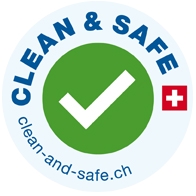
Last update: 22 April 2022 Tourism takes place in Switzerland without restrictions.
- Entry from Schengen / EU / EFTA: possible without restrictions.
- Entry from third countries: With effect from 2 May 2022, all remaining countries are removed from the SEM risk country list. This means that entry into Switzerland from all countries in the world will again be possible as before the pandemic.
Testing in Switzerland
Travel purpose testing: We recommend the test centre at Zurich Airport, information can be found here . Cantonal Test Centers Suppliers of tests in Switzerland
Covid Certificate
In Switzerland there is no Covid certificate, you can move freely without conditions .
Mountain railways
Please contact the service providers directly (online/by phone) for information regarding their business hours and safety protocols.
The mountain railways are operating.
Public transportation.
Informieren Sie sich direkt über die Öffnungen bei den Betreiber auf Ihre Website oder telefonisch
Public transport services are operating.
Air traffic.
Please contact the airlines directly (online/by phone) about the current air traffic situation.
More topics
Winter: excursion tips.
Wide slopes, deep snow, cool halfpipes, awesome cross-country ski trails, varied tobogganing runs and fabulous winter hiking trails – all within quick and easy reach. Switzerland is the ultimate winter paradise.
FOPH recommends a pragmatic approach to the certificate requirements.
COVID testing (COVID antigen speed test) is available for all foreign guests at dedicated test facilities specified by the cantons. Please consult with your hotel or the local tourist office to find a test center. Further information on CoVid-19 testing can be found here .
You can apply for the Swiss COVID certificate using an online form .
- Non EU-certificates can only be converted into a Swiss Covid certificate if people are vaccinated with an EMA approved vaccine (Pfizer, Moderna, Janssen/Johnson&Johnson, AstraZeneca and all licensed vaccine such as Covishield, etc.)
- The cost for the conversion is 30 Swiss Francs per person and has to be paid in advance
- The canton where you will be staying in will issue the certificate
- The processing time can take up to 5 working days
If you have any questions, please contact our service center under: 1-800-794-7795 (free) or via [email protected]
- Switzerland Tourism
- Switzerland Hotels
- Switzerland Bed and Breakfast
- Switzerland Vacation Rentals
- Flights to Switzerland
- Switzerland Restaurants
- Things to Do in Switzerland
- Switzerland Travel Forum
- Switzerland Photos
- All Switzerland Hotels
- Switzerland Hotel Deals
- Last Minute Hotels in Switzerland
- Switzerland
- Things to Do
- Restaurants
- Vacation Rentals
- Travel Stories
- Rental Cars
- Add a Place
- Travel Forum
- Travelers' Choice
- Help Center
Travel itinerary for Switzerland and Germany - Switzerland Forum
- Europe
- Switzerland
Travel itinerary for Switzerland and Germany
- United States Forums
- Europe Forums
- Canada Forums
- Asia Forums
- Central America Forums
- Africa Forums
- Caribbean Forums
- Mexico Forums
- South Pacific Forums
- South America Forums
- Middle East Forums
- Honeymoons and Romance
- Business Travel
- Train Travel
- Traveling With Disabilities
- Tripadvisor Support
- Solo Travel
- Bargain Travel
- Timeshares / Vacation Rentals
- Europe forums
- Switzerland forum

Thanks in advance to the many people who are guiding us here in this forum!
At Switzerland, I’m a little confused and overwhelmed my the many places to see. Basically I’m looking to visit the key places and also ensure my 10 year old son has some fun activities.
Hence my tentative plan is as below:-
14th may—Arrive in Zurich , visit local attractions and possibly the lake.
15th May—Depart to Lucerne and probably keep Lucerne as the base for rest of the trip.
16th May—One day trip to Mt. Titlis .
Now, I have three more days in Switzerland—17,18 & 19.
I have heard people say that it’s good to visit either of Mt.Titlis or Jungfrau . Is this correct? Or is there something im missing out by not visiting Jungfrau?
I also had a look at Zermat, but it seems a bit far from Lucerne. But the scenic glacier express seemed very interesting. Should I move from Lucerne to Zermat for the next 2 days?
Lastly and most importantly, I need to finalise whether I have to fly out from Zurich or Frankfurt. I’m a little apprehensive about Germany now since the vaccination we have taken ( covaxin ) is not recognised by that country and we would need a RT-PCR test to enter the country. So I’m willing to even skip Germany if need be since it’s not must-do in my trip. But if a one day trip to Stuttgart this a possible from Zurich, I’m willing to look at that as well. Alternatively, if I skip Germany, what are the nearby countries I can visit quickly? We have already been to Paris , so that’s off the list.
I understand my itinerary is a bit vague now, but I just urgently need to book my air tickets, so deciding on fly-out city is very urgent.
The 5 day itinerary within Switzerland is flexible as of now and I can decide basis your valuable inputs.
Thanks again!

There is a lot to see and to do at the Lucerne area as you can find out on http://www.luzern.com/en and the Top Questions about Lucerne (Lucerne forum on the TA web site). I do recommend making excursions within the Lucerne area. I am sure your son would like to visit the transport museum at Lucerne - http://www.verkehrshaus.ch/en - and the open-air museum at Brienz - http://www.ballenberg.ch/en -. You would need at least half a day or more for each of these points. Children like to see the lttle zoo at Goldau - http://www.tierpark.ch/en - where dears walk around the visitors in a large part of the park. If he would like to feed them, buy some food on the entrance. Also a visit of the glass factory and museum at Hergiswil am See - http://www.glasi.ch/en - would be great for him. For more places look at the Top Questions about Lucerne.
Yes, Jungfraujoch and Zermatt are to far away from Lucerne for a day excursion and so is the glacier express. If ever the weather would not be as good as we all hope, Berne, our capital, would be a great option - Top Questions about Berne (Berne forum on the TA website) -.
I do not know the requirements of Covid vaccinations in Germany . Maybe you ask there? In any case there is so much to see and to do in Switzerland that I would not move my base away and fly home from Zurich.
By the way, the train ride from Lucerne to Brienz is very scenic. If possible, sit on the right-hand side of the train for better views.
Happy planning
Hello Sujit,
If you love cars , a bit far from Lucerne (but not impossible: 2h 17' by train with 1 change and 12' to wolk from the station), but less from Zurich (just over 1h direct train, thus interesting for the day you arrive?), the Autobau-exhibit in Romanshorn: https://www.autobau.ch/
Look at the weather forecasts the day you arrive ( http://www.meteoswiss.ch ) and plan the Titlis trip for the best weather day!
Thank you so much Pore.
Your feedback has made a lot of things clear.
So here’s what I’m thinking at the moment:-
Day-2–Visit mount Rigi and be back for some local sightseeing at Lucerne
Day-3 mount titlis
Day—4–I’m thinking of taking the Golden pass to montreux. But what else can be done at Montreux ? And I should check out of my hotel from Lucerne and shift base to montreux, right? Or can it be an one day trip from Lucerne?
Also what’s the difference the glacier express and the golden pass? Are they on different routes?
If the golden pass can be done as a day trip from
Lucerne, then I can get back to Lucerne by the end of day-4.
Day-5 & 6—-I have kept my plans open. Any inputs would be great.
I’m sort of hoping that I reach Zurich by the evening of day-6.
So for day 7, I can do that wonderful automobilmuseum at romanshorn and maybe some local sight seeing in Zurich.
Day 8– Depart from Zurich to India.
Your further suggestions would be helpful, thanks again.
Hello finsteraarhorn
Would be great to hear your views on my above plan as well, thanks again.
The goldenpass line is the train from Lucerne to Interlaken (change needed) - Zweisimmen (change needed) - Gstaad - Montreux while the Glacier Express (GE) is operating from Zermatt via Andermatt - Chur to St. Moritz . The GE is to far away from Lucerne and it takes 8 hours. look also on http://www.glacierexpress.ch and http://www.goldenpass.ch .
The goldenpass line will be a long journey but you can do it if you return to Lucerne via Berne.
Days 5 & 6: You have a lot of options, and you can find them on the links you got already.
With a 10 yo son I would in any case not want to miss the transport museum.
For your visit of Romanshorn, you can take the famous Voralpen Express from Lucerne via Herisau to St. Gallen and a local train from there. This is another scenic train ride.
Enjoy your trip
This topic has been closed to new posts due to inactivity.
- Wengen/Murren still worthwhile in very cloudy weather? 12:33 am
- Car Rental Company 11:55 pm
- Lugano Hotel de la paix lugano vs. Suitenhotel Parco Paradis 11:42 pm
- Two week itinerary - appreciate any help or advice 10:37 pm
- 4 days in Switzerland… how’s this plan look? 10:13 pm
- Sept/oct - Complete Train Schedule Confirmation 10:08 pm
- Itinerary and Passes 8:36 pm
- Trip recommendations 8:31 pm
- Biking in Lauterbrunnen with family 8:17 pm
- Train travel Chur to Zermatt help 8:13 pm
- Zurich to Lucerne 8:05 pm
- Lake Brienz/Thun boat on rainy day 7:59 pm
- Which train pass should we get? 7:29 pm
- Itinerary Help 6:43 pm
- best time to visit Switzerland 7 replies
- Best place to visit Switzerland in July 2 replies
- Factory Outlet 5 replies
- Weather in December 4 replies
- Basel to Geneva by Train 8 replies
- Switzerland in december 7 replies
- Switzerland in November 4 replies
- VAT Tax Refund 146 replies
- Swiss Trains 1st Class vs 2nd Class 10 replies
- Cost of food 8 replies
- Information about the Corona Virus (COVID_19) in Switzerland
- [0] How to use these Top Questions
- [1] News & important updates 2022
- [2] Introduction & basic information
- [3] Before you start to planning your trip
- [4] Public transport in Switzerland
- [5] Scenic trains & postal bus routes
- [6] Driving in Switzerland
- [7] Hiking and sightseeing
- [8] Arriving or leaving by Rhine river cruise
- [9] Christmas markets / Christmas / New Year
- [10] Posts and blogs from travelers
- [11] Trip Reports
- [12] Trip Reports (continued)
- [13] Trip Reports (continued)
- [14] Trip Reports (continued)
- Why aren't trains running Spiez/Visp/Brig - Milan in June - September 2024?
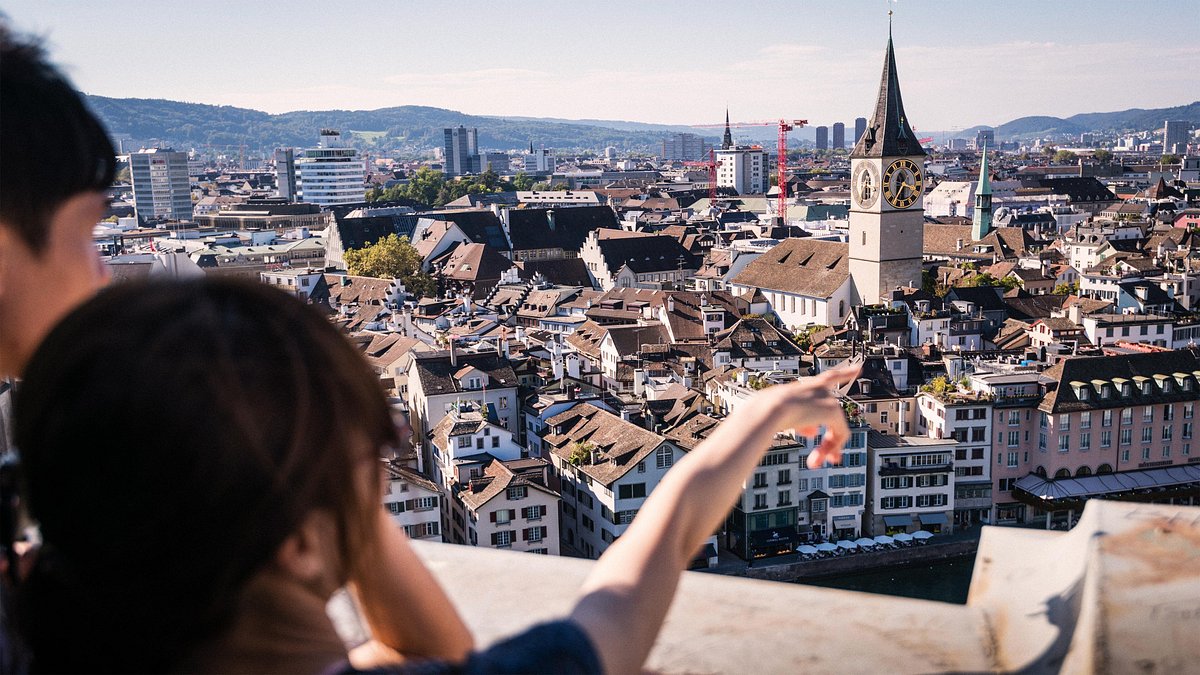
- Go to current travel information
- Go to navigation
- Go to flight search
- Go to main content
- Go to footer

Travel details
Flights from switzerland to germany, fly comfortably and relaxed from switzerland to germany.
Whatever your schedule and budget, whether you're travelling for business or pleasure, you will find that time flies when travelling with SWISS or a SWISS partner airline from Switzerland to Germany. From takeoff to landing, our qualified on-board crew will make sure you can relax and get the most out of the flight.
Enjoy the on-board amenities and typical Swiss hospitality that will make your flight to Germany a real pleasure so you can arrive well rested in Germany and can start your trip full of energy. Book your flight to Germany now on swiss.com.
*Please note: To provide you with the widest possible selection of flight destinations, some of the direct flights or connecting flights on swiss.com are operated by our partner airlines, which may result in a different flight experience than with SWISS.
Important information for your trip

Unlimited access to Lufthansa Group Airlines and Miles & More.

Airport Transfer
Book your transfer now to get up to 10% off.
Online check-in
Check in for your next flight conveniently at home or the office.
Entry regulations worldwide
Enquire about the entry regulations for your destination in good time.
Entry regulations
Discover our destinations.
- Basel - Berlin
- Geneva - Berlin
- Geneva - Frankfurt
- Geneva - Hamburg
- Geneva - Munich
- Zurich - Berlin
- Zurich - Cologne
- Zurich - Dusseldorf
- Zurich - Frankfurt
- Zurich - Munich
- Friedrichshafen
Log in on swiss.com and use your name, booking code, e-ticket number or profile to check in online. Select your seat and then enter the required passport information. You should now be able to print your boarding pass or send it as a mobile ticket to your smartphone. You’ll need to check in your baggage at the designated check-in counter before departure. If you have problems checking in online, you may need to check your device settings. You can also download the SWISS app to check in on the go and view all your travel information. The app is available for both iPhone and Android.
Enjoy fresh, high-quality meals on board our flights. Depending on your travel class and flight duration, a diverse selection of culinary delights awaits you. Choose from our menu options: SWISS First, SWISS Business, SWISS Premium Economy, SWISS Economy or our à la carte menu SWISS Choice. Menus for special dietary requirements are available upon request, and you can create a custom meal up to 36 hours before departure. On board SWISS flights, you can sit back, relax and enjoy gourmet food and drink .
The amount of checked baggage you're allowed to bring as well as the weight of it depends on your flight class. Should you choose to forgo checked baggage altogether for a short trip, please note that space on the aircraft is limited and some items are not permitted on board. If you wish to check in additional baggage, we will accept it for an additional fee. Certain items are considered dangerous and are prohibited or limited in carry-on and checked baggage for security reasons. You should also inquire well in advance about the regulations that apply for transporting sports equipment or other non-traditional items. If you have any problems with your baggage, please contact us immediately so we can solve the problem as quickly as possible. You can find all the important information regarding your baggage in our baggage rules section.
On all long-haul flights, we offer you unlimited access to the free «Messaging» Wi-Fi package. With this, you can stay connected, whether for personal or professional communication, via the most common messenger apps for free throughout the flight, as well as share pictures and photos directly.
For even more variety and an extended internet experience, the «Wi-Fi 4 Hours» or «Wi-Fi Premium» packages are available for a fee. Depending on the package, you receive unlimited internet access for four hours or for the entire flight. This includes, for example, social media, email, audio streaming, VPN, and cloud services. Only video streaming services are not available, regardless of the package chosen.
Our SWISS First guests and HON Circle Members have free access to the «Wi-Fi Premium» package.
The flight from Switzerland to Germany travelling the Zurich - Munich route usually takes 1:25 hours.
On swiss.com we offer flights for the Zurich, Switzerland, - Munich, Germany route from CHF 124.
Flights from Switzerland to Germany depart from Basel, Geneva, Lugano, Lucerne (railway station), Lausanne, Bellinzona, Berne, Fribourg, Interlaken Ost, Zurich
We offer flights from Switzerland to Germany on the Zurich - Munich route on Monday, Tuesday, Wednesday, Thursday, Friday, Saturday, Sunday.
If a flight gets cancelled, we will immediately rearrange the itinerary for all affected travellers. You can view the updated flight details under "My bookings". Our SWISS Chat Assistant Nelly is there to help you if you require assistance.
You are allowed to take a certain amount of checked baggage with you on your flight. The size, weight, and number of items permitted as your checked baggage depends on your fare, route, and frequent flyer status.
Premium Economy Class is our travel class with extra comfort for long-haul flights. Enjoy many benefits such as wider seating with more reclining possibilities for a restful journey.
Your One Stop Shop For Travel Planning
10 day europe itinerary: germany, italy, switzerland + austria.
Want to travel to Europe, but only have 10 days? With this itinerary, you will get to see 4 European countries in as little as 10 days! Germany, Italy, Switzerland and Austria are all very close together, making it super easy to see them all.
This was my first trip abroad without my family, so I opted in for a tour with EF College Break . What was so nice about this tour was that it was all college students, so I made a ton of friends and we did things my age group would enjoy. On top of all that, it was extremely inexpensive for all that we got to see!
If you want to do a tour, I would definitely recommend looking into EF College Break. If you want to explore Europe on your own time, you can still do this itinerary by yourself.
For all the self-guided travelers out there… I have an epic (yes, EPIC) itinerary to France where you will get to see all the highlights. This itinerary is self-guided where you get to see Paris, the French Riviera, Provence, and go champagne tasting in Champagne! You can read my 10 day France itinerary here !
Okay, you ready to read this amazing 10 day Europe Itinerary?!
When to go to Europe?
This is a tricky question that will completely depend on the type of trip you want.
Want to see the alps covered in snow and eat fondue? Winter will be best!
Want to avoid crowds? Early spring and late fall will be best!
Want to enjoy prime weather and loads of events? Summer will be best!
I traveled to Europe in late May and it was absolutely beautiful . The crowds were minimal in comparison to the high seasons of June-August, and the weather was ranging from 60-80 degrees (depending on the country). The crowds in Europe hot-spots (especially Venice) will be unbearably crowded. Before you book during the prime summer months, just take that into consideration!
Tour v. No Tour?
I think it depends on your budget and if you are traveling with someone. I didn’t feel comfortable driving in Europe at 19 years old, so the only other way to see multiple countries would be to take trains or fly, which can add up quick!
I loved this tour group because it was all college age students, so I made friends from all over the world and we did a lot of excursions people my age group would do. Also, this tour company gave us SO much free time so even if the tour doesn’t see everything you want, you still have the time to see it.

Typically, I prefer to do self-guided travels because I can wake up as early as I want to see sights, mix and match what I want to see, eat when I want, etc. Of course there will be more stress planning your own trip abroad, but I think the benefit outweighs the cost!
What to Pack for Summer in Europe?
I keep a list of all my summer essentials and favorite finds on this guide here . I am constantly updated it after every warm destination – tried, true & tested! Also, I have a list of my 10 travel essentials I can’t live without, you can read those here !
As for specific things to pack for Europe, these are my top 3 must-have’s:
1. Travel Adapter
Yes, I know this is a very generic thing for a trip abroad, but this one is AMAZING. It is an all-in-one adapter that works on every country you will ever travel to. This is especially important with this itinerary because Switzerland doesn’t use the same plug as the rest of Europe! Click here for one that includes all of the USA, Europe, Australia and UK!
2. Curling Iron with dual voltage
True story… I was so confused about adapters and converters that I decided to just not buy a converter lol. When I turned on my blow dryer in this little hotel in Switzerland, I shut down the ENTIRE hotel because it burnt the circuits!! If you don’t want to worry about a confusing converter, I would just buy a dual voltage curling iron / blow dryer. This will come in handy on any trip you will ever do! Click here for a dual voltage curling iron.
3. Packing Cubes
Guys, this is so important when you are bouncing around between multiple hotels. Packing cubes saved my LIFE when I did my 10 day France trip because I stayed in three different hotels. Here’s a free tip: Pack the clothes you want to wear in each city (AKA hotel), so that way you only need to take out that cube at that hotel. Most hotels in Europe are super tiny, so saving you room will be a total life saver! PLUS, when you are done wearing those dirty clothes, you can stick them back in the packing cube so they don’t touch your clean clothes! Click here for packing cubes!
BONUS: Anytime I travel to abroad, I always get travel insuranc e so I am covered during my trip. Europe is known for reckless driving and lots of protests, so you want to make sure you have insurance in case of an emergency. Confused on what travel insurance is? I have a lengthy guide that will explain it in great detail !
Itinerary Overview
Day 1: overnight flight.
- Day 2: Munich Sight Seeing
Day 3: Neuschwanstein Castle
- Day 4: Drive to Venice + Lunch in Austria
- Day 5: Explore Venice
- Day 6: Drive to Swizerland + lunch in Verona
- Day 7: Explore Switzerland + Mt. Pilatus
Day 8: Drive to Frankfurt
- Day 9: Explore Frankfurt
- Day 10: Fly home! 🙁
10 Day Europe Itinerary
Hopefully your flight won’t be as long as mine, but usually the entire first day is wasted traveling due to the time change + flight length.
Not being able to sleep on planes makes it feel extra long too. Is anyone else as dorky as me and get too excited to sleep before a vacation?
TIP: Bring Melatonin on your flight to help you sleep! It’s an all-natural vitamin that doesn’t make you feel groggy when you wake up. This also will help you sleep the first few nights you arrive.
Day 2: Arrive in Munich
We arrived at 7am in the morning.. yes. 7am. It was a rough first day because the time zone difference from Las Vegas was a whopping NINE HOURS . The entire day will be spent keeping yourself as busy as possible to fight that jet lag!
Spend your free day in Munich seeing street performers, watching surfing competitions at The Eisbachwelle , strolling through the cities English Garden, and enjoy lunch and German beer at the Hofbrauhaus !
As you can imagine, the Hofbrauhaus is extremely touristy and always busy! It is a HUGE restaurant, but you still might need to wait to be seated. If you do, just spend some time exploring the nearby shops to start your souvenir shopping early 🙂

End your first day in Germany with a Biergarten dinner at Zum Flaucher . There are SO many beirgartens in Germany that have outdoor seating, twinkly lights, picnic style seating and a relaxed atmosphere. Going to these for dinner was one of my favorite memories in Germany, so I would definitely make it a priority to go to one of them!
By far my favorite day out of the entire trip! This castle is unbelievably breathtaking. The Neuschwanstein ( say that ten times fast ) Castle is located less than 2 hours from Munich in a town called Hohenschwangau ( now say that 20 times fast ). You can either drive if you have a rental car, or there is a train that will take you from Munich to the castle in 2.5 hours. Click here to look at train times and prices! Or if navigating the trains terrifies you, you can sign up for a day trip with a tour company, click here for tour options .
Everything about Hohenschwangau just screams Disneyland. The adorable German Cottages (that people actually live in, oh my gosh!), glistening blue lake, horse and carriage rides, and a real life sleeping beauty castle nestled up on the mountain. Look at the view of the town from above:

Seriously though, this castle is the real life inspiration of the Disney movie, Sleeping Beauty. When you either walk or take your horse carriage ride to the top, you can take a tour of the castle and walk along the bridge to the castle viewpoint. From the viewpoint you are hanging on a bridge over a river that looks right at the castle and valley behind it. I have no words to explain how beautiful this place was.

Like this photo? Edit like me using my one-click Lightroom Presets !
After your castle tour , rent a paddle boat and enjoy the rest of the day on the lake! You can rent these for fairly inexpensive on the lake, no reservation needed. If you’re going with your significant other, grab picnic items from a local store and have lunch on your private boat. Or if you don’t have a significant other, a bff date will do just fine!
If you are planning a day trip from Munich like my tour did and more info, be sure to check out my friends guide on How to Visit Neuschwanstein Castle from Munich!

If you’re not too jet-lagged, end your night going out to German clubs – which if your from Las Vegas like me, will find hilarious! They’re all like little disco bars where everyone is dancing the night away to old American music. Here are the tops clubs in Munich:
- Harry Klein
I wish I could have spent more days in Germany because I was blown away by how beautiful it was! I loved the culture, food, greenery, and the amount of hidden gems! If you want to extend your Germany stay, I would recommend checking out this guide: Things to do in Cologne Germany!
Day 4: Drive to Venice
There’s no sugar-coating that the drive from Munich to Venice is long and brutal. But, the scenery is out of this world and will make the 6 hour drive go by a lot faster! If you are not driving, there are direct trains that will take you from Munich to Venice at around 7 hours. Click here to search for train times!
If you are driving to Venice, that perfect pit-stop is Salzburg, Austria. You can see this colorful town filled with cobblestone streets, that is located along a river in the middle of the Austrian Alps! There are endless restaurants to choose from, so I would recommend walking around until you find somewhere that looks welcoming 🙂

We stayed in a small beach town outside of the actual island of Venice. I would highly recommend this because you get away from the touristy side of Venice to experience local restaurants and beaches. Doing this will make you feel like you are staying in an authentic Italian town with few tourists!
End your night indulging in pasta and pizza from the smallest hole in the wall you can find! And don’t forget about Italian gelato on the beach for dessert, because you’re in Italy! You’ve GOT TO have gelato everyday!

Day 5: Venice
The city that’s on everyone’s bucket list, Venice! I’ve dreamed about riding a gondola down the grand canal since, well, forever. Once you take the brief ferry ride to Venice island, you’ll take a tour of Saint Mark’s Basilica and the Murano Glass Museum before getting lost in the winding streets and canals of the city.
If you want to see more during your time in Venice, here are some recommendations:
- Sign up for a food tour
- See the colorful streets of Burano
- Take a private gondola ride through the smaller canals
- Have lunch on the Grand Canal at De Pesis!
- Take a day trip to Prosecco Hills for wine tasting
I spent the day just wandering the streets of Venice with no plan and it was amazing! I carelessly roamed the streets, ate WAY too much food, took a gondola ride (or two), got gelato from every shop I saw, & got too many souvenirs!
TIP: Dress appropriately for the churches or else you’ll be forced to buy paper ponchos and skirts to wear inside. You need to cover your shoulders and wear and appropriate length bottom to enter.

Day 6: Drive to Switzerland
Another long drive, but it doesn’t count as a drive when you are winding through the Swiss Alps. The drive from Venice to Lucerne is a little over 5 hours and the train is roughly 6.5 hours.

The good thing about driving is there are so many towns you can stop in to break up the drive and see more sights! I would recommend stopping in either Verona or Milan (or both!) before heading to Switzerland.
Verona is a small, quaint town that is home to Romeo & Juliette’s famous balcony! While you are there, stop at a farmers market or grab some street food to enjoy under their balcony.

From Verona to Lucerne, it will be about 4 1/2 hours of pure beauty! You will wind up the mountains passing through tunnels carved into mountains. After every tunnel pass, the scenery will be completely different and even more beautiful.
Check into your hotel and head into town for some dinner. We spent an actual hour hunting down fondue for dinner, apparently fondue isn’t a thing in the summer!? People were making fun of us but who cares! WERE TOURISTS AND WERE PROUD! We eventually found a fondue spot and it was amazing to say the least.

Day 7: Switzerland
Today you’ll be getting a little bit of everything. From adventure to beautiful scenery! Take the ferry over lake Lucerne to the gondola entrance for Mt. Pilatus . You’ll take the gondola up 7,000 ft (2132 meters) to get expansive views of the Swiss alps and Lake Lucerne.

I know the weather is unpredictable, but really try to do this on a clear day so you can get unobstructed views from the top! Once you are up there, there will be walking and hiking trails, a souvenir shop and food stands for you to grab a bight to eat.
On the way down comes the fun part… the steepest railroad in the world has a seat with your name on it. I promise it doesn’t go too fast and doesn’t feel too old. You can also take the gondola down if the train terrifies you, but traveling is all about pushing you out of your comfort zone 🙂

TIP: Don’t wear sandals to Mt. Pilatus because at the halfway point, there’s a type of “adventure park” with an alpine slide down the mountain, zip line and rope park. They are very strict at the zip line/rope park and will not let you on if you don’t have closed toe shoes!
Spend the afternoon hunting down some Swiss Chocolate for your loved ones back home, which is also very hard to find. I learned that everything I thought was stereotypical to Switzerland was just that, a stereotype.
Another day of driving and today’s pit stop will be the charming German village, Heidelberg. Are you all castled-out yet? Of course not! You’ll get to visit another older castle that is home to the world’s largest wine barrel!
The drive & train from Lucerne to Frankfurt is around 4 hours, but if you make a pit stop in Heidelberg for lunch, you will drive 3 hours and then 1 hour!

Once you arrive in Frankfurt you’ll soon see that it is a BIG city with lots of nightlife! Spend your night going out the local bars and enjoy one of your last nights in Europe.
Day 9: Frankfurt
We had a free day before our farewell dinner home, so some fun things to do in Frankfurt would be the Museumsufer (a cluster of 12 museums), Frankfurt Cathedral , Romerburg (a square with medieval homes), Palmengarten , and getting some last minute souvenirs!

Day 10: Fly Home
I can never sleep on planes mostly because I’m always too excited for the destination. I slept the entire 12 hour flight home, so that’s saying something about how “excited” I was to be going home!
Until next time Europe!
Before you go…. Want some more guides on Europe? I think you will love these!
- 10 Day France Itinerary
- Champagne Tasting in Champagne, France
- Ultimate Guide to the Louvre Museum
- Ultimate Guide to the Gorges du Verdon
- 6 Day Iceland Road Trip
Thanks so much for stopping by 🙂
Like this post? Pin it here!

myperfectitinerary
Best breweries in sacramento, california, 20 unique and thoughtful gifts for travelers, you may also like, a perfect weekend in scottsdale: 3 jam-packed days, best things to do in scottsdale for couples, 23 unique things to do in la fortuna..., 10 days in costa rica – explore the..., 27 things to do in buena park for..., weekend in vegas itinerary – a perfect 3..., a jam-packed capri day trip from the amalfi..., an epic 2 week italy itinerary (with amalfi..., a romantic lake como itinerary for your italian..., utah national parks road trip – 14 epic....
How much will be the total cost for Germany, Italy, Switzerland and Austria 10 days tour? Will you assist for the visa processing as well? Thanks
This is not a paid tour, a free itinerary to use for your own travel planning! 🙂
You are amazing. I’d love to stomp around Europe with you checking out cute hotels and trying the best food and wines.
Leave a Comment Cancel Reply
Save my name, email, and website in this browser for the next time I comment.

Home » Destinations » Europe » Germany » 5-14 Day Germany Itinerary: A Guide For Planning Your Perfect Germany Trip
5-14 Day Germany Itinerary: A Guide For Planning Your Perfect Germany Trip
Links in this article may earn us a little money if you book/ order stuff. More here .
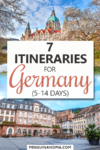
Plan Your Perfect Germany Itinerary with These Detailed Templates!
If you’re looking to plan the perfect trip around Germany, you are in luck! We’re passionate about exploring Germany because it’s a great country – and because Lisa is German!
Jokes aside, we’ve been lucky enough (and have made it a point) to see lots of different parts of the country – from the sea in the north to the mountains in the south. That said, Germany can be a tough country to plan a route or road trip through because there is just so much to see and do!
So, whether you’re looking for the best week in Germany or a Germany itinerary that covers 5 days or 14 days – here’s our master guide with 7 detailed Germany itineraries by train and/or by car! We’ve got cities, attractions, hotels and accommodations, directions, and distances to help you plan the best Germany travel route for you!
We’ve got other great posts to help you plan a visit to Germany:
- Must-Knows + Tips for Travelling to Germany for the First Time
- Helpful German Phrases to Get You By
- Discover 30 Beautiful Places in Germany
- Our Top Hostels in Germany (Stayed at all of them)
Table of Contents
Things to Consider When Travelling in Germany
Before you plan your trip to Germany, there are some things that you should know and keep in mind to make planning easier and to have a successful trip. While you probably know that the currency used in Germany is the Euro, here are some other topics that you should consider as well.
Best Time of Year to Visit Germany
Germany is actually a destination that you can visit year round – but it is important to plan accordingly and go in with the right expectations. If you’re planning a trip during the spring – let’s say from March to May – you could absolutely have beautiful weather… but it may also just rain a lot.
Unfortunately, the weather can be quite difficult to predict. However, as long as you prepare for different possibilities, you can have a great time no matter the weather! Generally you can say that Germany has a moderate climate with cool and rainy winters (more snowy the farther south you get) and warm – but not overly hot – summers.
July and August are usually the warmest months with an average temperature around 20°C. However, there can be days where you have 30°C. Of course, this can vary depending on the exact location you’re travelling to. Often, it is colder by the north coast than it is farther south.
We would honestly recommend that you avoid visiting the country in July if you dislike crowds since this is when the majority of kids are on their summer break from school. As a result, some cities can get quite busy.
Typically, we would recommend travelling in May or June and then from the end of August until the end of September (or even the middle of October). However, there is also a great reason to plan a Germany trip during the winter because of the many beautiful Christmas markets that you could visit at that time of year!
Public Transportation in Germany
Public transportation in Germany is quite good, especially when compared to North America. Yes, sometimes us Germans like to complain about the “Deutsche Bahn” – the German train company – but at the same time we are also super glad that it exists and works well.
If you’re wondering: Yes, all the itineraries mentioned below can absolutely be done if you want to take the train (minus the odd day trip to a castle here and there). If you want to check a train connection and/or buy tickets in advance you can do so on the DB Website . Alternatively, you can also download the DB app to your phone. We both have it and use it regularly.
As an alternative to the train, you can sometimes also use the bus to get from one city/town to another. Since 2013 (before this date it wasn’t allowed), long distance buses have established their presence in more and more cities and are now a popular way to get around for people who are more conscious of their money.
Unfortunately long distance train tickets can sometimes get quite expensive if you don’t book in advance – so the bus can be a good alternative in some cases.
The most popular long distance bus company in Germany is probably Flixbus. We have also used them multiple times to get between cities. If you want to look at the schedule and/or book a ticket, you can do so on their website .
In addition to the trains and long distance buses, the public transport within the cities is also usually pretty good – especially in bigger centres. Many of the cities – or transport associations – have their own transport apps. So, if you know where you are going and plan on using the local buses, trams, metros, etc. then downloading the local transport app would be a great idea!
Car Rental in Germany
If you want to rent a car and plan a Germany road trip, then that is certainly an option as well. Driving in Germany is generally pretty safe and people are not usually as reckless as in some countries in the south of Europe. However, it can get a little crazy in bigger cities like Berlin or Munich – especially if you are not used to driving in bigger centres.
In Germany, you drive on the right side as it is done in the United States, Canada, and many other countries as well. You have probably heard of the “Autobahn” – that’s simply the German name for our highway system. If you follow any of these itineraries, you’ll drive on many different highways.
While it is true that there is no speed limit in some parts of the Autobahn, there are lots of sections where there are actually speed limits in place. You can usually find limits imposed at/around construction zones along the way – so don’t think you can just speed all the time.
And PLEASE don’t drive on the Autobahn like you would on a highway in the United States or Canada – pass on the left and then get back over . If you’re going slower than other cars, there’s no need for you to be in the left (or even in the middle) lane. You can probably tell that this is something that Lisa complains about in Canada frequently, haha.
Since Germany is such a popular destination, there are lots of different rental car agencies to choose from. You can compare prices from different agencies for the duration of your trip with this handy rental car comparison tool . Please make sure to read the fine print so you know whether you need extra insurance, etc.
Also please be aware that many people in Germany drive cars with a stick shift. Rental cars with automatic transmissions exist, but the numbers available are usually lower and these cars might be slightly more expensive.
We’d also recommend that you reserve an automatic car well in advance if you need one – just so you can make sure that one is available for you. It probably wouldn’t be fun learning how to drive a stick shift while on a road trip in a foreign country.
Travel Insurance for Germany
If you’re planning a trip to Germany and you’re not from another EU country, then you should make sure to get travel insurance for the duration of your trip!
While you’ll probably be fine, accidents do happen and it could get really expensive if you’re not covered. That’s why we always travel with insurance.
If you live in another EU country and have health insurance there, you can get the blue health insurance card with which you are covered in other EU countries in emergency cases, as well.
If you don’t have that option – or are from outside of Europe – we recommend that you get private travel insurance.
Germany Itinerary 5 Days
If you only have a few days to travel through Germany, then have a look below at the two 5-day itineraries we have created. For these itineraries, we have assumed that you are not already in the country so they all start and end in bigger cities.
This should help make it easier for you to fly in/out of an airport with good connections if you are coming from overseas.
Depending on your preferences, you can choose between a trip through the northern part of Germany or a trip through the south of the country (mainly Bavaria). If you are interested in bigger cities and/or harbours, then we’d recommend the northern route.
In case you prefer half-timbered houses and beautiful old towns, then you should have a look at the southern route instead. Of course, you can always modify any itinerary to better suit your interests!
Germany Itinerary 5 Days – North
This 5-day Germany itinerary through the northern part of the country can certainly be considered a “sampler-type” of itinerary since you get to see the two biggest cities in the country – but not much more than that.
That’s completely fine though – you can only see so much in five days anyway. If you are interested in bigger cities and don’t have more than a few days, then this itinerary would be great for you!
The total driving time for this itinerary would be about 5 hours 30 minutes with a total distance of approx. 520 km. Of course, this can change depending on the route you are taking and the time of day you are travelling. Commuter traffic could add quite a bit of travel time to your journey.
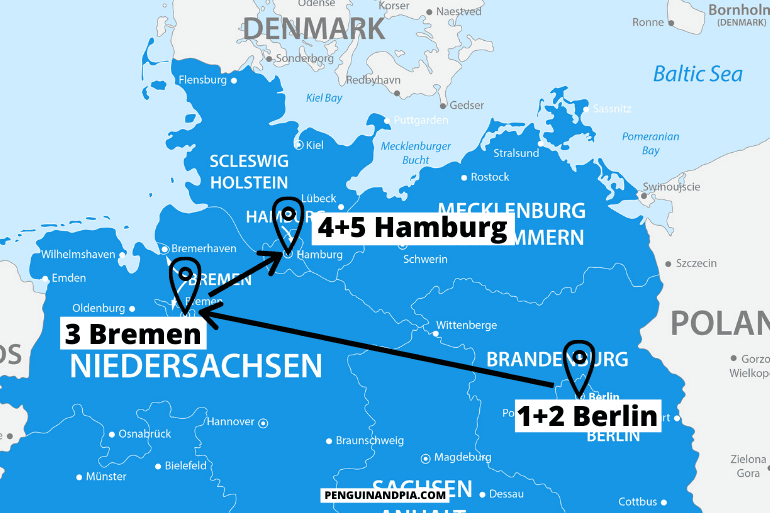
Day 1+2: Berlin Day 3: Bremen Day 4+5: Hamburg
Day 1+2: Berlin
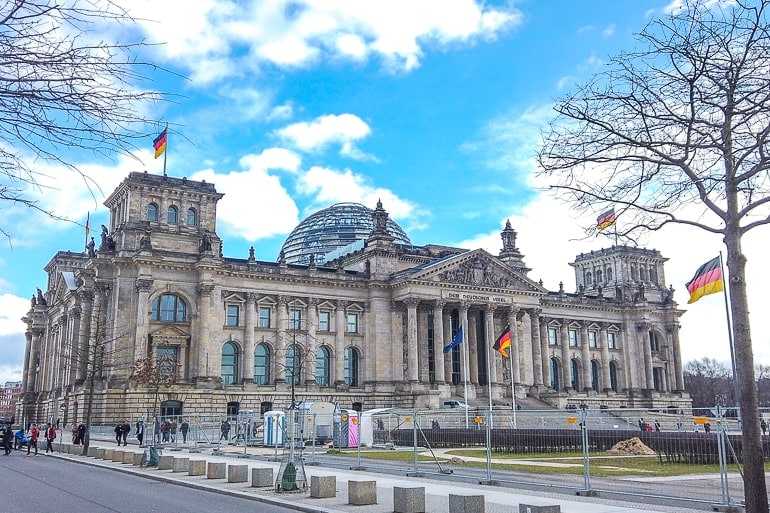
Berlin is a great place to start your adventure since it is the German capital, has multiple airports close by, and has really good train connections.
Since Berlin is such a popular tourist and business city, the car rental industry is well established and there are many different rental agencies to choose from.
— Compare prices from rental car companies in Berlin here
However, since you are only visiting bigger cities on this relatively short itinerary, we believe that a rental car is probably not necessary. Instead, for this trip, it might make more sense to take the train.
Since Berlin is such a big city with lots of things to do, it is worth it to spend (at least) two days in the city. So, remember to book your accommodation in Berlin for two nights .
Accommodation in Berlin : Berlin is a massive sprawling city with loads of different areas to stay and different accommodation options. You can check here for accommodations and hotels in Berlin .
If you are travelling to Berlin with a car, you’ll need a place to park. Check out Park Plaza Wallstreet Berlin Mitte for a stay right in the middle of the city close to Museum Island and other top attractions. It also has a tasty breakfast. Park Plaza has free parking on the street near the hotel (if available) or else it’s for a fee (but a reasonable price considering you’re in the middle).
If you are arriving into Berlin by train, you can check out NH Collection Berlin Mitte am Checkpoint Charlie . Located in the city centre right near the top sight “Checkpoint Charlie”, this popular hotel is in the heart of the action/attractions and is easy to get to via modes of public transit (metro – called the “U” for U-bahn).
If you are searching for a hostel/hotel, check out PLUS Berlin . Located over near the East Side Gallery (the piece of the Berlin wall with the artwork on it), Eric stayed here and really liked it! It’s also very easy to get to using public transit and is close to other areas to go out, etc.
Must-see Attractions in Berlin:
- Brandenburg Gate
- East Side Gallery (Berlin Wall)
We have also written a whole article about classic tourist attractions in Berlin in case you’d like some more inspiration. If you’re looking for some tips on how you could spend a day in Berlin, have a look at our One Day in Berlin Guide .
Day 3: Bremen
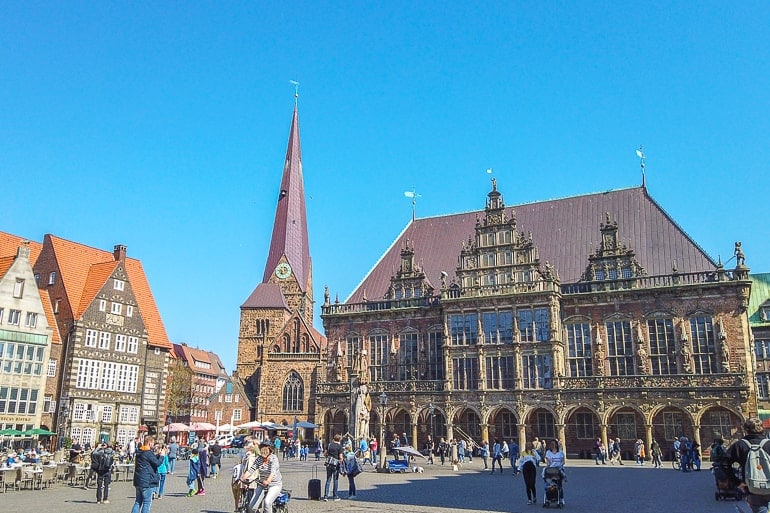
On the third day of your 5 days in Germany, you’ll head for Bremen. We’d recommend that you do the drive/train ride in the morning so you have enough time to explore the city once you get there.
Bremen is a hanseatic city with a nice old town – the market square with the town hall and the cathedral is especially popular. In German-speaking countries, the city is also known for a tale called the “Town Musicians of Bremen” by the Brothers Grimm. You’ll come across the animals of the tale (donkey, dog, cat, and rooster) many times as you stroll through the city.
The drive from Berlin to Bremen will take you approximately 4 hrs 10 min by car , but only around 3 hrs by train . If you take the train, try to book in advance if you can as this will usually save you some money.
Accommodation in Bremen: Bremen is a popular city to explore and it’s also on the larger side so you’ll find plenty of accommodations to suit your needs. There are hotels in the city centre/old town which put you within walking distance of the river and top attractions. You can check here for accommodations and hotels in Bremen .
For a popular choice in the historic middle, you should check out the very popular Radisson Blu Hotel Bremen . Funny story – we know there’s underground parking because we parked there when we visited Bremen by car.
If you want to stay closer to the train station just outside the historic centre (but still very central), check out the Dorint City-Hotel Bremen . This lovely and also very popular hotel is close to the pretty Windmill and flower gardens and has water views just outside the old city walls.
Must-see Attractions in Bremen:
- Marktplatz with Town Hall and Cathedral
- Böttcherstraße
- Schnoorviertel
If you want some more tips for Bremen, have a look at our detailed Things to do in Bremen Guide .
Day 4+5: Hamburg
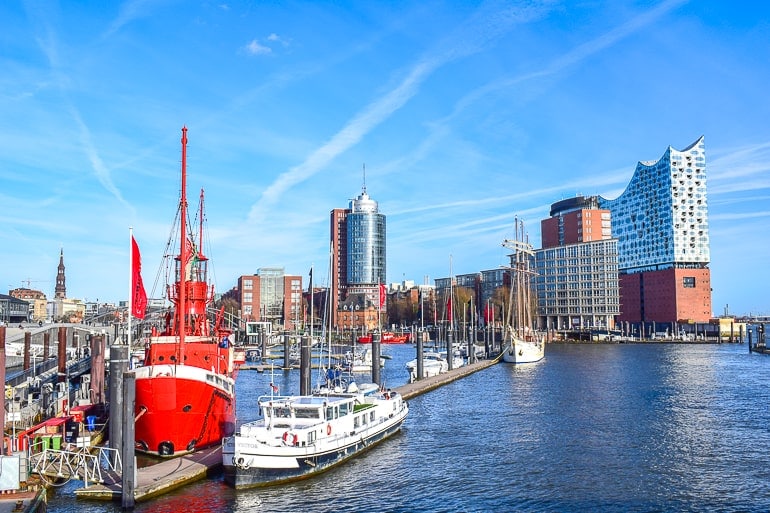
Hamburg is the second-biggest German city and the last stop on this short itinerary. We have been to Hamburg numerous times now and it is actually one of our favourite bigger German cities. You’ll find that the atmosphere of the city is very different than in Berlin. Not necessarily better or worse – just different.
Interesting (and slightly irrelevant) fact: The cities you visit on this itinerary are the three city states that exist in Germany in addition to the 13 area states such as Bavaria, Nordrhine-Westphalia etc.
The drive from Bremen to Hamburg is actually pretty simple and should only take around 1 hour 30 minutes by car and just around 1 hour if you take an ICE (fast train) . The train connection between these two cities is great with trains running pretty frequently. That should make it quite easy to find a train connection that works for your schedule.
Accommodation in Hamburg : Hamburg is popular city with loads of different accommodations and areas to stay in. You can check here for accommodations and hotels in Hamburg .
If you are travelling to Hamburg with a car, you might want to check out the Mövenpick Hotel Hamburg . Located in an old water tower, this unique hotel has a number of cool features with stunning views and parking onsite. It’s very popular – and also close to public transit for getting around!
If you are travelling to Hamburg by train, ARCOTEL Rubin Hamburg is a great hotel option for you to check out. Located in the cool area of St. Georg, you can easily walk to the hotel from the train station. It’s also walkable to other parts of the city centre and other attractions.
If you are looking for a hostel in Hamburg, you might want to check out Generator Hamburg as a reliable and popular hostel stay close to central station and the heart of the city.
If you want more details about accommodations in the city, we have a more detailed guide on where to stay in Hamburg .
Must-see Attractions in Hamburg:
- Speicherstadt
- Elbphilharmonie
- St. Pauli Piers
As one of our first ever articles on Penguin and Pia, we actually wrote a short Hamburg Guide . Have a look if you want some more Hamburg inspiration. Unfortunately it’s not nearly as detailed as our newer article – looks like it’s time for an update!
Germany Itinerary 5 Days – South
If you would like to explore the southern part of Germany instead of the north, then we would recommend the following 5 days Southern Germany itinerary. Compared to the northern itinerary, this trip includes stops in some smaller towns and cities. So, if you are interested in seeing some places of various sizes, beautiful old towns, and maybe a castle, then this might be a good itinerary for you.
The driving distance of this trip is just around 680 kilometres with a total driving time of approx. 7 hours . Depending on your mode of transportation, this can – of course – vary slightly.
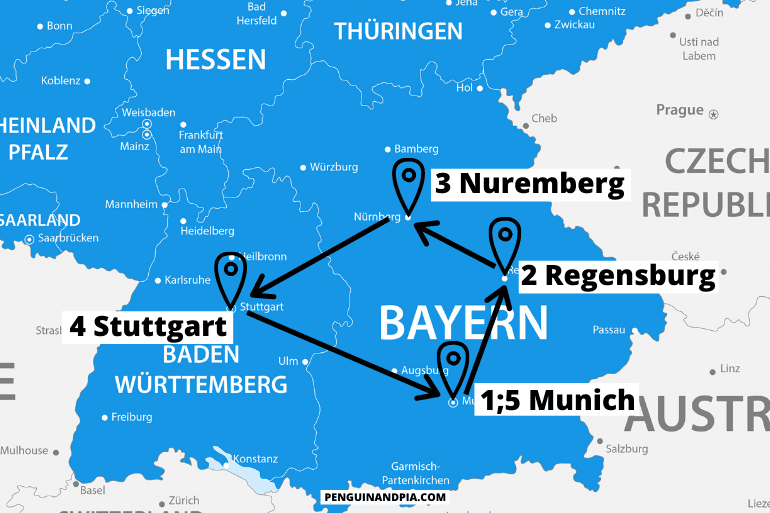
Day 1: Munich Day 2: Regensburg Day 3: Nuremberg Day 4: Stuttgart Day 5: Munich
Day 1: Munich

We are starting (and ending) this itinerary in Munich since it is an easy airport to fly in and out of from other parts of the world. If you are coming from another part of Europe by train, the connections to Munich are also usually pretty good.
Munich is the third-biggest German city and a very popular tourist destination. International travellers often mainly know the city because of the Oktoberfest which happens every year from the middle of September until October.
However, there is so much more to do and see in Munich than just the “Wiesn” (as the Oktoberfest is sometimes called as well). We are always happy to return to Munich because there is just so much to explore.
If you are thinking about renting a car for this itinerary, then you’ll be happy to know that it is quite easy to get a rental car in Munich. You can either pick it up directly at the airport after you land (if you arrive by plane) or in the city centre before you head to the next stop on this journey.
— Compare prices from rental car companies in Munich here
Accommodation in Munich: Munich is very large and popular city so finding a place to stay is no problem. The issue becomes that there are too many places to choose from! That said, you can check here for accommodations and hotels in Munich .
Specifically, we stayed at the very popular H2 Hotel München Olympiapark and we would highly recommend it for the value for money. The hotel has nice, cozy rooms, a super great breakfast buffet, and has a metro station steps from the front entrance to take you to the city centre.
There’s also onsite parking which makes this hotel perfect if you are travelling to Munich by car. The famous Olympic Park and BMW Museum are close by, too!
If you want to stay a little more in the city centre, then check out the Platzl Hotel Superior . This trendy hotel is in the heart of the Old Town just steps from top attractions like Marienplatz and the famous Hofbräuhaus. It’s also easy to get to the central train station either walking or on the metro.
If you are looking for more details on accommodations in this massive city, we wrote a detailed guide on where to stay in Munich .
Must-see Attractions in Munich:
- Marienplatz with New Town Hall
- Olympic Park
- Victuals Market
- English Garden
We also have a great little guide on how to spend one day in Munich if you want more details.
Day 2: Regensburg
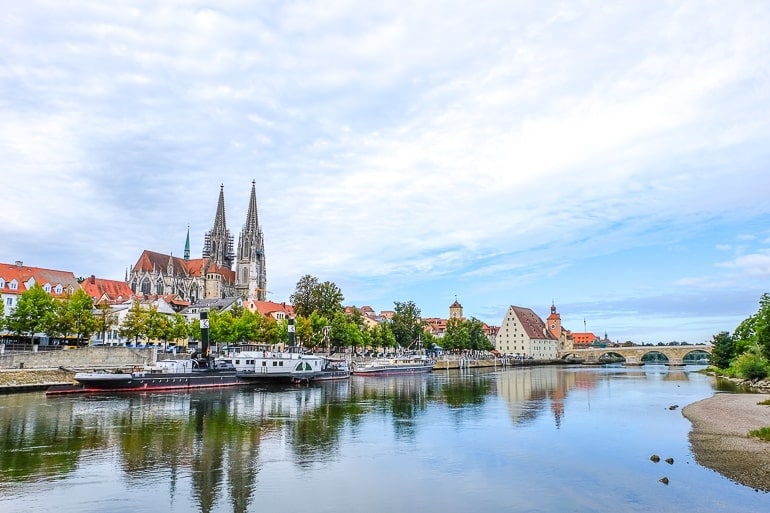
On day two of your trip you’ll be on your way to Regensburg, a small city in Bavaria on the Danube river. Due to its location by the river, Regensburg is a popular stop for people on a river cruise. So don’t be surprised if you see many different tour groups in the Old Town.
We recently spent a couple of days in Regensburg to get to know the city better and enjoyed our time there. One of the highlights is the Old Stone Bridge in the city centre which was built in the 12th century. We actually filmed a small YouTube video in Regensburg – which you can watch here if you are curious about what the city looks like.
The journey from Munich to Regensburg takes approximately 1 hr 20 minutes by car and around 1 hr 30 minutes by train . If you decide to travel by train – and especially if you are travelling with other people – we would recommend that travel with a “Bayernticket” (Bavaria Ticket). This ticket for train travel within the state of Bavaria usually allows you to save some money compared to regular prices.
Accommodation in Regensburg: If you are staying a night in Regensburg, you’ll have a number of great accommodations to choose from. To get started, you can check here for accommodations and hotels in Regensburg .
When we visited the city, we stayed at the Holiday Inn Express – Regensburg and really liked it. It’s a newer hotel and it really shows. The breakfast was excellent and there is even an onsite parking garage if you are travelling with a car. It’s not in the Old Town or near the river – but we did walk there one day and it only took about 15 minutes.
If you are travelling by train and you are on-foot, then check out the Altstadthotel Am Pach . This simple hotel is located right in the heart of the old town so you’re close to everything there is to see and do in Regensburg – including the beautiful Danube River. They also have breakfast included.
Must-see Attractions in Regensburg:
- Old Stone Bridge
- St Peter Cathedral
We are currently still working on our Regensburg Guide – but we’ll link it here once it is published.
Day 3: Nuremberg
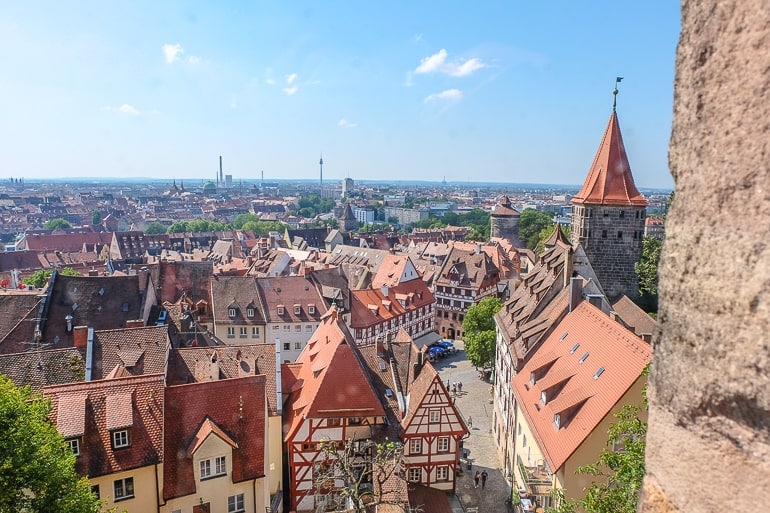
On the third day of this 5 day Southern Germany itinerary you’ll drive – or take the train – from Regensburg to Nuremberg. Nuremberg is a medium sized city in a part of Bavaria called Franconia. If you pay attention, you might notice that the dialect spoken here is quite different from that spoken in Munich and other places farther south.
Lisa actually grew up in this part of Germany so she has been to Nuremberg many, many times. Last year we also went to explore the city together and had a great time. Travellers from abroad mainly know the city for the Nuremberg Trials which took place there after World War II. You can certainly learn alot of history in this German city!
Since Nuremberg is quite close to Regensburg the drive won’t be long – giving you slightly more time to explore the city.
The journey takes approximately 1 hour 10 minutes by car and between 1-2 hours by train depending on which train you take (some stop more often than others). Once again, a regional ticket – such as the Bavaria Ticket – will probably save you some money if you travel with more people.
Accommodation in Nuremberg : Since Nuremberg is a very popular city to visit in Germany, there are many, many places to stay scattered throughout the city centre and around it. You can check here for accommodations and hotels in Nuremberg .
When we visited, we stayed at Five Reasons Hotel and Hostel and we really liked it. Located just inside the medieval city walls, we were really close to the train station and yet also steps from top attractions like the Germanisches Nationalmuseum. The place was bright and great value for the price which we liked a lot.
Close to Five Reasons, we had friends stay at the Sheraton Carlton Nuremberg and they loved it. We actually saw it with our own eyes – it had a pool with views of the city among other perks. There’s also a parking lot right across from the hotel if you’re coming to Nuremberg by car. It’s walking distance to the old centre and the central train station so best of all worlds!
Must-see Attractions in Nuremberg:
- Imperial Castle of Nuremberg (Kaiserburg)
- Documentation Center + Nazi Party Rally Grounds
- Albrecht Dürer’s House
As is the case with Regensburg, we are also still working on our article for Nuremberg. Once it’s live, we’ll link it here.
Day 4: Stuttgart
Stuttgart is the capital of the German state called Baden-Württemberg and the only place on this itinerary that is not located in Bavaria. The city is mainly known for being a “car hub” since both Mercedes-Benz and Porsche have their headquarters there. There are also museums dedicated to both car brands.
Stuttgart is a bit smaller than Munich but there is still a lot to see. In fact, one day won’t be enough to see the whole city – but it’ll allow you to get a good first impression. Next to the car museums, you could visit some of the many green spaces and/or old buildings that the city has to offer.
Driving from Nuremberg to Stuttgart by car will take you approximately 2 hours 15 minutes. If you have the time, you could even take a small detour and stop in Rothenburg ob der Tauber, known for its picturesque Old Town.
By train , the journey from Nuremberg to Stuttgart will take between 2 hrs 10 minutes and 2 hrs 30 minutes – depending on the type of train you are taking. Try to book your ticket in advance if possible as this can save you some money.
Accommodation in Stuttgart: There are many places to stay in Stuttgart – especially in the city centre. You can check here for accommodations and hotels in Stuttgart .
If you’re travelling to Stuttgart with a car, check out the Abalon Hotel ideal . Located very much in the city centre, this popular hotel has an underground parking garage and offers a good breakfast selection.
If you’re travelling to Stuttgart by train, you can check out the Pension am Heusteig . This guesthouse-style accommodation doesn’t have parking but offers a great breakfast and is a doable walk or metro ride from the train station. Funny enough, these two accommodations are very close to one another!
Must-see Attractions in Stuttgart:
- Schlossplatz
- Mercedes-Benz Museum
- Staatsgalerie Stuttgart
Day 5: Munich
On the last day of your trip you’ll make your way back to Munich since it is usually easier to leave Germany through the Munich airport than smaller airports in the surrounding area.
However, if you don’t have to get to an airport – and/or are taking the train home – you could also stay an extra night in Stuttgart if you wanted. Both cities are worth spending an extra few hours in – so you really just have to see what works best for you.
If you decide to get back to Munich, then the journey from Stuttgart to Munich will take approximately 2 hours 20 minutes by car and just slightly less (2 hrs 15 minutes) by train .
Accommodation in Munich : We already went over accommodations in Munich in Day 1 of this itinerary. So, you can head back up for the full details – but we would highly, highly recommend the H2 Hotel München Olympiapark as great value for money with great breakfast, parking, and a metro stop outside the front door.
Don’t forget we also have our detailed guide on where to stay in Munich if you want to have a deeper look at accommodations in the city.
We also have a post on spending one day in Munich if you want more details about the city!
Germany Itinerary 7 Days
If you have slightly more time to explore Germany, we have also created two 7 day Germany itineraries for you. Similar to the 5 day itineraries, we made two different itineraries since it’s pretty much impossible to see the whole country in just a week.
Instead of a northern and southern itinerary, this time we have focused on the western and eastern parts of the country. But please don’t read too much into that description – we use the terms quite loosely. As always, you’re welcome to modify any part of the itinerary to make it better fit your schedule/interests.
Germany Travel Itinerary 7 Days – West
For this itinerary, the total driving time would be around 14 – 15 hours and the distance would be slightly over 1100 km . For these calculations, we included the day trip to Monschau (and back to Cologne) as well as the day trip to Freiburg im Breisgau (and back to Stuttgart), which would be a longer day trip anyway.
So, depending on which day trips you decide to add on to (or remove from) this itinerary, your driving time and distance could be noticeably different than the estimates given above!
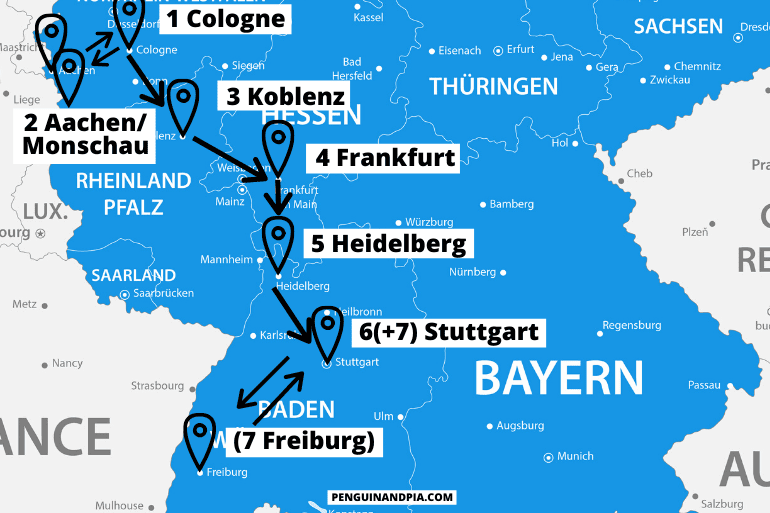
Day 1: Cologne Day 2: Day Trip to Monschau/Aachen Day 3: Koblenz Day 4: Frankfurt Day 5: Heidelberg Day 6: Stuttgart Day 7: Stuttgart / Day Trip to Freiburg im Breisgau
Day 1: Cologne
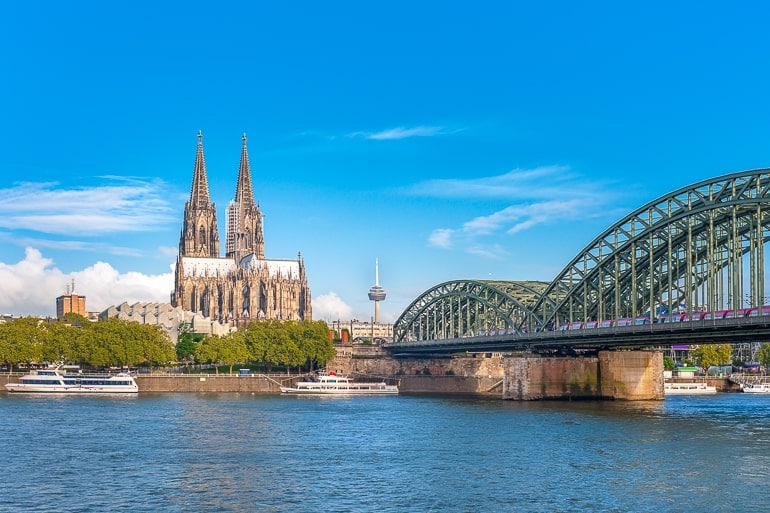
As we have already explained above, we like to start these itineraries in bigger cities to make it easier for people from overseas to get to Germany and start their adventure without hassle. Cologne is Germany’s fourth-biggest city (by population) and has two pretty good airports (Airport “Köln Bonn” and Airport “Düsseldorf”) close by for those coming from far away.
If you want to rent a car for this itinerary, it should be pretty easy to get one in Cologne since it’s quite an international city with lots of visitors.
— Compare prices from rental car companies in Cologne here
Cologne is a pretty spread-out city so you won’t be able to see the whole city in a day or two. However, the highlight of the city is certainly the Cologne Cathedral which is located right next to the central station and the Rhine River.
Make sure to plan some time to visit this impressive building – we always spend much longer in there than we originally plan. It’s free to enter so it can get very crowded depending on the day and time you’re visiting.
Accommodation in Cologne : Cologne is a very big city with multiple areas to stay in. As such, there are lots of accommodation options across the city. Wherever you book, remember to book your accommodation for two nights since you will go on a day trip and then return to Cologne on the second day. You can check here for accommodations and hotels in Cologne .
We have stayed in the Lindner Hotel City Plaza and loved it. The floors all have themes (we got Cologne Zoo with animals), the breakfast buffet is absolutely fantastic, and it’s a short walk to the Cathedral along one main street. There’s also parking available at/near the hotel for those with a car.
If you want to stay more in the heart of the city centre, check out something like the CityClass Hotel Residence am Dom . It’s popular, centrally located with shops and restaurants around, and only a short walk to the train station.
If you are looking for a hostel in Cologne, Eric once stayed at Cologne Downtown Hostel and it was honestly excellent. There’s a grocery store right below it and it’s located in the city centre. It also has a large balcony to enjoy the sunshine from!
Must-see Attractions in Cologne:
- Cologne Cathedral
- Cologne Chocolate Museum
Day 2: Day Trip to Monschau/Aachen
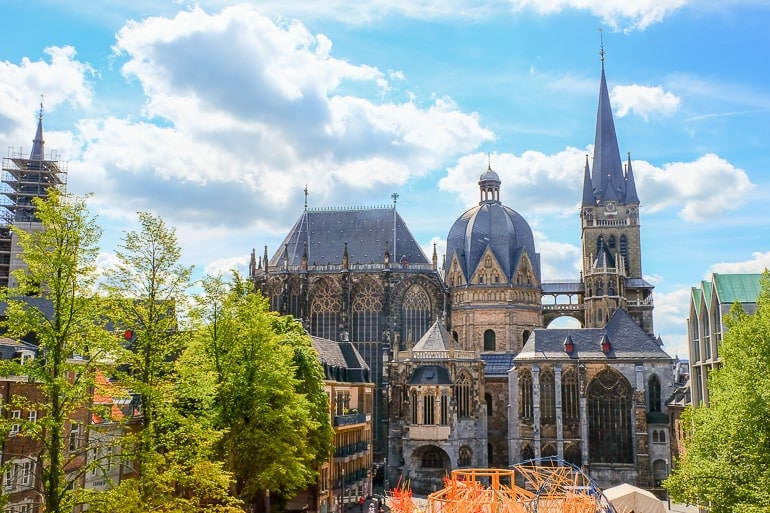
On the second day of this Germany itinerary, you have a few different option: you can either spend another day in Cologne if you feel like you haven’t seen enough of the city yet or take a day trip to Monschau or Aachen. Both of these are two places not too far from Cologne.
Monschau is a popular day trip in the area mainly because of its picturesque buildings in the old town. In fact, you probably have already seen photos of it on social media. To get to Monschau from Cologne, you can either drive or take a combination of trains and buses.
Getting to Monschau takes around 1 hr 40 minutes by car and approx. 2 hours by public transport . To visit Monschau by public transport, you can take the regional train from Cologne to Aachen-Rothe Erde and then take Bus #66 from there to Monschau.
Must-see Attractions in Monschau:
- Monschau Castle
If you want to go on a day trip but don’t want to venture that far, then Aachen would be another great option. This city is actually Germany’s most western city very close to the borders of The Netherlands and Belgium.
We’ve lived close to Aachen for a while and have written a whole guide full of things to do in Aachen that you should read if you want more information. In our opinion, one day is the perfect amount of time to explore the city since it doesn’t have that many attractions and the old town in the city centre is quite compact (but still very pretty).
Getting from Cologne to Aachen is also very easy. It takes approx. 1 hr 20 minutes by car and just around 50 minutes by regional train . You should look into getting a “Schönes Tag Ticket NRW” for the day if you’re travelling with more people as this can save you some money.
Must-see Attractions in Aachen:
- Aachen Cathedral
- Elisenbrunnen
Day 3: Koblenz
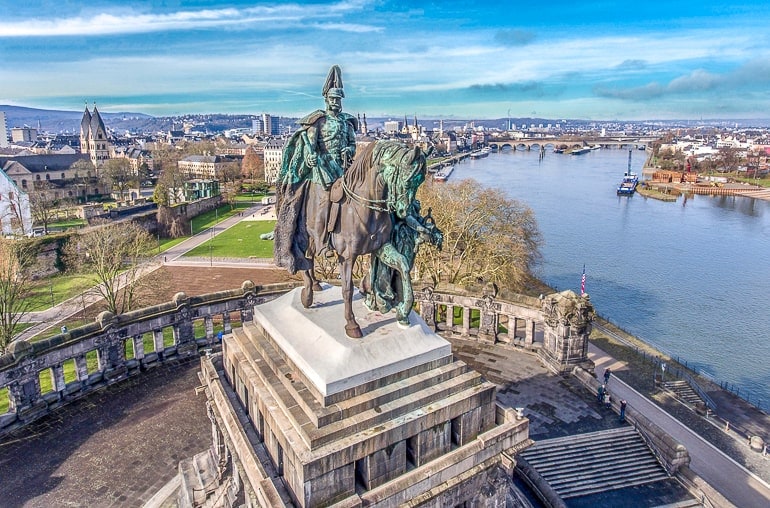
From Cologne, your journey continues to Koblenz – another city on the Rhine River. Koblenz is a smaller German city with a population of slightly over 110,000 inhabitants.
There are quite a few castles and nice hikes in the area which are easy to reach from Koblenz – just in case you decide that you don’t want to spend the day in the city. Depending on the time of year, you could also look into booking a boat tour on the Rhine river. This way, you get a unique perspective of the beautiful region.
Getting from Cologne to Koblenz is pretty easy and will take approximately 1 hour 30 minutes by car and between 50 minutes and 1 hr 10 minutes by train . We really like this train journey since the tracks follow the river for a majority of the trip. As a result, you get some really nice views – and might even spot some of the beautiful castles in the area!
Accommodation in Koblenz: Koblenz is certainly not a huge city – but you’ll still find a good number of places to stay for a night or two. You can check here for accommodations and hotels in Koblenz .
For a hotel right in the city centre, check out the Sander Hotel . This lovely hotel is super popular and close to shops and the rivers. If you are arriving to Koblenz by car, there is onsite parking at the hotel. However, since the city is smaller you can also easily reach the hotel by walking from the central train station.
Must-see Attractions in Koblenz:
- Deutsches Eck
- Ehrenbreitstein Fortress
- Koblenz Cable Car
Day 4: Frankfurt
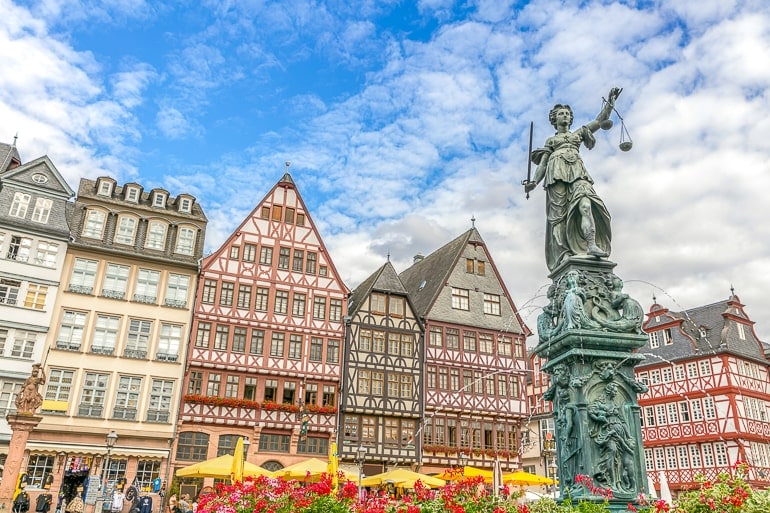
The next stop on your itinerary is Frankfurt, arguably one of the country’s most popular transport hubs due to the busy Frankfurt airport. Frankfurt is an interesting city that divided people: some people really enjoy it while other people don’t like it at all. To be fair, we haven’t spent enough time in the city to really solidify our opinion.
Either way, we do believe that Frankfurt is a stop that you shouldn’t miss if you are trying to get to know different areas of Germany. Known as the financial hub of Germany, this city with its many skyscrapers can feel quite a bit more modern than other German cities. However, the city also has a beautiful, historical market square that you should visit.
The journey from Koblenz to Frankfurt is another easy one – and if you are taking the train (we would recommend that!), you’ll once again follow the Rhine River for big parts of the journey and be rewarded with some great views.
The train ride will probably be between 1 hr 25 minutes and 2 hrs 12 minutes long – depending on the connection you choose. By car , the trip will take around 1 hr 30 minutes . Of course, this can vary depending on traffic.
Accommodation in Frankfurt : There are loads of places to stay in Frankfurt given its popularity and size. You can check here for accommodations and hotels in Frankfurt .
A great option in Frankfurt is the Motel One Frankfurt-Römer . Located very much in the heart of the city centre close to the old town and river, this cool hotel has underground parking if you are arriving to Frankfurt by/with a car. It also serves up a great breakfast!
If you are arriving by train to Frankfurt, you should check out Fleming’s Express Hotel Frankfurt . Located literally right beside the central station (which is in the city centre), this upscale hotel is very popular because it’s very affordable and also has a great breakfast.
Must-see Attractions in Frankfurt:
- Palmengarten
Day 5: Heidelberg
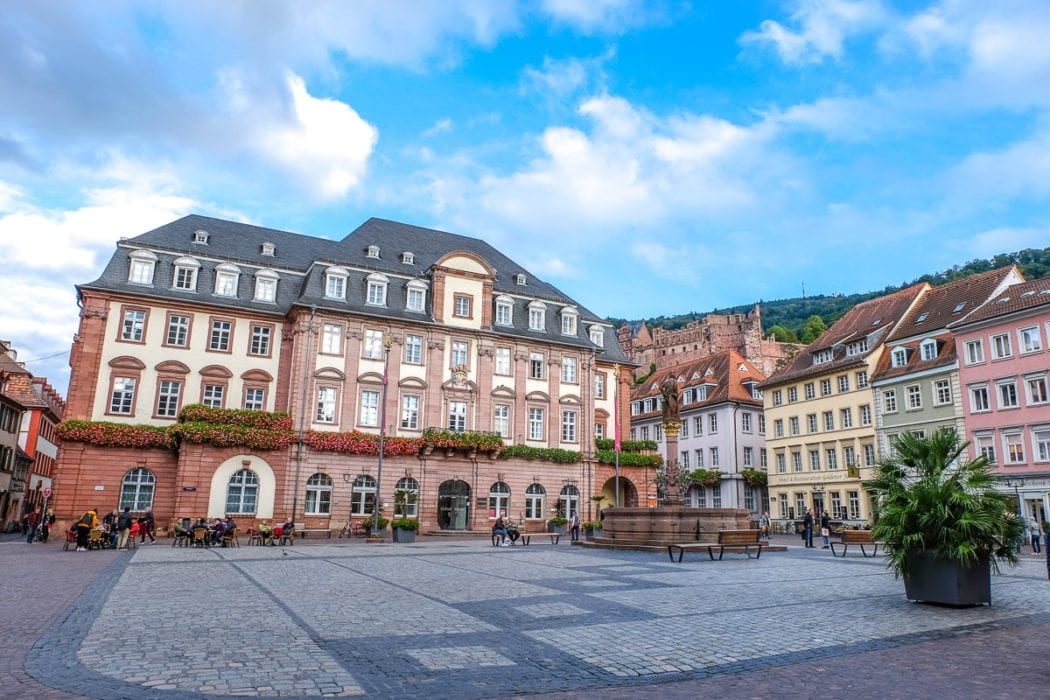
After your day in Frankfurt, you’re heading to Heidelberg which is actually one of our favourite German cities. The highlight of the city is certainly the castle on top of the hill which is visible from many different parts of the city.
Heidelberg is smaller than Frankfurt so you can see quite a bit in just 24 hours. The Old Town is beautiful and lots of attractions are located there. Our highlight was probably the tower climb of the Church of the Holy Spirit. From up there, you get a beautiful view of the Old Town. A very close second was the cable car ride up to the Königstuhl which was lots of fun – even in the rain.
Getting from Frankfurt to Heidelberg won’t take too long. The journey will be approximately one hour by car and between 45 minutes and 1 hr 30 minutes by train – depending on which type of train you are taking.
Accommodation in Heidelberg: If you’re heading for Heidelberg (good choice), there are lots of great places to stay. You can check here for hotels and accommodations in Heidelberg .
We stayed a little outside the old town – but close to the train station – at NinetyNine Heidelberg City . This hotel was really, really great. The beds were comfy and the decor has animals everywhere – you have to see it to understand!
There’s onsite parking (paid) and street parking (free, but not guaranteed) if you are travelling with a car. There’s also a tram stop right outside the hotel to get directly into the city centre in minutes.
If you are looking to stay in the historic old town, then check out colourful hotels like Hotel Holländer Hof which overlooks the river or Hotel Zum Ritter St.Georg which is literally overlooking the main Marktplatz.
Must-see Attractions in Heidelberg:
- Heidelberg Palace
- Church of the Holy Spirit (mainly tower climb)
If you want to learn some more about Heidelberg and what there is to do, you can read our detailed Heidelberg Guide here .
Day 6: Stuttgart
The next day you will drive to Stuttgart, a city that we’ve already mentioned in one of our Germany itineraries for 5 days. As we have already mentioned, you’ll probably really enjoy Stuttgart if you are interested in cars.
Even if you aren’t, there is still lots for you to explore. Did you know that wine also plays a huge role in Stuttgart and the surrounding region? If this is something that interests you and you’re there in the summer (specifically around the end of August), then you should stop by the “Stuttgarter Weindorf” (“wine village”) – but obviously, please don’t drink and drive.
As for getting from Heidelberg to Stuttgart, the journey will take you approximately 1 hr 20 minutes by car and between 40 minutes and 1 hr 30 minutes by train . As mentioned before, the time differs depending on the type of train you are choosing.
Accommodation in Stuttgart: Stuttgart has many places to stay so you can check here for accommodations and hotels in Stuttgart .
Be sure to see the Abalon Hotel ideal if you have a car. This hotel has underground parking available and a tasty breakfast. It’s also in the city centre which makes sightseeing easy.
Those coming to Stuttgart by train should look at the Pension am Heusteig . It’s a guesthouse that is located not too far from the first hotel here and it’s a doable walk or metro ride from the central station.
Day 7: Stuttgart / Day Trip to Freiburg im Breisgau
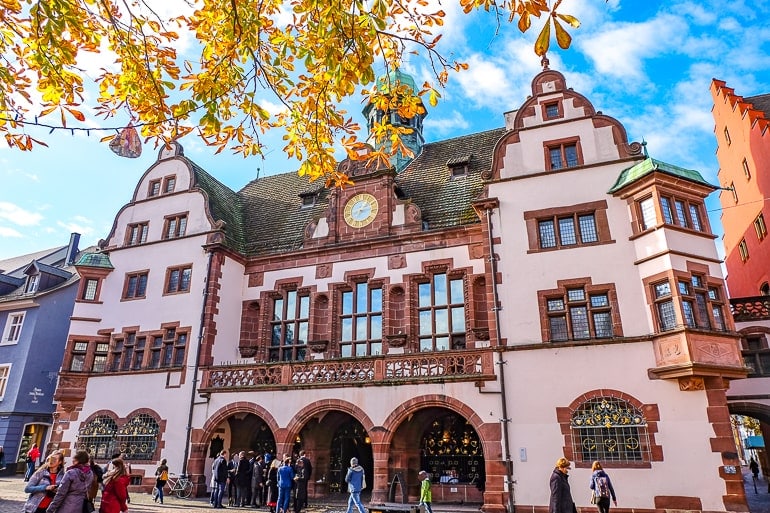
For this itinerary, you can decide how you would like to spend your last day. You could either spend another day to explore more of Stuttgart (and maybe relax for a bit) or you could head farther south and spend a day in Freiburg im Breisgau. We really enjoyed spending time in this small city in the south of Germany during our visit.
We are currently still in the process of writing our Freiburg guide, but we’ll link it here once it’s done. However, a good way to start your exploration of the city is by wandering the old town.
In Freiburg, you’ll find that many of the cobblestoney streets have small water-filled runnels – called Bächle – running alongside it. Sometimes they even have small yellow ducks in them!
The journey from Stuttgart to Freiburg im Breisgau is slightly longer than most other parts of this itinerary. It takes approximately 2 hrs 30 minutes by car and around 2 hours by train . Since this train journey will probably include at least one ICE (the fast train), we’d recommend that you book your train tickets early if you can to save some money.
Must-see Attractions in Freiburg:
- Freiburger Münster (Cathedral)
- Schlossberg + Tower
- New + Old Town Hall
Germany Travel Itinerary 7 Days – East
If the other week-long Germany itinerary doesn’t interest you and/or you really want to visit the German capital Berlin, then you might prefer this eastern route instead.
The driving time would be just slightly over 10 hours and would be approximately 900 km driving distance – including the day trip to Potsdam (which would honestly be easier with public transport, though)!
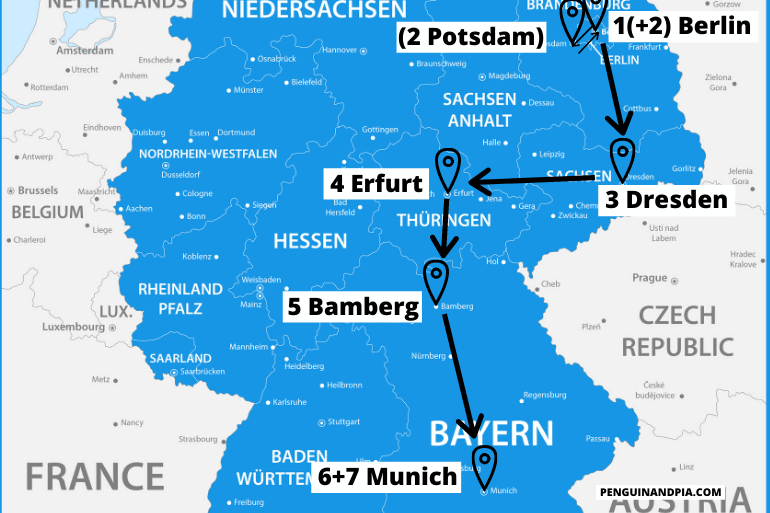
Day 1: Berlin Day 2: Berlin / Day Trip to Potsdam Day 3: Dresden Day 4: Erfurt Day 5: Bamberg Day 6+7: Munich
Day 1: Berlin
Once again, this itinerary begins in Berlin since it is one of the big cities that is easier to get to for people coming from overseas. Similar to the five day itinerary that started in Berlin, you’ll stay two nights in the German capital. There is just too much to see to spend only one day – and even in two days you wouldn’t be able to explore everything.
In case you’ve already been to Berlin on a different trip and/or aren’t a huge fan of big cities, we also give you the option of a day trip to Potsdam (a city close by) on the second day. More on that below.
Accommodation in Berlin : Finding a place to stay in Berlin can be tough because there are just so many options. You can check here for accommodations and hotels in Berlin .
If you have a car, check out Park Plaza Wallstreet Berlin Mitte . Located right in the middle of the city close to Museum Island, this hotel has a great breakfast and free parking on the street behind the hotel. Otherwise, parking is paid but for a decent price for the city centre.
Those without a car travelling by train should see the NH Collection Berlin Mitte am Checkpoint Charlie . If you want a hotel close to a top attraction that is easy to get to with public transport, this is definitely one of them!
Across the city, PLUS Berlin is a really good hostel/hotel that Eric stayed at a few years ago. It’s a big place but it was a great stay over by the East Side Gallery (part of the Berlin Wall with the graffiti on it).
As already mentioned above, if you want to read some more about Berlin, check out our articles on Things to do in Berlin and How to spend one day in Berlin .
Day 2: Berlin / Day Trip to Potsdam
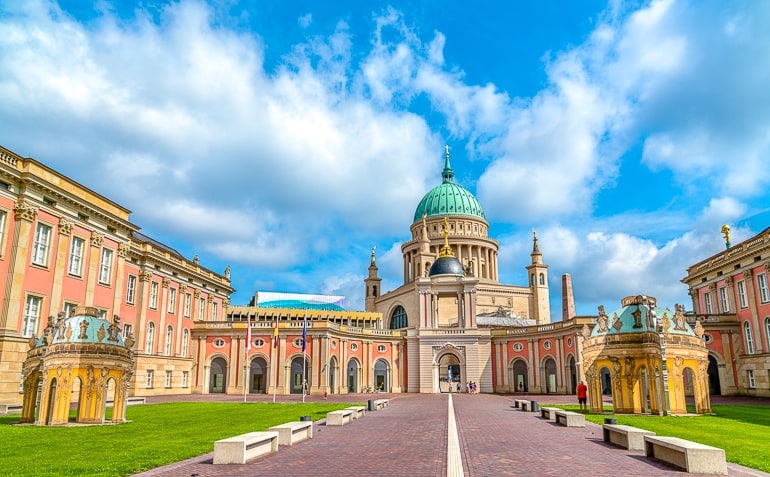
On your second day, you can choose between spending another day in Berlin to see more of the German capital or going on a day trip to Potsdam – which is a smaller city not far from Berlin.
Potsdam is actually the capital city of the German state called Brandenburg. It’s most popular attraction is probably Sanssouci Palace with the beautiful Sanssouci Park surrounding it.
During our visit, we also enjoyed walking through the Dutch Quarter with its small shops and cafes. Since the city isn’t too big, one day gives you a chance to get a good impression and check out some of the more popular sights.
It is also very easy to get to Potsdam from Berlin. If you decide to drive , it’ll take you approx. 40 minutes , but it could be longer – traffic depending. We would honestly recommend that you do this day trip by taking public transport. This way, you don’t have to worry about traffic and/or finding a parking spot.
For trains, you can take the S-Train #7 (S7) from Berlin Central Station (as well as other train stations) straight to Potsdam Central Station. The journey will take around 35 minutes with trains running very frequently throughout the day.
Must-see Attractions in Potsdam:
- Sanssouci Palace
- Dutch Quarter
- Cecilienhof
Day 3: Dresden
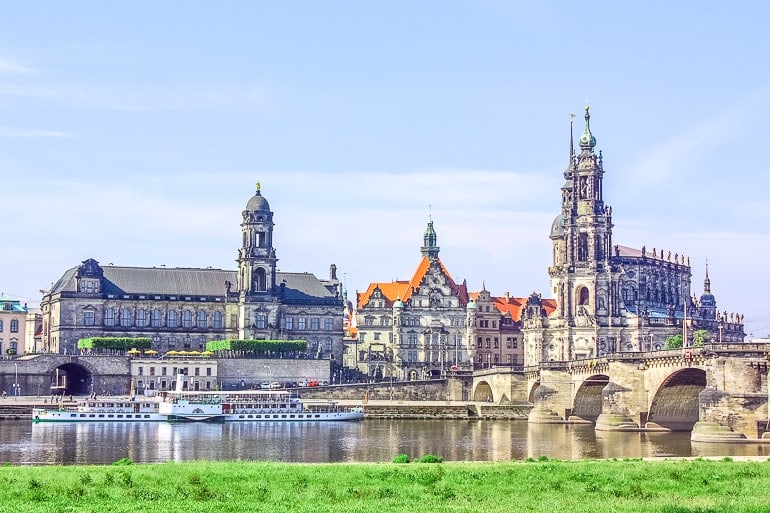
The third day of this Germany itinerary will take you from Berlin to Dresden which is a German city close to the Czech border. To be honest, we haven’t spend that much time in Dresden yet – and it’s certainly on our list of places to visit this year.
One of the city’s main attractions – the Zwinger – is known across the country and a sight that you shouldn’t miss during your visit. It’s a beautiful palace built in a baroque style.
Fun fact: When Lisa was a kid, she didn’t actually know that the “Zwinger” was a palace. Since that word can also mean “dog kennel” in German, she was always confused as to why people would want to visit it during their time in Dresden!
As for getting from Berlin to Dresden, the drive will take you around 2 hrs 10 minutes by car and around 2 – 3 hours by train. Once again, this depends on which connection you choose.
Accommodation in Dresden: There are a number of accommodations in the compact “Innere Altstadt” close to the River Elbe for you to choose from. You can check here for accommodations and hotels in Dresden .
For a great hotel option right in the old town, look no further than the Star Inn Hotel Premium Dresden im Haus Altmarkt . You’re a short walk to the train station, the river, and all the best old sights in Dresden if you stay here and arrive by train. If you come to Dresden by car, the hotel has discounted underground parking available.
Another option right in the old town (and even closer to the river) is Aparthotel am Schloss . Since this is an apartment-style hotel, it’s a great option if you are looking for more of a base to relax in a “home away from home”. It’s a very popular choice, too – and also has onsite parking.
Must-see Attractions in Dresden:
- Frauenkirche
Day 4: Erfurt
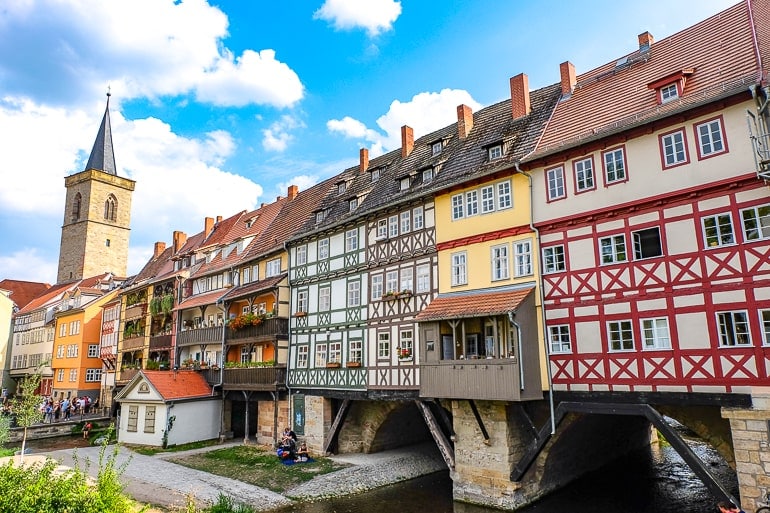
Erfurt is a popular city to visit in the middle of Germany – and it’s also the capital city of the German state Thuringia. We’ve spent some time in Erfurt a few months ago and instantly fell in love with the city. Its size is perfect (in our opinion) – giving you enough things to do without feeling overwhelming.
Maybe you’ve seen photos of one of the city’s most popular attractions, the Krämerbrücke. This bridge is not only pretty to look at and photograph, it’s also unique in the sense that there are buildings on the bridge and when you’re walking on it, you can’t actually see the water running below.
Visiting the bridge and climbing the tower of the Ägidienkirche, a church at one end of the bridge, is something we’d certainly recommend during your time in the city. We actually filmed a short video of our time exploring Erfurt. If you are interested in seeing what parts of the city look like, then you can find our video here .
Getting to Erfurt from Dresden won’t take you too long. It will take approx. 2 hours 20 minutes by car and between 2 and slightly over 3 hours by train .
Accommodation in Erfurt: Since Erfurt isn’t a huge city, there aren’t a ton of accommodations – but certainly more than enough to find one that works for your style and budget. You can check here for hotels and accommodations in Erfurt .
We stayed at Gästehaus in der Gotthardtstraße and really liked our stay. It’s located in a quiet neighbourhood just north of the city centre – a short walk to the Krämerbrücke. The host was lovely, the room was cozy, and there was secure onsite parking for those driving to Erfurt.
If you want to stay RIGHT in the city centre then you should check out Hotel Krämerbrücke Erfurt which is right beside the famous bridge. This might be a good place to stay if you are travelling to Erfurt by train and you’re on-foot.
Must-see Attractions in Erfurt:
- Krämerbrücke
- Erfurt Cathedral
- Citadel Petersberg
For more details, have a look at our Things to do in Erfurt article .
Day 5: Bamberg

Bamberg is a small city – or larger town – in the German state called Bavaria. It’s actually located in a region called Franconia, which is noticeably different from the Bavaria that you might know in the area surrounding Munich, etc.
We’ve been to Bamberg multiple times over the years (it’s also close to the part of Germany where Lisa grew up) and are always happy to come back. Bamberg is known for its cute, historic old town which is actually a declared UNESCO World Heritage Site.
One of the most popular buildings the city has to offer is the Old Town Hall (shown above) which is built on an artificial island. The story behind it is quite interesting.
The drive from Erfurt to Bamberg is doable and will take approx. 2 hrs by car and around 3 hrs by train . On the way, you’ll drive through quite a few tunnels since you’ll drive through an area known as “Thuringian Forest”.
Accommodation in Bamberg: Bamberg is a small place to visit so there aren’t a ton of options but still enough to find what you’re looking for. You can check here for accommodations and hotels in Bamberg .
Anywhere you stay is basically in or close to the old town/city centre. For a place to stay with parking (for those arriving by car), check out Welcome Hotel Residenzschloss Bamberg . It’s located right on the river.
You might also want to see Palais Schrottenberg to stay right in the middle of the Old Town! For reference, the train station is a short walk to the north of the river – not far from these places in the centre.
Must-see Attractions in Bamberg:
- Bamberg Cathedral
- Old Town Hall
- Alte Hofhaltung
If you want some more information about Bamberg, please read our detailed Bamberg, Germany Guide .
Day 6+7: Munich
From Bamberg, your journey will continue to Munich which will be the last stop on this 7 day eastern itinerary. Not only is this the third biggest city of the country, it is also one of the most internationally known destinations in Germany.
Whenever we come back to Munich, we always enjoy our time there. For some reason, the atmosphere always feels more laid back than in other big German cities and the people are usually quite friendly. We might also be a little bit biased, though, since Lisa grew up in this part of the country and is more used to the mentality, dialect etc. than in other parts of Germany.
For this itinerary, you’ll spend two days in Munich since there is quite a lot to see. Next to the obvious attractions like the Marienplatz with the New Town Hall and the Frauenkirche close by, there are also lots of museums and other things that you can explore.
If you’ve already been to Munich before and/or decide that one day in the city is enough for you, you could also opt for a day trip on one of these days. We’ve just recently written a whole Day Trips from Munich Guide , which you can browse through to get some inspiration!
Driving from Bamberg to Munich will take about 2 hrs 20 minutes by car and between 2 and 3 hrs by train . If you decide to only take regional trains instead of the ICE (fast train), you should look into getting the Bayernticket. This can save you some money, especially when you’re travelling with more people.
Accommodation in Munich: Since Munich is so large and popular to visit, there is definitely no shortage of places to stay! You can check here for accommodations and hotels in Munich .
That said, we loved our stay at H2 Hotel München Olympiapark . Located up by the famous Olympic Park, we’d highly recommend it since it was amazing value for money. The breakfast was huge and delicious and there’s a metro station outside the lobby door that takes you into the heart of the old town in minutes. There’s also parking if you are arriving by car.
For a hotel that is a little more central, you should see the Platzl Hotel Superior this hotel is really popular – and for good reason. It’s located around the corner from attractions like Marienplatz and the famous beer hall, Hofbräuhaus.
For more help looking into accommodations and neighbourhoods in Munich, check out our where to stay in Munich guide .
(Check out our guide to one day in Munich if you want more details on things to do and see.)
Germany Itinerary 10 Days
Although we have tried to create short itineraries that allow you to see more than just the standard cities, it is no doubt easier to see more of Germany if you are able to travel for longer than one week. To give you a couple different options that you could look at (and then potentially modify), we have created two 10-day Germany itineraries.
Once again, we believe that ten days would not be enough time to see the whole country – and even if you managed to do that it would be too stressful (in our opinion). Both of the following itineraries give you a good mix of bigger and smaller cities as well as a few interesting day trips. So, have a look and see which one you like better!
Germany Itinerary 10 Days – North
If you’re interested in seeing more of the northern part of Germany and experiencing the mentality and way of life of people in the flatter part of the country, closer to the sea, then have a look at the following 10-day itinerary!
The total driving time would be slightly less than 17 hours with a distance of approx. 1470 kilometres. For these calculations, we have included the day trips to Schloss Drachenburg, Lübeck, and Flensburg. So, if you decide to skip any of these, your driving time and distance would obviously be slightly lower.
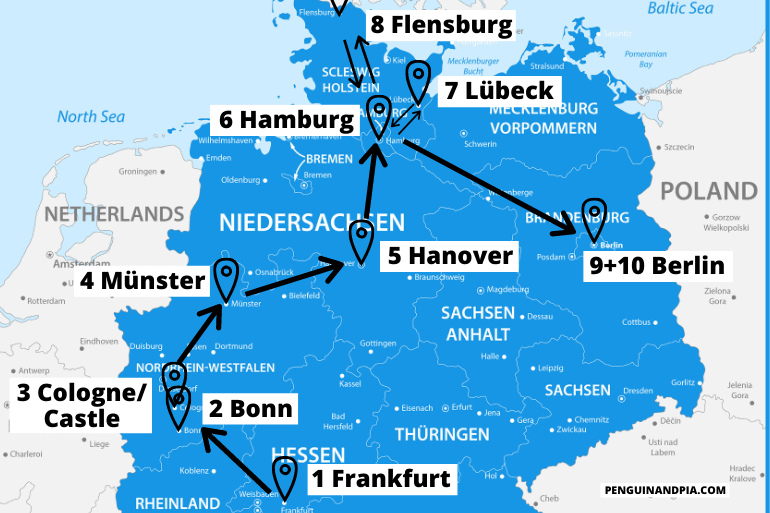
Day 1: Frankfurt Day 2: Bonn Day 3: Day Trip to Schloss Drachenburg / Cologne Day 4: Münster Day 5: Hanover Day 6: Hamburg Day 7: Day Trip to Lübeck Day 8: Day Trip to Flensburg Day 9+10: Berlin
Day 1: Frankfurt
Similar to some of the other itineraries mentioned in this article, we start this 10-day itinerary in Frankfurt. By now you should probably already know why – Frankfurt has the biggest airport of the country which should make it easier for people coming from overseas to get to Germany and start their adventure.
Furthermore, Frankfurt is quite centrally located so it is easy to get to many different cities from here. So even if you decide against following our itineraries step-by-step, Frankfurt would be a good starting point!
— Compare prices from rental car companies in Frankfurt here
Accommodation in Frankfurt : You’ll find plenty of places to stay in Frankfurt. You can check here for accommodations and hotels in Frankfurt .
One really popular hotel in Frankfurt is the Motel One Frankfurt-Römer . This Motel One is near the river and walking distance to lots of things in the city centre. If you are coming to Frankfurt with a car, Motel One has underground parking which can make life easy! They also have a nice breakfast.
A hotel option closer to the train station is Fleming’s Express Hotel Frankfurt . This hotel is just to the north of the main station which makes it a great option if you are arriving by train and have no car. It’s popular because it has a great breakfast and is good value for money.
Day 2: Bonn
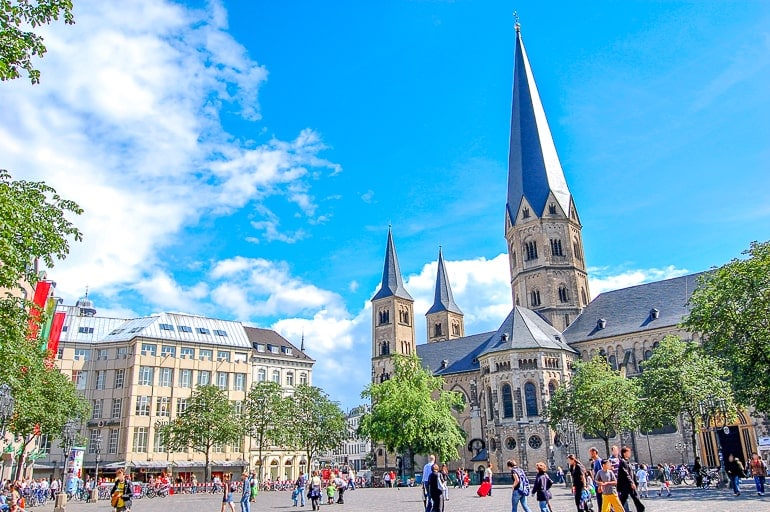
On the second day, you’ll head from Frankfurt to Bonn. As you might know, Bonn used to be the capital of the Federal Republic of Germany during the time that Germany was split into two countries. Later, the capital was relocated from Bonn to Berlin.
If you are interested in learning more about the history of Germany during your time in the country, then Bonn would be a good city to do that in. For example, you could visit the so-called “Haus der Geschichte” which is a museum about the history of the Federal Republic of Germany.
It won’t be difficult to get from Frankfurt to Bonn since the two cities are not too far apart. The journey will take approximately 1 hr 50 minutes by car and between 1 hr 20 minutes and 2 hrs if you take the train . Once again, we’d recommend that you book your train ticket in advance if possible.
Accommodation in Bonn: There are a number of accommodation options in Bonn which you can choose from – many are right in the city centre/old town. You can check here for accommodations and hotels in Bonn .
Keep in mind to book your accommodation for two nights for this itinerary. (You could also spend the following night in Cologne if you day tripped to there, though).
For a great hotel in the heart of the old town, check out BrauHotel Bonn . You can easily walk here from the central train station but they also have a and parking garage close by if you arrive by car. There’s also a craft beer bar on the ground floor!
Another option is the Hilton Bonn . This hotel offers you amazing views of the Rhine River. It’s a bit north of the city centre but still very much close to it. There is parking but it can be expensive so keep that in mind when you book.
Must-see Attractions in Bonn:
- Bonn Minster
- House of the History of the Federal Republic of Germany (Haus der Geschichte)
Day 3: Day Trip to Schloss Drachenburg / Cologne
On day three of this itinerary, you can choose to stay in Bonn, or go on one of two day trips: to Schloss Drachenburg (a castle not far from Bonn) or to Cologne which is also close by.
Schloss Drachenburg is actually a private villa/mansion that was built to look like a castle in the 19th century. Today, it is a popular attraction in the area.
From Bonn, you can either drive to Königswinter by car (and then leave your car at the car park) or take public transport to the Königswinter/Clemens-August-Straße station. You can find more information about that and opening hours etc. on the offical website .
If you are not a huge fan of castles, then you might opt for a day trip to Cologne instead. In this case, you might even decide to change your base and spend the night in Cologne instead of returning to Bonn at the end of the day. That is definitely an option that you can choose since there are lots of accommodation options in Cologne as well.
Getting to Cologne from Bonn will take you around 40 minutes by car (this can obviously depend on traffic) and only approx. 25 minutes by train . Just a quick warning: Trains can get very full if you are travelling during rush hour traffic – so try to avoid that if you don’t like being surrounded by lots of people in a small space.
Day 4: Münster
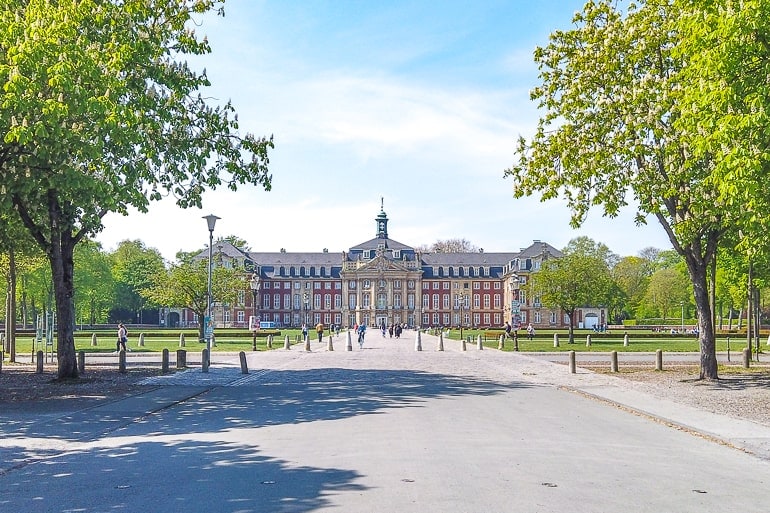
The next day you’ll head from Bonn – or Cologne – to Münster. Since Bonn and Cologne are so close, the journey wouldn’t really differ much from either city.
Münster is a smaller German city that we really enjoy. To be honest, it sometimes reminds Lisa of Copenhagen – mainly because of the many bikes that you can see all around the city. The University of Münster plays a big role in the city and the vibe – depending on which part of the city you are in – is noticeably younger.
One of the highlights of the city – for locals and visitors alike – is the lake Aasee which is located quite centrally. When the weather is nice, there are always people sitting on the grass enjoying the sun and maybe even out on the water (depending on the time of year). You can rent a small paddle boat to explore the lake from a unique perspective.
The journey from Bonn to Münster should take you slightly less than 2 hrs by car and between 2 hrs and slightly more than 3 hrs by train . If you want to save some money and are travelling with other people, then you should look into getting an “NRW Schönes Tag Ticket”. With this ticket, you wouldn’t be allowed to travel on ICE’s (the fast train), but the connections using only regional trains wouldn’t be much longer.
Accommodation in Münster: Münster might feel small but it’s actually pretty spread out and offers accommodations for all styles and budgets. You can check here for accommodations and hotels in Münster .
If you want a popular hotel option right in the centre, the H4 Hotel Münster is a short walk to the heart of the historic centre. It also has onsite parking for those travelling to Münster by car – but you can easily walk there from the train station in the south of the city centre.
Must-see Attractions in Münster:
- Münster Prinzipalmarkt
- Historic Town Hall
- Münster Cathedral
For a more detailed guide, have a look at our Things to do in Münster, Germany article .
Day 5: Hanover
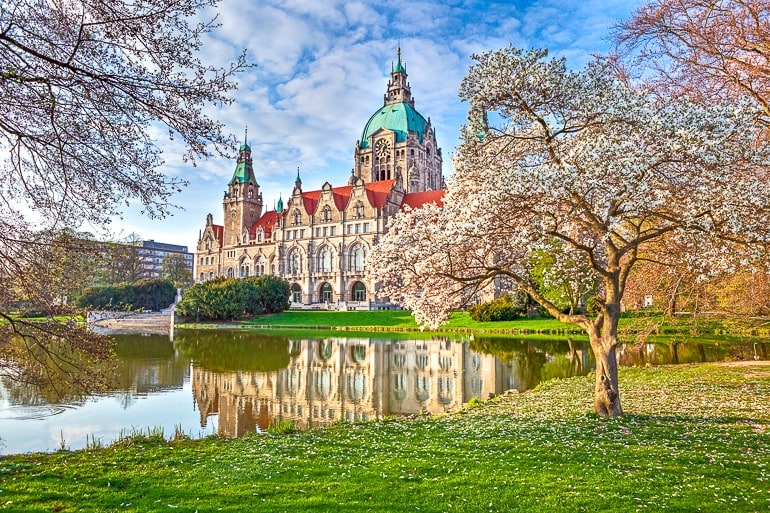
The following day you are travelling from Münster to Hanover. In German “Hannover” is actually written with two “n”, so don’t be surprised if you see it being written slightly differently.
Hanover is the biggest city and the capital of the German state called Lower Saxony. Compared to some other cities on this itinerary it is a less popular tourist destination. To be fair, even we haven’t spent that much time in Hanover yet. Hopefully we’ll be able to change that soon. However, that’s not to say that Hanover is not worth a visit.
Not only can you explore some beautiful gardens and interesting museums in the city, but it is also located pretty much halfway between Münster and Hamburg. That makes it a great stop to break up the journey and spent another day in a city that allows you to explore without too many other (international) tourists around.
By car , the journey from Münster to Hanover will take you around 2 hrs . If you choose to travel by train instead, it will take you approximately the same amount of time .
Accommodation in Hanover: Hanover is a larger city but the accommodation are still relatively packed together in and around the historic city centre. You can check here for accommodations and hotels in Hanover .
For a stay right in the city centre, check out the Hotel Loccumer Hof . This popular hotel is a very short walk from the central station which is perfect if you are arriving to Hanover by train. That said, they also have parking onsite so this hotel works well if you arrive by car!
For another hotel option, check out the Arthotel ANA Prestige am neuen Rathaus . This boutique hotel is directly across from the beautiful New Town Hall in the south end of the city centre by the greenspace and water! They also have a really nice breakfast and parking available.
Must-see Attractions in Hanover:
- New Town Hall
- Marktkirche
- Herrenhausen Gardens
Day 6: Hamburg
On day six of this 10-day itinerary you’re on your way to Hamburg. If you’ve read the details of any of the shorter itineraries in this article, you’ll know that we really like Hamburg.
The city offers modern areas, such as “HafenCity”, mixed with historic (e.g. “Speicherstadt”) and alternative areas (“Sternschanze”) . This makes exploring the city all the more interesting – there is truly something for everyone. During your time in the city, we’d also recommend that you climb the tower of the St. Michael’s Church. From up there, you get a beautiful view of most parts of the city.
The journey from Hanover to Hamburg won’t be long. Depending on the route you are taking (Highway A7 or A1), it’ll take between 1 hr 30 minutes and 2 hrs by car . If you opt for the train , you can expect the journey to take between 1 hr 15 minutes and 1 hr 30 minutes . This depends on the connection you choose.
Accommodation in Hamburg : Hamburg has many, many places to stay. You can check here for accommodations and hotels in Hamburg .
The Mövenpick Hotel Hamburg might be a good option if you have a car while you travel around Germany. This cool hotel is inside an old water tower which gives guests stunning views of the city around. There’s also parking onsite and it’s close to a transit stop for getting around the city.
Located not too far from the central train station, ARCOTEL Rubin Hamburg makes for a good hotel option if you don’t have a car. It’s located in St. Georg which is a lively area within walking distance of the city centre.
Those that need hostel for their stay in Hamburg might be happy with Generator Hamburg . It’s a popular hostel in the city and is close to the train station for easy getting around. If you’re unsure about where to stay, you can always check out our detailed guide on where to stay in Hamburg .
Once again, if you’d like to read our (very) short Hamburg guide, you can find our Things to do in Hamburg article here .
Day 7: Day Trip to Lübeck
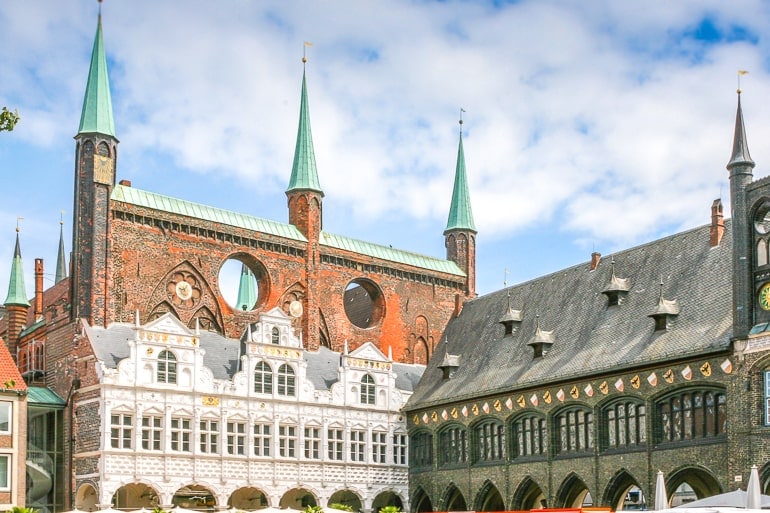
For the next couple of days, we decided to include some day trips from Hamburg. This allows you to stay in one accommodation for longer than just one night and gives you the option to see some more of Hamburg as well. If you don’t want to visit any other cities and want to spend more time in Hamburg instead, then feel free to skip one or both of the day trips mentioned.
Lübeck is the closer one of the two day trips mentioned from Hamburg. Within Germany the city is mainly known for its delicious “Lübecker Marzipan” (Lübeck Marzipan) – but of course there is much more to the city than just that. One of the highlights is the Holsentor, a red-brick city gate dating back to the 15th century.
The journey from Hamburg to Lübeck will take you slightly over 1 hr by car and just around 45 minutes by train . In our opinion, that’s great for a day trip since it gives you lots of time to actually see the city instead of spending a lot of time in the car/on the train.
Must-see Attractions in Lübeck:
- Marienkirche
- Heilig-Geist-Hospital
Day 8: Day Trip to Flensburg
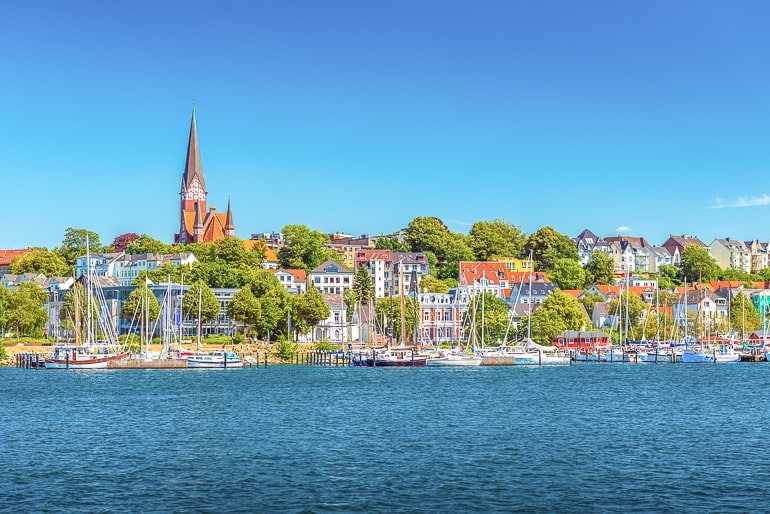
For the following day, we have another day trip option for you. The journey to Flensburg is slightly longer than to Lübeck – but it would be worth it. Flensburg is a smaller German city in the north of Germany, very close to the Danish border.
Since it is located close to the water, shipping plays an important role in the city to this day. If you’re interested in learning more about that, then the Maritime Museum would be a good place for you to visit.
Another thing we would recommend is a walk along the Rote Straße. Here you’ll find different “Hinterhöfe” (similar to backyards) with cute cafes and small shops.
Getting to Flensburg from Hamburg should take slightly less than 2 hrs by car and the same amount of time by train . As already mentioned, it would be a longer journey than to Lübeck, but if you want to experience a smaller, maritime city, the trip would be worth it!
Must-see Attractions in Flensburg:
- Historischer Hafen (Historic Harbour)
- Flensburger Schifffahrtmuseum (Maritime museum)
- Museumsberg Flensburg
Day 9+10: Berlin
On the second to last day of this itinerary, you’ll head from Hamburg to Berlin where your journey ends. This allows you to spend two days in the German capital. Since there is so much to do in Berlin, we’d recommend that you do some research beforehand to narrow down which attractions you’d like to visit.
If you’ve never been to Berlin before classics like the Brandeburg Gate and the Reichstag would be a good place to start. We’ve written a few different articles about Berlin – one about classic attractions (link below). Maybe these will be a good starting point to gather some more information!
The drive from Hamburg to Berlin will be one of the longest mentioned as part of this itinerary – so you should keep that in mind. It’ll take approximately 3 hrs 20 minutes by car (with traffic it could be longer), but just 1 hr 50 minutes by train .
It’s a popular train route since it connects the two biggest German cities so trains run frequently throughout the day. Once again, we’d recommend to book your train ticket in advance to get one of the discount tickets and save some money.
Accommodation in Berlin : As the capital city, there are lots of accommodation options for Berlin. You can check here for accommodations and hotels in Berlin .
Those travelling to Berlin with a car should look into the Park Plaza Wallstreet Berlin Mitte for a hotel in the city centre with free street parking available. There’s always paid parking for a reasonable fee if those are full and you’ll be close to top attractions.
The NH Collection Berlin Mitte am Checkpoint Charlie is a popular hotel option for those coming to Berlin by train since it’s close to attractions in the city centre and you can get there very easily with the metro.
Finally, if you need a hostel/hotel, check out PLUS Berlin . This is where Eric stayed a few years back and really enjoyed it. You’ll be close to the East Side Gallery – the part of the Berlin wall with the artwork on it. It’s also easy to get in and out of the city centre from here.
Also feel free to have a look at our guide on Berlin Attractions and tips for a day in Berlin .
Germany Itinerary 10 Days – South
This 10 day Germany itinerary begins and ends in Frankfurt – so it’s pretty much a small loop through the southern part of the country. If you want to be closer to the mountains (for part of the trip at least) instead of the sea, then this itinerary might be better suited for you than the other 10 day version.
For this itinerary, the total driving time would be slightly over 17 hours with a total distance of approx. 1330 kilometres. This includes the day trips to Neuschwanstein Castle, Garmisch-Partenkirchen, and Tübingen. So depending on if/how you modify the itinerary, these estimates could differ.
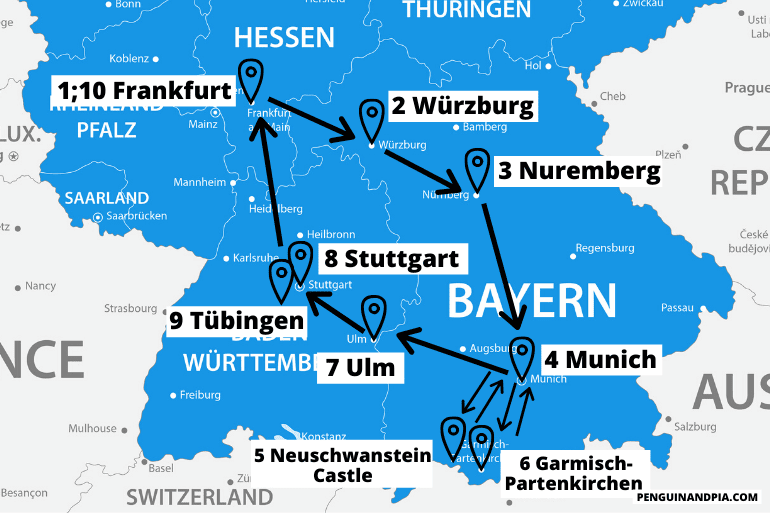
Day 1: Frankfurt Day 2: Würzburg Day 3: Nuremberg Day 4: Munich Day 5: Day Trip to Neuschwanstein Castle Day 6: Day Trip to Garmisch-Partenkirchen Day 7: Ulm Day 8: Stuttgart Day 9: Day Trip to Tübingen Day 10: Frankfurt
Similar to the northern version of this itinerary for 10 days, you begin your adventure in Frankfurt. During your day in the city, you shouldn’t forget to visit the Römerberg with the beautiful half-timbered houses. If you want to get a nice few of the city from above, then you should look into visiting the Main Tower as well.
Frankfurt is also a great place to pick up your rental car – if you decide to complete this itinerary by car instead of using public transport. You can either pick up a car at the airport or at different spots in the city centre. This obviously also depends on the rental company you choose.
Accommodation in Frankfurt: Frankfurt is full of accommodation options – from the city centre to the airport. You can check here for accommodations and hotels in Frankfurt .
For a hotel in the heart of the city, check out the Motel One Frankfurt-Römer . Complete with underground parking, good breakfast, and a top location in the centre and close to the river, this hotel is a decent option if you are travelling around with a car.
For those not travelling with a car (and taking the trains around Germany), check out Fleming’s Express Hotel Frankfurt . This nice looking hotel is really popular for its breakfast, price, and the fact that it’s steps from the central train station.
Day 2: Würzburg
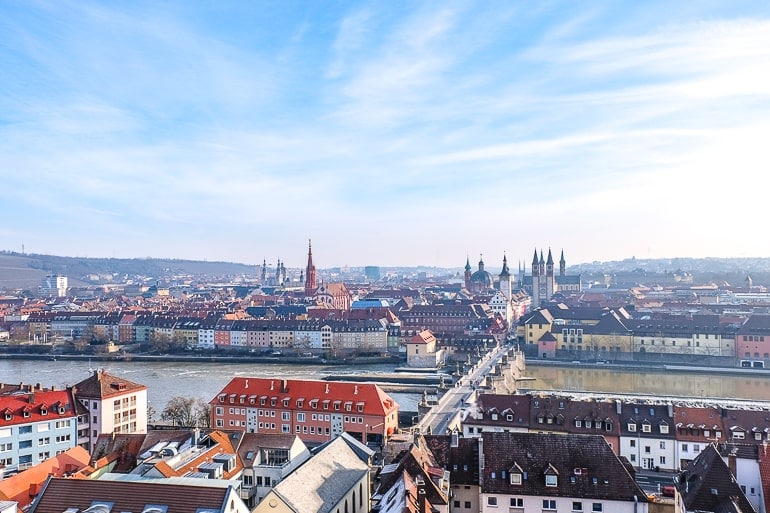
On day two of this itinerary, you’ll be on your way to Würzburg, a small German city that we’re always happy to return to. Similar to Stuttgart, Würzburg is located in a region that is known for its wine.
As such, it comes as no surprise that a highlight in Würzburg is to drink a glass of (white) wine on the Old Bridge across the Main river. We’ve done that multiple times and would especially recommend it during the evening when it gets dark.
Another thing you shouldn’t miss in Würzburg is the short walk up the hill to Marienberg Fortress. Up there you can not only explore the old fortress, but you also get a beautiful view of the old town and other parts of the city.
We actually wrote a whole guide about Würzburg (link below) where we not only talk about things to do but also mention some great cafes and restaurants!
The drive from Frankfurt to Würzburg will be a short one. It should only take you around 1 h 20 minutes by car and between 1 h 07 minutes and 1 hr 50 minutes by train depending on the type of train you’re taking (ICE vs. regional train).
Accommodation in Würzburg: Würzburg isn’t a huge city so you’ll find a number of places to stay packed together in the city centre and a number of other hotels and guesthouses around. You can check here for accommodations and hotels in Würzburg .
On a recent trip, we stayed at the Best Western Hotel Würzburg-Süd . It’s a little south of the city centre but the tram stop is right outside the hotel so you’re into the historic city centre in minutes. There is also an onsite parking lot if you’re arriving to Würzburg by car. We booked this one last minute but we would stay again.
If you want to stay a little more central, then you can check out Hotel Strauss . With a location close to the river, the train station, and the city centre – it’s a great option fo those arriving by train.
We also once stayed at Hostel Babelfish for a budget accommodation and it was honestly not too bad, either. It’s right across from the train station for easy access in and out of the city.
Must-see Attractions in Würzburg:
- Marienberg Fortress
- Würzburg Residence
If you want more tips for visiting Würzburg, have a look at our detailed Things to do in Würzburg Guide (+ insider tips) .
The next day you’ll be on your way to Nuremberg, which is another city in Bavaria that we really like. In German, Nuremberg is actually written/called “Nürnberg” – just an FYI, so you’re not confused when you see this written somewhere.
As we have already mentioned in the description of one of the shorter itineraries, there is a lot of history to be found in the city. Not only can you explore an old castle in the middle of the city, you can also learn a lot about Germany’s dark history if you’re interested.
Getting from Würzburg to Nuremberg will take approx. 1 hr 20 minutes by car and between 53 minutes (ICE) and 1 hr 13 minutes (regional) by train . If you’re travelling with more people and decide to just take a regional train, look into getting a “Bayernticket” as that could save you some money.
Accommodation in Nuremberg : Nuremberg is a larger and well-travelled city in Germany so you will have no problem finding a place to stay! You can check here for accommodations and hotels in Nuremberg .
We ended up staying in the very popular Five Reasons Hotel and Hostel and we enjoyed our stay. The room was bright with new furnishings. It’s also located just inside the old city walls so we were close to the metro, a short walk to central train station, and also close to the heart of the old town!
Very nearby was the Sheraton Carlton Nuremberg – we had friends stay there. They really liked this hotel which had a swimming pool with city views and other great perks. If you are arriving to Nuremberg by car, there’s a parking lot across the street from the hotel as well as street parking around. The train station is very close as well so it’s a great location overall.
- Documentation Center Nazi Party Rally Grounds
Day 4: Munich
On day four of this Germany trip, you’ll be on your way to Munich. As you might know Munich is the capital of the German state called Bavaria and there are lots of things to do in this city.
That’s why you’ll spend three nights in Munich. This way you can explore the city in more detail if you want or go on a couple of day trips from Munich to see other popular attractions as well. It’s really up to you.
The journey from Nuremberg to Munich won’t be overly long and it’s a route Lisa has driven many times. It’ll take you around 2 hrs by car (of course traffic depending) and between 1-3 hrs by train.
Since this is a popular train route, there are lots of different connections of varying length – some are quick and others are slower trains with more stops. Since that’s the case, we’d recommend that you plan in advance and try to catch a better connection to avoid an unnecessarily long train ride!
Accommodation in Munich: Since Munich is such a popular and large city, there are plenty of accommodation options for you to choose from. You can check here for accommodations and hotels in Munich . Just remember to book your accommodation for three nights if you are following this itinerary!
We stayed at the H2 Hotel München Olympiapark which is a very popular hotel because of the price and the value. It was a prefect stay. The breakfast was amazing, they had parking, and the location was great – only a quick metro to the heart of the city centre. You also have the Olympic Park and BMW Museum as top attractions nearby!
If you’re itching to stay right in the heart of the action in Munich, check out the Platzl Hotel Superior . This is a hotel around the corner from Marienplatz in the old town with the famous beer hall Hofbräuhaus just steps away. The central train station is also walkable from here.
Of course, you can learn all about the best areas to stay in more detail with our Munich accommodation and neighbourhood guide .
Learn more about Munich with our one day in Munich post!
Day 5: Day Trip to Neuschwanstein Castle
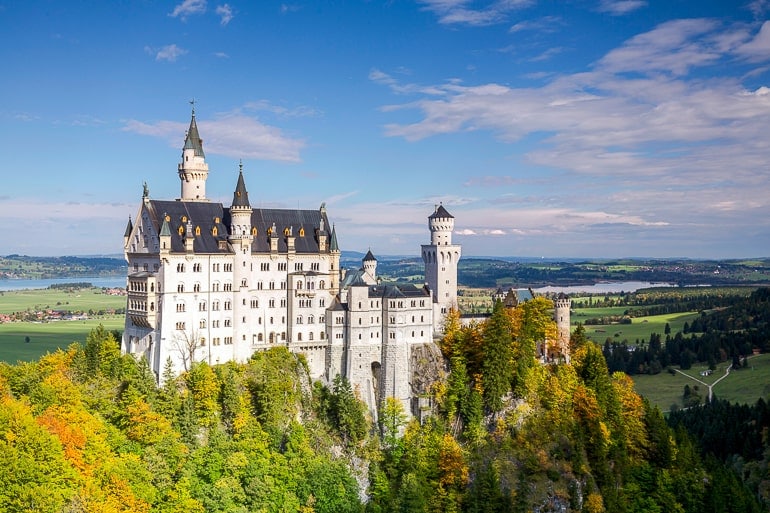
Neuschwanstein Castle probably doesn’t need a lot of introduction – it is arguably one of the most popular day trips from Munich. If you want to see this fairy-tale castle with your own eyes, then this day trip might be for you.
However, it is such a popular attraction that depending on the time of year it can get incredibly crowded. So if you are planning this itinerary for the middle of summer, we’d honestly recommend that you think twice about whether you really want to do this day trip. A second day in Munich wouldn’t be so bad either, would it?
If you are set on visiting Neuschwanstein Castle, then have a look at our Day Trips from Munich Guide . In that article – under the Neuschwanstein Castle section – we talk about all the different ways you can get to the castle.
In case you don’t want to stress too much about logistics and are not travelling with a rental car, you could always look into a day tour that brings you to Neuschwanstein Castle and then back to Munich. Here are some examples:
- Neuschwanstein and Linderhof Palace – A very popular tour to check out two castles in one day!
- Just Neuschwanstein Castle – Grab your live guide and check out the classic castle you came to see!
- Neuschwanstein Castle and Füssen – Explore the surrounding area on this day trip + see that great castle!
Day 6: Day Trip to Garmisch-Partenkirchen
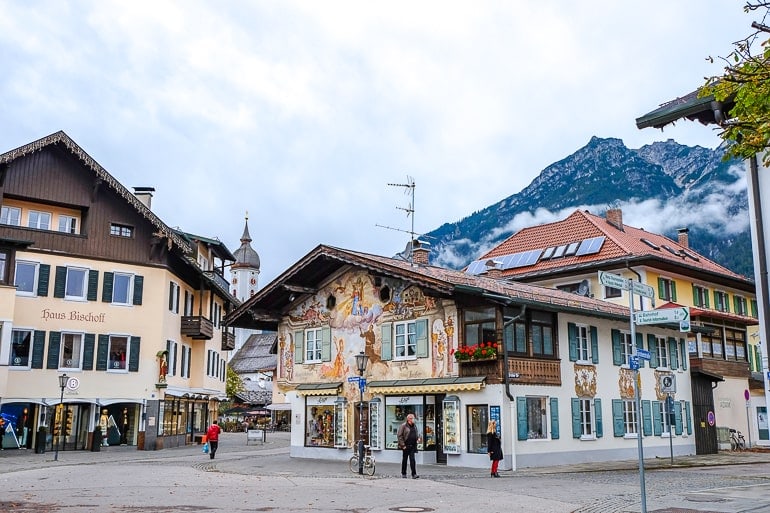
Another popular day trip from Munich – and the one we would recommend for Day 6 of this itinerary – is a trip to Garmisch-Partenkirchen in the south of Bavaria, close to the Austrian border.
We have been to Garmisch-Partenkirchen recently and really enjoyed our day there. However, that was during the shoulder season, so we can’t really say much about how busy it gets in the summer or during the ski-season.
There are a few good reasons for visiting Garmisch-Partenkirchen. The obvious one is that the town is super close to the mountains and it is very easy to reach the “Zugspitze” (Germany’s highest mountain) from here.
Of course, you don’t have to go that high up – there are also lots of other mountains and great hiking trails in the area if you’re looking for a day in nature.
Other reasons why people come to Garmisch-Partenkirchen is to visit the Partnach Gorge which is quite beautiful and/or the old town where you can admire the decorative paintings found on many houses.
It’s actually quite easy to get from Munich to Garmisch-Partenkirchen. By car , it should take you around 1 hr 10 minutes and by train the journey would be approx. 1 hr 22 minutes . It’s actually a nice drive/train ride since you’ll get some great views of the mountains as you get closer to your destination.
Must-see Attractions in/close to Garmisch-Partenkirchen:
- Partnach Gorge
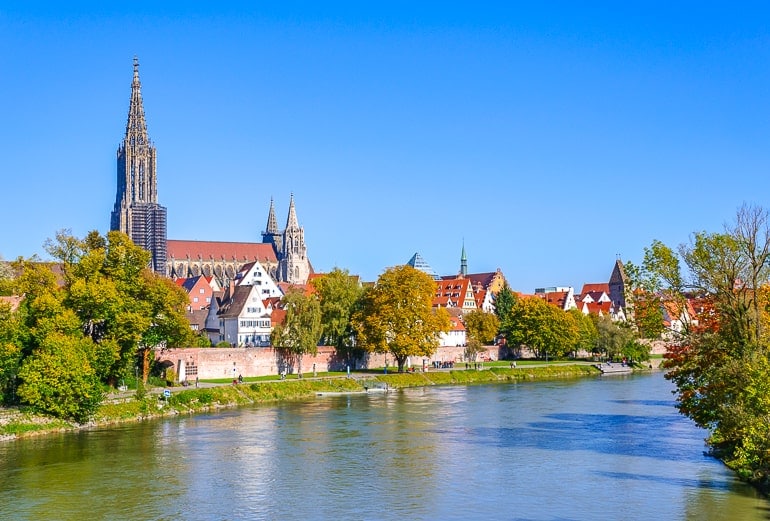
The following day you’ll travel from Munich to Ulm, a small city in the German state of Baden-Württemberg. It is actually located right by the border with Bavaria – “Neu Ulm” in fact is a city on the Bavarian side. When you’re there, it sometimes feels like it is just one bigger city. For you as a visitor, this doesn’t really matter – just an interesting side note.
Ulm is mainly known for having the church with the tallest steeple in the world – so that is something you shouldn’t miss during your visit. Other than that, we’d also recommend that you check out the Fishermen’s Quarter where you can find some beautiful, half-timbered houses.
Getting from Munich to Ulm won’t take you long. The journey will take approx. 1 hr 40 minutes by car and between 1 hr 19 minutes and 2 hrs by train. Once again, this depends on which type of train connection you choose (ICE vs. regional trains).
Accommodation in Ulm: It’s best to stay in the centre of Ulm since it’s not huge and the attractions can mostly be found there. You can check here for accommodations and hotels in Ulm .
For a boutique hotel option right in the city centre, check out Boutique 005 Ulm City . This hotel is super walkable to the train station if you are arriving by train but also offers an option for parking. It’s location makes it really close to all the top attractions in the city.
For a stay closer to the river, you can check out the Hotel am Rathaus – Hotel Reblaus . With onsite parking available and a really good breakfast, this more “authentic” hotel is an experience not to be missed in Ulm.
Must-see Attractions in Ulm:
- Ulmer Münster
- Fishermen’s Quarter
Day 8: Stuttgart
From Ulm, you’ll head to Stuttgart on the next day. Stuttgart is a city that we have mentioned a few times in this article already. If you’ve read some of the other itineraries, you’ll know that Stuttgart is known for both cars and wine.
Of course, there’s more to see in the city than that. If you’re interested in architecture, you might enjoy visiting the New Palace at the “Schlossplatz” and if you’re into art, the Staatsgalerie (an art museum) might be for you.
Getting to Stuttgart from Ulm will only take slightly over 1 hr by car and approx. the same amount of time by train . There are slower trains – called RB instead of RE which stands for “Regional Express” – that take longer than that. However, if you plan ahead, you shouldn’t have a problem catching an RE or ICE Train since they run frequently throughout the day.
Accommodation in Stuttgart: Since there are a number of places to stay in, you can check here for accommodations and hotels in Stuttgart .
Those with a car can check out the Abalon Hotel ideal because it has an underground parking garage while those travelling to Stuttgart by train can check out the Pension am Heusteig since it’s easy to get to walking or with the metro.
Day 9: Day Trip to Tübingen
On day 9 of this itinerary, you have the choice between either spending a second day in Stuttgart or taking a day trip to Tübingen, a university town not far away.
Tübingen is a popular day trip from Stuttgart and is mainly known across the country for its old university. In fact, some of Lisa’s friends have studied there. When in town, you shouldn’t forget to visit the market square with its 15th century town hall. Another popular attractions is the Hohentübingen Castle on the hill which nowadays is home to a museum.
It won’t take you long at all to get to Tübingen from Stuttgart. That makes it great for a (half-)day trip. The journey should only take around 42 minutes by car and between 43 minutes and 1 hr 30 minutes by public transport – depending on the connection you choose.
Must-see Attractions in Tübingen:
- Hohentübingen Castle
- Market Square with Town Hall
- Hölderlinturm
Day 10: Frankfurt
On the last day, you’ll make your way back to Frankfurt. This is where your itinerary ends since it will hopefully be easy for you to get back home from here.
The journey from Stuttgart back to Frankfurt will probably be the longest one for this trip – but it’s still easily doable. It should take you approx. 2 hrs 25 minutes by car and between 1 hr 17 minutes and 3 hrs 30 minutes by train. Once again, this is dependent on the connection you choose (ICE vs. regional trains).
Accommodation in Frankfurt: Since you’re back in Frankfurt, we already went over accommodations in Day 1 of this same itinerary. That said, you can check here for accommodations and hotels in Frankfurt and specifically check out the Motel One Frankfurt-Römer for a central hotel with parking.
Germany Itinerary 14 Days
This Germany itinerary is the longest one that we have for you – for now. If anyone is interested in a 21 day version, please let us know!
The distance you’d cover with this 14 day itinerary would be around 1960 kilometres . The driving time would be approx. 22.5 hours – but of course, this varies depending on traffic and the exact route you decide to take.
As you’ll see below, sometimes the driving time between two cities is longer than 3 hours. So, while this itinerary is totally doable in two weeks – if you wanted to slow down the pace a bit, you could just as easily spend more time in some of the cities and complete the itinerary in more days.
Since you have probably already read about most of these places in some of the itineraries above, we’ll try to keep the descriptions short and not get too repetitive.
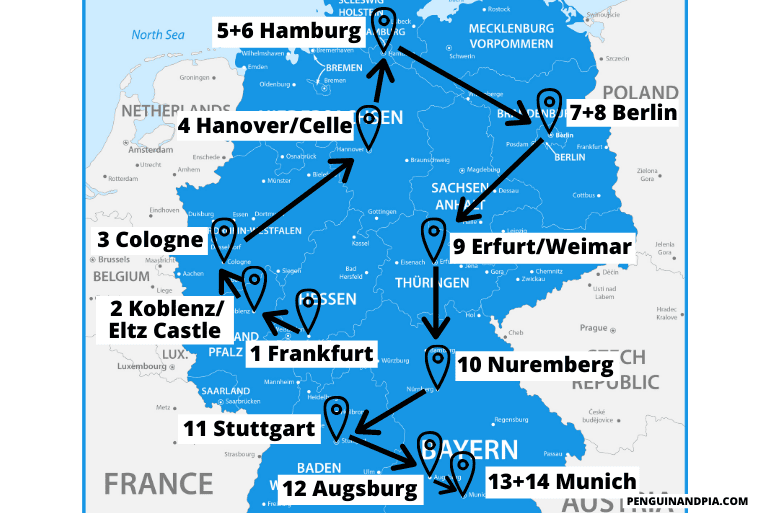
Our version here is written as an “incomplete route” from Frankfurt to Munich. However, as with most of our itineraries, you are welcome to reverse the direction if that works better for you and/or start and end in the same city. So, to see a big part of the country, your 14 day Germany itinerary could look something like this:
Day 1: Frankfurt Day 2: Koblenz / Eltz Castle Day 3: Cologne Day 4: Hanover or Celle Day 5+6: Hamburg Day 7+8: Berlin Day 9: Erfurt or Weimar Day 10: Nuremberg Day 11: Stuttgart Day 12: Augsburg Day 13+14: Munich
Once again we begin this itinerary in Frankfurt since it is an easy city to get to. As we have mentioned before, there are a few things to see in the city so you can start exploring on day one!
Frankfurt is also a great city to pick up a rental car. Since many international (business) travellers fly into Frankfurt, there should be many cars available with automatic transmissions. In smaller German towns you’ll find that this is not always the case.
Accommodation in Frankfurt: If you are making a stop in Frankfurt, you can check here for accommodations and hotels in Frankfurt .
As for accommodation options, the Motel One Frankfurt-Römer has parking available and is located in the city centre close to the Main River. That’s important if you have a car with you but it’s also walkable to the train station, so you know.
Another great hotel option that is even closer to the train station is Fleming’s Express Hotel Frankfurt . This hotel is known for its prime location to the north of the station, its tasty breakfast, nice decor, and fair price. This is definitely a popular place you should at least look into if you are travelling by train around Germany.
Day 2: Koblenz / Eltz Castle
On day two of this itinerary, you’ll be on your way to Koblenz, a small German city on the Rhine river. You can either explore the city or use it as a base to visit one of the many castles close by.
Our suggestion would be a visit to Eltz Castle which is a beautiful medieval castle surrounded by a forest. Please keep in mind that the castle is not open year round. You can check opening hours here .
You could also visit Eltz Castle as a day trip from Frankfurt but then you’d have to return to Frankfurt at the end of the day. This wouldn’t make much sense unless you want to spend some more time in Frankfurt anyway, as Cologne (your next destination) is closer to Koblenz and Eltz Castle than Frankfurt.
The drive from Frankfurt to Koblenz should take around 1 hr 30 minutes by car . If you want to take the train , the journey would take between 1 hr 30 minutes and 2 hrs 15 minutes . From Koblenz, it is only about a 30 minute drive to Eltz Castle.
Accommodation in Koblenz: Since Koblenz isn’t that large, you should have no problem finding and choosing an accommodation that works for you. You can check here for accommodations and hotels in Koblenz .
If you want a popular option right in the heart of the city centre, you should see the Sander Hotel . This hotel is located within walking distance to the rivers as well as restaurants and shops in the centre. If you travel by car to Koblenz, they have onsite parking which is handy. That said, you can also easily walk from the hotel to the train station in minutes.
Day 3: Cologne
The next stop on your 14 day Germany itinerary is Cologne, a city we have mentioned already in some of the previous itineraries. As you might know, the highlight of the city is the Cologne cathedral which is quite an impressive sight. As the city is located on the Rhine river, a boat tour might also be a great activity depending on the time of year you are visiting.
Getting to Cologne from Koblenz takes around 1 hr 15 minutes by car and between 50 minutes and 1 hr 15 minutes by train . The train tracks follow the Rhine river for part of the journey which allows for some beautiful views!
Accommodation in Cologne : There are lots of great places to stay in Cologne. You can check here for accommodations and hotels in Cologne .
We recently stayed at the Lindner Hotel City Plaza which was great value for money. The breakfast buffet is incredible and it’s an easy, short walk into the city centre near the Cathedral. It also has parking available for those with a car.
If you want to stay a little closer to the river and the Old Town, check out the CityClass Hotel Residence am Dom . With many things around to keep you busy – like attractions, food, and/or drinks – you’re just a short walk to the central train station if you stay here.
For those looking for a hostel, Cologne Downtown Hostel was a great stay for Eric a number of years ago. It’s really popular, in a great location, and has a nice rooftop balcony to enjoy.
Day 4: Hanover or Celle
Day 4 of this itinerary will take you to either Hanover or Celle depending on your preference. Celle is a noticeably smaller city/town than Hanover and the two places are only a few minutes apart.
Getting from Cologne to Hanover will take approximately 3 hrs 10 minutes by car and between 2 hrs 40 minutes and 3 hrs 5 minutes by train .
Accommodation in Hanover: Since Hanover is a well-travelled city for people moving around Germany, there are a number of accommodation options in and around the city centre. You can check here for accommodations and hotels in Hanover .
To stay very close to the central train station in the city centre, you should see the Hotel Loccumer Hof . The location makes it great if you are travelling by train and on foot. They also have onsite parking if you are arriving to Hanover with a car!
To the south of this hotel, the Arthotel ANA Prestige am neuen Rathaus is an option right across from the New Town Hall. This hotel has a beautiful, light style and is also close to the water/parks. Complete with breakfast and onsite parking, you can’t go wrong here!
If you want to spend a night in a smaller German city instead, then Celle is a good option as it is not far from Hanover. That will make it easy to reach the next stop on your itinerary without too much of a detour. The journey from Cologne to Celle would be slightly longer and take around 3 hrs 30 minutes by car and 3 hrs 19 minutes by train .
Accommodation in Celle: Celle isn’t that big at all – so there are only a handful of places to stay. That said, there are still some great options. You can check here for accommodations and hotels in Celle .
Of note, check out Hotel Borchers . This hotel – one of only a handful located in the heart of “city centre” is a top pick with a tasty breakfast and an underground car park. You can also walk there from the Celle train station which is located not too far across town.
Must-see Attractions in Celle:
- Celle Castle
- Bomann Museum
- French Garden
Day 5+6: Hamburg
An itinerary across a large part of the country wouldn’t really feel complete without including Hamburg. Since there is quite a bit to see in this hanseatic city, you’ll spend two nights in the city to give you more time to explore.
Getting from Hanover to Hamburg will take you approx. 1 hr 45 minutes by car and between 1 hr 15 minutes and 2 hrs 30 minutes by train . As mentioned before, this varies depending on the type of train connection you choose.
The journey from Celle to Hamburg will be approximately 15 minutes shorter at 1 hr 30 minutes by car . If you opt for the train, you can expect travel times between 1 hr 10 minutes and 2 hrs .
Accommodation in Hamburg : Since Hamburg is a well-travelled city, it makes sense that there are loads of places and areas to stay in. You can check here for accommodations and hotels in Hamburg .
The Mövenpick Hotel Hamburg might work for those with a car since they have onsite parking. This old water tower is a different hotel than you might be used to but it’s a great experience overall.
Something closer to the central station to get to on foot would be the ARCOTEL Rubin Hamburg which is located in St. Georg. This is an area with shops and restaurants and is very much part of the city centre.
Those looking for a budget accommodation can check out Generator Hamburg which is a popular hostel close to the train station. If you’re ever unsure or want more advice, we have a detailed guide on where to stay in Hamburg .
Day 7+8: Berlin
Of course, we couldn’t forget to include a stop in the capital of the country when planning a longer trip through Germany. Since there is so much to do and see in Berlin you will spend two nights there.
This will also give you some more time to recover from all the driving you have done so far on this journey. Getting from Hamburg to Berlin takes approximately 3 hrs 20 minutes by car (obviously traffic depending) and just about 1 hr 50 minutes by train .
Accommodation in Berlin : There are lots of hotel options in Berlin. You can check here for accommodations and hotels in Berlin .
The Park Plaza Wallstreet Berlin Mitte is a good option in the city centre for those coming to Berlin with a car while the NH Collection Berlin Mitte am Checkpoint Charlie is located right at the attraction “Checkpoint Charlie” in the city centre.
A great option for a hostel/hotel where Eric stayed a few years back is PLUS Berlin . You can find it near the famous East Side Gallery which is a very popular attraction to check out.
As mentioned a few times now, we also have more articles on t hings to see in Berlin and a one day Berlin itinerary .
Day 9: Erfurt or Weimar
For the following day you have the choice between Erfurt or Weimar as your next destination. Both are small cities in the state of Thuringia with Weimar being smaller than Erfurt. If you know anything about Martin Luther, an important figure in the Protestant reformation, then you might have heard of one or both of these places before.
If you’re looking for a place with a beautiful old town and some nice churches as well as buildings for you to explore, then we’d really recommend Erfurt. We had a great time during the days we spent there. The city also has some really nice, cozy cafes if that is something that you care about.
Getting to Erfurt from Berlin will take a while – but it is a great stop on the way to the south of Germany. You can expect the journey to take approx. 3 hrs 40 minutes by car and just around 1 hr 50 minutes by ICE (fast train) .
Accommodation in Erfurt: With Erfurt being a smaller city with a smaller central area to explore, finding a place to stay isn’t too difficult. You can check here for hotels and accommodations in Erfurt .
When we visited Erfurt, we booked the Gästehaus in der Gotthardtstraße . This was a simple guesthouse with a nice host and cozy rooms located just a short walk north of the Krämerbrücke. There’s also a small parking lot onsite if you’re coming to Erfurt with a car.
For a stay that is more central, check out Hotel Krämerbrücke Erfurt . It’s located basically right beside the Krämerbrücke making it a great option if you are travelling by train and you’re on foot.
Once again, if you want to learn some more about Erfurt before you visit the city, check out our detailed Erfurt Guide here .
If you instead preferred to learn some more about the well-known German writers Goethe and Schiller – or about Germany’s dark past – then you should plan to visit Weimar instead.
Two of the highlights there are Goethe’s and Schiller’s House – now turned into museums. Close to Weimar there’s also the Buchenwald Memorial which was a former Nazi concentration camp. This was the first KZ-Memorial Lisa ever visited. It was a somber experience, but also an important one in regards to understanding more about Germany’s past.
The journey from Berlin to Weimar will be slightly shorter than to Erfurt – at least by car. It’ll take approx. 3 hrs 15 minutes by car and around 2 hrs 20 minutes by train .
Accommodation in Weimar : There are a handful of places to stay in Weimar since it’s a smaller city – but you still have good options. You can check here for accommodations in Weimar .
In particular, check out Amalienhof Hotel und Apartment . This classic and very popular hotel is just south of the heart of the city centre. It features parking onsite and an excellent breakfast. It’s also not too far to walk to the train station if you are arriving on foot.
Must-see Attractions in/close to Weimar:
- Buchenwald Memorial
- Goethe’s House
- Schiller’s House

Day 10: Nuremberg
On day 10 of your itinerary, you’ll drive – or take the train – from Erfurt/Weimar to Nuremberg. This Franconian city has also been mentioned in some of the shorter itineraries.
The journey from Erfurt to Nuremberg will take approx. 2 hrs 40 minutes by car in a southern direction. The drive from Weimar to Nuremberg will just be a couple minutes longer.
If you decide to take the train, the journey would take between 1.5 hrs and 2 hrs from Weimar and between 1 hr 10 minutes and 1 hr 30 minutes from Erfurt .
Accommodation in Nuremberg : Nuremberg is a city with loads of history and attractions so it’s very popular. As such, you will find hotels and accommodations all over the city – from the old town to the surrounding areas. You can check here for accommodations and hotels in Nuremberg .
We booked a stay at Five Reasons Hotel and Hostel and we would recommend it. You can find the place inside the massive old city walls so the location was great – walkable to the central train station and also to go find top attractions.
On the same trip, friends of our stayed at the Sheraton Carlton Nuremberg . It was close to where we stayed and they really enjoyed it. There’s this great pool on an upper floor with city views as well as a parking lot across the street if you travel to Nuremberg by car. The train station is close as is the old town by walking so it’s great option overall, too.
Day 11: Stuttgart
The following day you will be on your way from Nuremberg to Stuttgart – once again, a city we have mentioned multiple times now during this article. From Nuremberg, it’ll take you around 2 hrs 15 minutes by car and between 2 hrs 10 minutes and 2 hrs 30 minutes by train to get to Stuttgart.
As we’ve mentioned before, if you are driving and have the time, you could take a small detour and stop in Rothenburg ob der Tauber for a stroll through its beautiful old town. We’ll leave that up to you!
Accommodation in Stuttgart: You can check here for accommodations and hotels in Stuttgart .
The Abalon Hotel ideal has parking for those with a car while the Pension am Heusteig is a guesthouse close by but is easy to get to by the metro system if you arrive by train to central station and you are walking.
Day 12: Augsburg
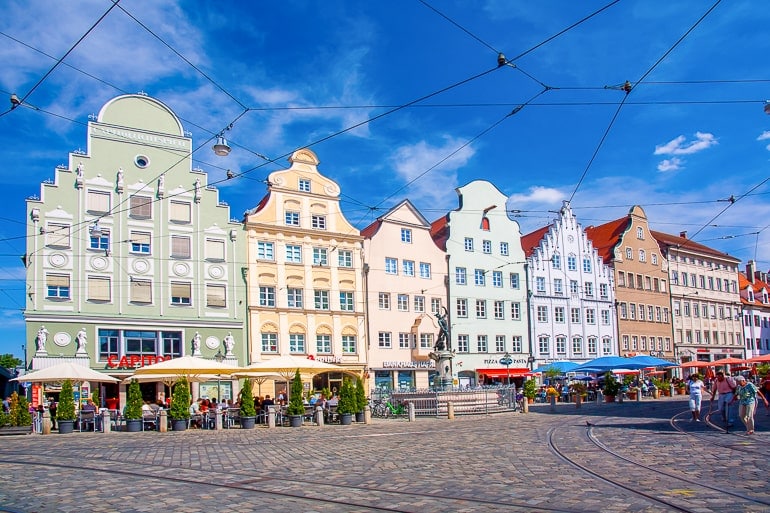
On day 12 you’ll be on your way from Stuttgart to Augsburg, a small city in Bavaria and one of Germany’s oldest cities. Around Germany, most people have heard of Augsburg because of its “Fuggerei” – a historic social housing complex where rent has increased very slowly over the centuries. It’s certainly worth a visit!
It’ll take you around 2 hrs by car to get from Stuttgart to Augsburg. If you opt for the train , then you can expect the journey to take approx. 1 hr 40 minutes .
Accommodation in Augsburg: In Augsburg, you will find a number of places to stay around the city centre. You can check here for accommodations and hotels in Augsburg .
For a reliable stay, check out Hotel Augusta . This popular hotel – located right in the city centre – features breakfast and has parking available if you are travelling to Augsburg by car.
The nice thing about Augsburg is that because it’s a smaller city, you can easily walk to the hotel from the train station if you are arriving by train.
You might also check out City Hotel Ost am Kö which is another hotel in the heart of the centre walkable to the station. It also has breakfast and parking garage right nearby.
Must-see Attractions in Augsburg:
- Augsburg Cathedral
- Perlach Tower
Day 13+14: Munich
On your second to last day of this itinerary you will drive from Augsburg to Munich. That’s the last stop on your two week Germany adventure. In Munich, there is more than enough to see to spend two days in the city.
Munich also has an airport with good international connections in case you’re coming from overseas and need to take a plane to get back home. If that’s not the case, we’d encourage you to see whether the train would be an alternative to get you back home as well.
The journey from Augsburg to Munich should take just less than 1 hr by car and between 30 and 48 minutes by train. So it’s certainly one of the shortest transitions mentioned in this article.
Accommodation in Munich: If you’re exploring Munich while in Germany, there is no shortage of places to stay and areas to check out. You can check here for accommodations and hotels in Munich . For this itinerary, remember to book your Munich accommodation for two nights.
We really liked our stay at the H2 Hotel München Olympiapark . From the really good breakfast, nice rooms, and excellent location with metro access nearby – you cannot beat the price for Munich. There’s also parking available if you’re travelling with a car to Munich.
For a spot right in the heart of Munich’s charming old town, check out the Platzl Hotel Superior . This is a trendy hotel that puts you super close to all the action at busy Marienplatz and is steps from Hofbräuhaus, the beer hall made famous decades ago. You can also catch the metro or walk to the central train station from here.
If you are looking for more details on accommodations in this city, we wrote a detailed guide on where to stay in Munich .
To learn more about the city – as we have mentioned before – check out our post on Munich in a day if you want more details about the city!
And there you have it – one massive Germany guide with more than one Germany itinerary to suit your travel needs! Whether you’re looking for a short 5 day or a wild 14 day itinerary – we’re sure you’ll have a great time exploring Germany. We’re actually really happy to have created this post – Lisa especially. It’s always fun to help others explore your home country!
As always, Happy Germany Itinerary Waddlin’, – L&E
- Compare flights on Skyscanner
- Check for Hotel Deals or Book A Hostel
- Get A Rental Car (depending on the destination)
- Research plug types and possibly get a travel adapter
- Go over our packing list
Pin it for later!
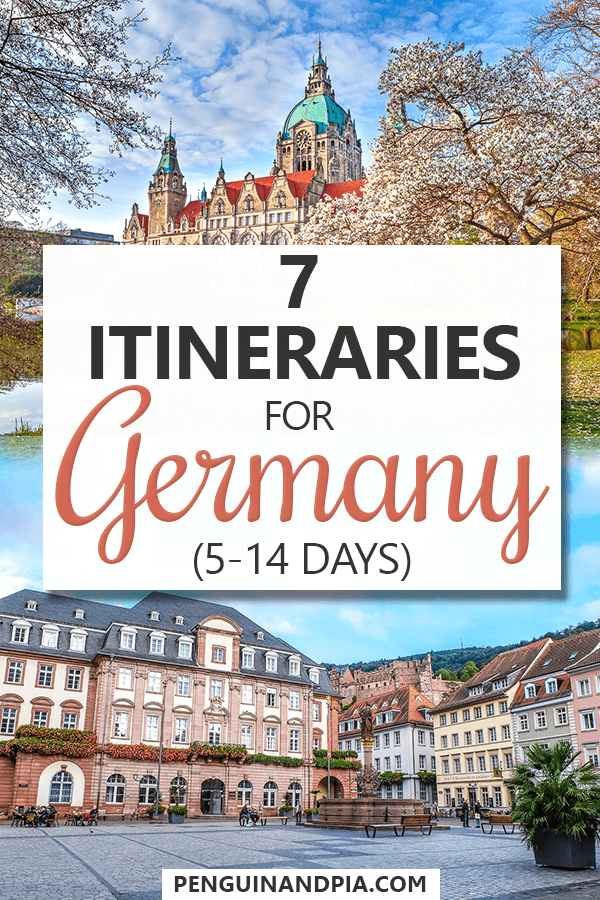
As an Amazon Associate we earn from qualifying purchases.
Destinations
Privacy policy
Disclaimer & Affiliate Disclosure
Terms of use
© 2024 Creativlier Media Inc.
- Travel Planning Guide
A Travel Price Comparison for Families, Couples, and Backpackers Switzerland vs. Germany for Skiing, Hiking, Families, and Museums & Attractions

- Pros & Cons
- Museums & Attractions
- Culture & History
- Small Towns
- Christmas Markets
- National Parks
- Adventure & Outdoor Activities
- Outdoor Activities
- Backpackers
- Transportation
- More time in Switzerland or Germany?
- Which is Cheaper, Switzerland or Germany?
- What are the cheapest places in Switzerland or Germany?
- How can you save money in Switzerland or Germany?
- When to Visit Switzerland or Germany?
- Weather: Switzerland vs. Germany
Should you visit Switzerland or Germany?
Which is cheaper to visit which is more expensive for vacation.
Which country should you visit? Read on to compare the activities as well as the prices of travel for Switzerland and Germany. We'll break down costs for accommodation, food, transportation and more to help you learn more about these two destinations. Then, you can figure out if either of these two places are accessible based on your travel budget, schedule, and interests. So, let's dig into it.
We'll start with a quick overview, and below we will go into all of the details.
Both Germany and Switzerland have fascinating cultures, delicious food, and impressive scenery. Switzerland is significantly more expensive than Germany, and some people say it is one of the most expensive countries in Europe. For many, Switzerland is worth the high price tag. The scenery is dramatic and beautiful, the mountain towns are charming, and the winter sports are thrilling. But if you're a budget conscious traveler, then Germany has a lot to offer visitors as well. Although the scenery is not quite as dramatic as Switzerland, it is more diverse in Germany. Germany is also a very efficient country to visit. Trains and buses are reliable and run like clockwork. The cities are very clean and modern and the facilities are comfortable. Switzerland is also modern, clean and comfortable, but it does come with a higher price tag.
Switzerland
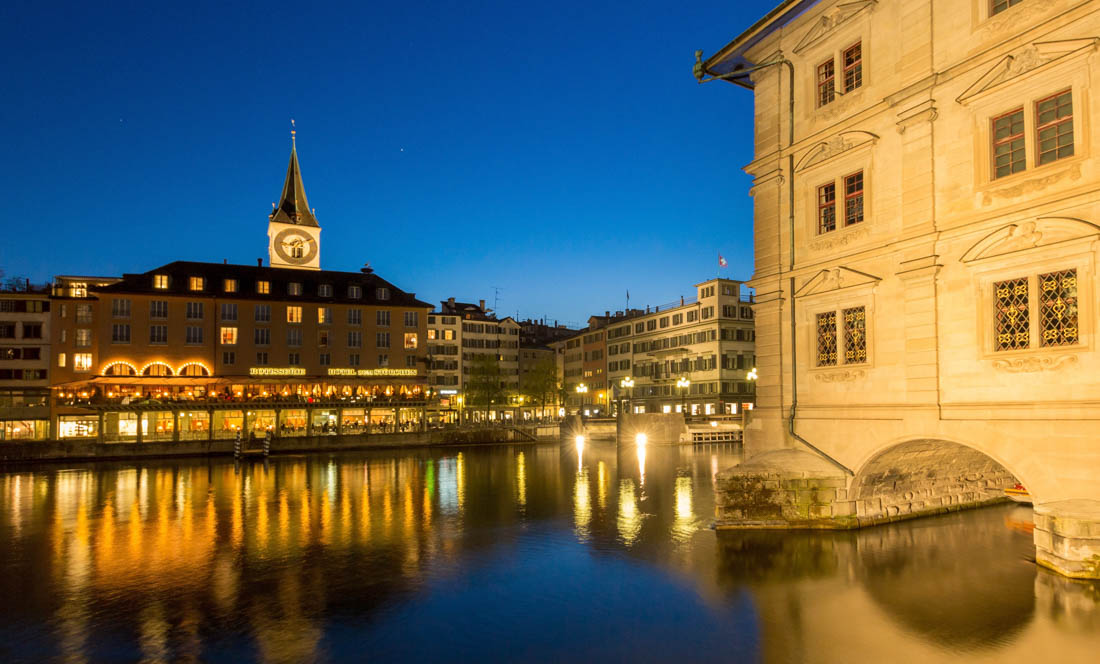
Switzerland is a adventurous, beautiful, and mountainous country. Many visitors also come because of it's amazing beauty. Visitors also love the adventure travel, national parks, history and culture, and skiing.
In the heart of Europe, this mountainous nation is full of culture and beautiful scenery. The Alps are great to explore any time of the year, as are the world-class and cultural cities of Switzerland. This country is the perfect combination of history, art, outdoor adventure, and nature, and that's why so many visitors come every year.
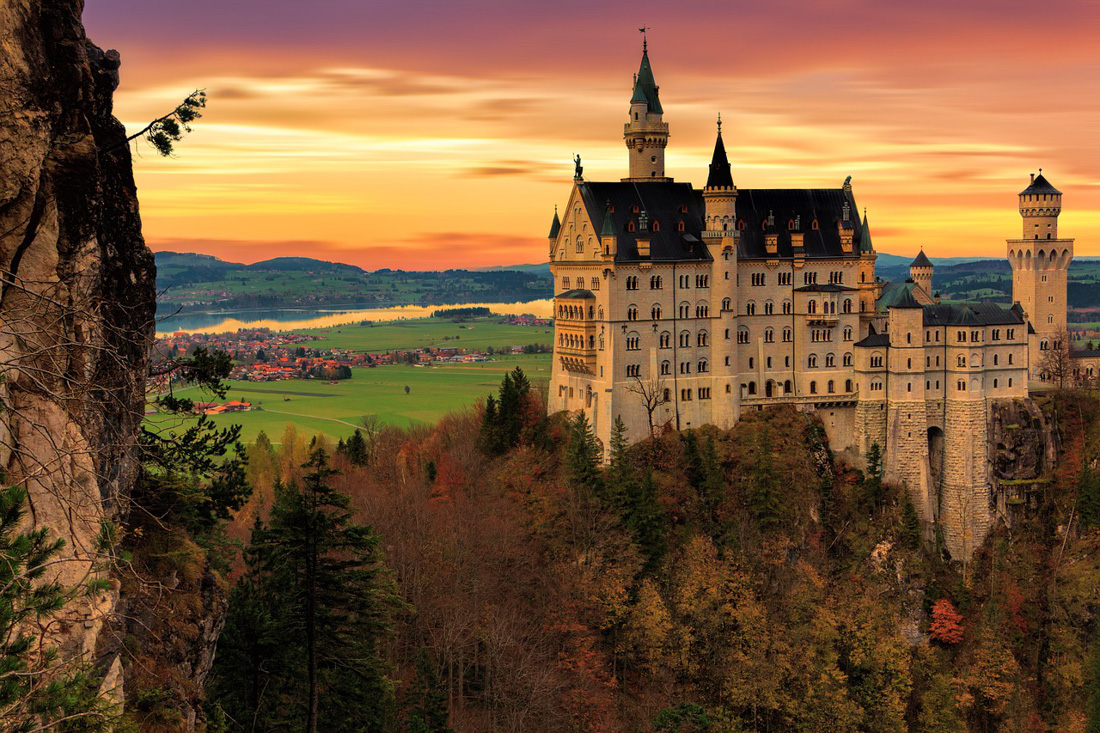
Germany is a beautiful, large, and historic country. With stunning beauty, it attracts visitors from all around. It's also popular because of the skiing, nightlife, food, and hiking.
At the heart of Europe, Germany is one of the largest countries on the continent and offers visitors a wealth of history, art, and culture mixed with modern attractions and beautiful natural scenery. The large cities offer museums, nightlife, theatre, and cultural activities, while the countryside is diverse with wine regions, gorgeous mountains, winding rivers, national parks, and historic towns.
Switzerland and Germany: Pros and Cons
- Popular museums and historical sights
- Great culture, history, and arts
- Great resorts
- Popular for skiing
- Good for hiking
- Beautiful national parks
- Great road trips
- Family-friendly
- Good for couples and romance
- Good for backpackers and budget travelers
- Impressive beauty
- Not as many resort options
- Less adventure activities
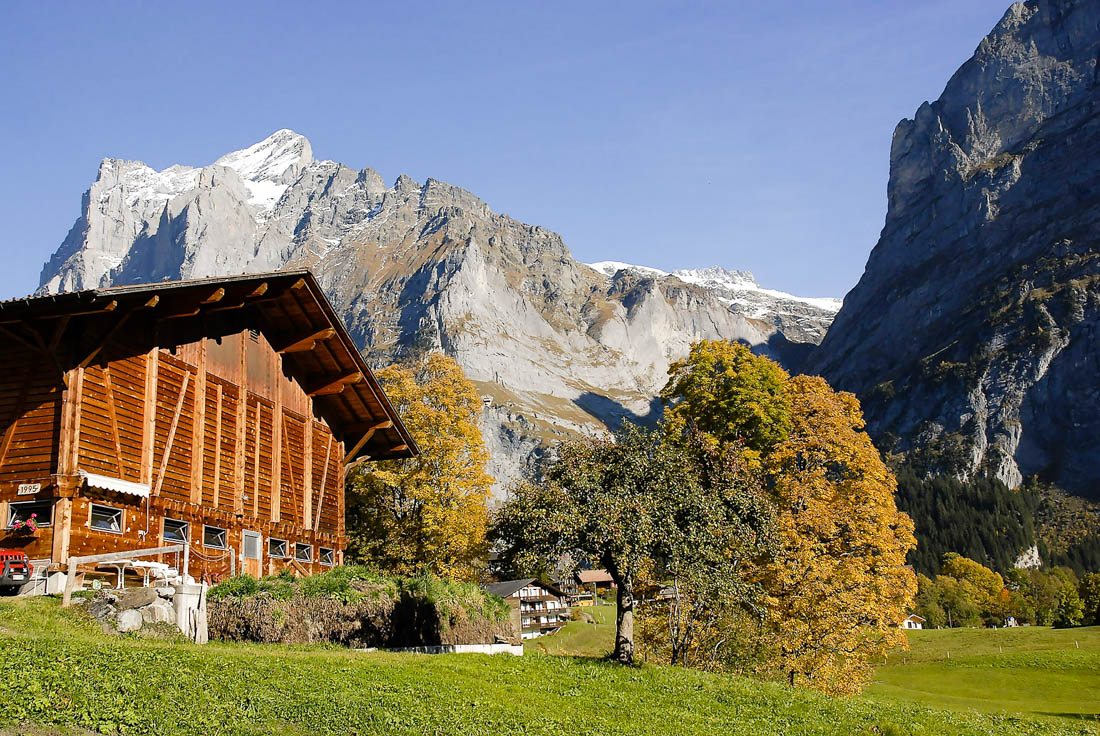
How is Switzerland different from Germany?
Which is better for a holiday.
Below we will examine the differences and similarities between Switzerland and Germany. With this information, you can decide for yourself which place is better for your next trip.
Are the Museums and Historical Sights Better in Switzerland or Germany?
You'll find a number of great museums and attractions in both Germany and Switzerland .
Visitors can fill many days exploring the museums and attractions around Switzerland . Multiple cities offer plenty of opportunities to explore museums. Basel, for example, is known as the city of museums because it offers so many from art to culture to toys to science. Bern, Geneva, Zurich, and Lucerne also have museums of all types, whether they showcase art, history, technology, or culture. There's a museum for everyone here.
Germany offers many unique museums, sights, and landmarks that will make for a memorable trip. With thousands of museums, it might be difficult to decide where to go first. Some of the best museums in Germany include the Museum Island area of Berlin which showcases a combination of art and ancient history, the Mercedes-Benz museum dedicated to the automobile, Zwinger Palace in Dresden which hosts historic art and antique weapons, the German Museum in Munich which focuses on Science, and the International Maritime Museum in Hamburg. Plenty more can be found in every corner of the country, though.
Berlin : Famous landmarks include the rebuilt Reichstag, the Berlin Wall Memorial, and Berliner Fernsehturm. Many of the city's oldest and most famous museums are found on Museum Island, where you'll find the Pergamon Museum, the James Simon Gallery, the Altes Museum, and the Neues Museum, among others.
Nuremberg : It's well established on the tourist circuit and it's easy to see why. The history and charm, combined with interesting sights make it a top place to visit in Germany. Make sure you check out Kaiserburg, the Nuremberg Trials Memorial, and Germanisches National Museum.
Würzburg : The Franconian city is known for its history and architecture. One of the most well know sights is the 18th-century Residenz palace. Other attractions in town include the Martin von Wagner Museum, the Würzburg Court Gardens, the Marienberg Fortress, and the Würzburg Cathedral & Museum.
Is Switzerland or Germany Better for Culture, Arts, and History?
You'll find great culture, arts, and history when visiting both Switzerland and Germany .
Switzerland has many famous historic and cultural sights and attractions worth visiting, and is one of the main reasons why poeple come here. The cities here have a culture and history all of their own. With museums, castles, restaurants, cafes, and beautiful architecture, the Swiss cities offer plenty of historical and cultural activities. Even the countryside provides opportunities to understand the idyllic and mountainous lifestyle of the region.
Germany is a terrific destination to visit for history, arts, and culture, as it has many sights worth visiting. With a deep and rich history, Germany's cities and small towns showcase a variety of architecture, art, theatre, cultural traditions, and more to visitors and locals alike. Many of the big cities are home to not just art museums, but also museums that provide insight into German and European history, technology, food, and its people. Even the small towns across the country offer their own piece of history and art, as the countryside is dotted with castles and ancient ruins showcasing medieval times, Roman history, and modern periods up to and after the major wars.
Is Switzerland or Germany Better for Big City Activities?
Germany offers more big cities to explore than Switzerland.
As Germany has many big cities, visitors will find plenty to do. Berlin, the capital, offers a diverse set of urban experiences from museums and historical sights to iconic modern music, trendy fashions, delicious cuisine, and more. Other larger cities include Munich, Cologne and Bonn, Hamburg, and Frankfurt, just to name a few. Each has its own personality while still offering typical big city amenities and attractions such as museums, beautiful architecture, fine dining, nightlife, and nice hotels.
See also The 13 Best Free Things to do in Berlin , and Things to do in Dresden .
Since Switzerland has large cities, you'll find plenty of things to do. The major cities here are very nice to visit and offer plenty of sights and attractions. Lucerne, for example, sits on a lake and offers restaurants, nightlife, museums, and history around every corner. Other major cities include Basel (the city of museums), Bern, Geneva, and Interlaken. Each has their own vibe, but all offer something interesting for guests.
Is Switzerland or Germany Better for Small Towns and Villages?
You'll find a similar number of great small towns and villages to explore in both Switzerland and Germany .
You'll find plenty of local activities in all of the small towns and villages in Switzerland . Small towns with a charming atmosphere and stunning views are what Switzerland is all about. In the Alps, visitors will find no shortage of gorgeous mountainside villages with traditional Swiss architecture, mountain vistas, and plenty of surrounding activities. For example, check out Murren or Lauterbrunnen near Interlaken, or Stein am Rhein, or Zermatt. And in the winter they are just as beautiful as in the summer.
Because Germany offers so many small towns with a variety of charming activities, it attracts plenty of visitors for a good reason. One of the main attractions to many regions of Germany is the large number of small, beautiful towns. Many of these towns, especially those along the Rhine river, in Bavaria, and in the Black Forest, are extremely scenic and historic. Visitors to these towns experience history, culture, great cuisine, fun activities, wine tasting, mountain views, and more. Some of the most scenic towns in Germany include Quedlinburg, Cochem, Rottach-Egern, Rothenburg ob der Tauber, Fussen , Bamberg, and Gorlitz, although there are many others that are also popular.
See also The Best Day Trips from Munich .
Is the Food Better in Switzerland or Germany? Which Country Has the Best Restaurants?
Local dishes at restaurants are fun to try in both Switzerland and Germany .
Switzerland has a number of nationally recognized food spots and restaurants. Of course, you can't visit without tasting the fondue. But Swiss food goes beyond cheese, as you'll also find great steaks, fresh fruits and vegetables, and an influx of German, French, and Italian cuisine at local restaurants.
With its innovative style combined with traditional elements, Germany makes for a great culinary experience. German food traditionally consists of meat and potatoes, along with beer, naturally. But in recent decades the food scene in the major cities has exploded. So, while you definitely should try the bratwurst and other related sausages along with schnitzel (breaded fried pork) and spatzle (egg noodles), you can also find modern cuisine from Germany and abroad in almost every town across the country. Modern chefs, especially in the big cities, are catering to the modern local German population, as well as tourists, with gourmet food in a variety of restaurant styles. But of course, while in Germany you still need to try the potato pancakes, rabbit stew, pork knuckle, and roast beef stew. And wash it all down with some local German beer, of course! You'll find a wide variety of beer styles, flavors, and brewing techniques all around the regions of this beer-loving country.
Baden-Baden : There are Michelin starred restaurants and many opportunities to sip wine and sample local cuisine. Many consider the Baden cuisine to be among the best in Germany. You'll find wine, sausages, game meat, poultry, and more. Make sure you try the Rehrücken Baden-Baden (Roe Deer), Käsespätzle (cheese spatzle), and Schäufele (pig's shoulder).
Is Switzerland or Germany Better for Nightlife?
Most visitors prefer the nightlife in Germany .
Many people head to Germany for the nightlife scene. Berlin, Munich, Hamburg, and other major cities offer plenty of nightlife options such as bars, clubs, pubs, concerts, theatre productions, and a variety of other options for both tourists and locals alike. Out in the smaller cities and rural areas, nightlife might be limited to the local bar, but it's still not hard to find some of that delicious German beer no matter where you visit.
Berlin : The nightlife scene here is legendary. There are club nights that last for days, bars and parties that appeal to every personality, and a diversity of venues that you can choose from. You'll find the classic techno warehouses, but there are also modern dance clubs, bunker parties, and raves.
Munich : The city has a young and vibrant population that keep the nightlife scene active and fun. There are many bars and clubs around town, but the city is also famous for Oktoberfest during the months of September and October.
See also Party Hostels in Munich , Party Hostels in Hamburg , and Party Hostels in Berlin .
There's a variety of activities in the evening in Switzerland. Some of the major cities offer bars, clubs, restaurants, and theatres for those looking to go out at night. Geneva, Basel, Bern, and Lucerne are all fairly active in the evenings.
Is Switzerland or Germany Better for Resorts?
Switzerland tends to offer a wider variety of resorts than Germany.
Switzerland is known as a popular and fun resort destination. Ski resorts are common here, as Switzerland offers world-class skiing and snowboarding in the winter months. Many of these resorts also offer luxurious amenities such as indoor pools and spas, nice restaurants, kids' activities, and more. You can also find some resorts and luxury hotels on the shores of the larger lakes.
Germany has a few resort options worth checking out. As this country is more about history, culture, and large cities mixed in with historic towns, resorts are not as popular with travelers as they are in other countries. However, plenty of ski resorts can be found in the Alps and other mountain areas in the south. Additionally, a number of large resort hotels can be found throughout the country in popular tourist areas. Some of these resorts are near amusement park areas (such as Legoland and Europa-Park), while others are more adult-focused and centered around wellness and spas.
Is the Shopping Better in Switzerland or Germany?
If you're looking to go shopping, Switzerland and Germany both offer plenty of great spots.
Switzerland has a variety of shopping areas worth visiting. The larger cities of Geneva, Lucerne, Bern, and Basel are popular with shoppers looking to find the latest fashion trends or local arts and crafts.
Zurich : Visitors often buy chocolate, watches, and jewelry in this city. You'll find brand names and luxury items that are of high quality. Each neighborhood has its own character with stores ranging from traditional to international.
Geneva : Famous for its posh shops and luxury brands, this city is a popular shopping destination. From chic boutiques to deluxe toy stores, you'll find something for everyone. In particular, the city is known for its Swiss watches, Swiss Army knives, chocolate, and wine.
Germany is a great destination for shopping. Berlin, Munich, Frankfurt, Cologne, Hamburg, and other large cities in Germany offer plenty of trendy and authentic shopping experiences. From high-end fashion to grunge to casual to hipster, the cities of Germany offer something for everyone.
Berlin : Bookshops, flea markets, luxury boutiques and artisan shops all make up the shopping scene in the city. Kurfürstendamm is one of the most famous shopping districts in the city.
Munich : There are many pedestrian areas and shopping centers where you can find everything from luxury items to bargain finds.
Is Switzerland or Germany Better for Christmas?
With various activities, both Switzerland and Germany are great places to visit during Christmas.
With so many activities, Switzerland is a top place to visit during Christmas. Christmas here is very popular, and the alpine setting makes it magical. Many cities and towns will decorate their churches and town squares with Christmas trees and other decorations, and many also have markets, festivals, theatre shows, and more.
Germany is a fantastic destination at Christmas. Germany lights up at Christmas, as the large cities of Berlin, Cologne, Munich, Nuremburg, Dresden, and others host a variety of activities, put up large trees, adorn public buildings with lights, host concerts in their cathedrals, and offers shows, ice skating, and more. Plenty of smaller cities and small towns in the countryside do the same, combining the snowy landscape, alpine architecture, and holiday spirit into one large festive atmosphere in winter.
Cologne : Cologne is one of the top Christmas destinations in Germany. You'll find many different markets spread around town that offer ice skating, curling, warm drinks, and local dishes. Foodies will appreciate the many samplings of local holiday favorites while shoppers will be able to pick up gifts and Christmas decorations that are locally made.
Is Switzerland or Germany Better for Christmas Markets?
Visitors can find great Christmas markets in both Switzerland and Germany .
The Christmas markets in Switzerland are not to be missed. Some of the best places in the country for Christmas markets include those in Baden, Basel, Gruyeres, and Lausanne, although plenty of other cities and towns host them. Visitors can find more than just arts and crafts, though. Many of these markets include parades, baking contests, outdoor concerts and performances, and delicious food.
People travel to Germany specifically to enjoy its famous Christmas markets. As Germany has been hosting Christmas markets in some of its towns for hundreds of years, it's no surprise that they are so popular with locals and visitors alike. Some of the best markets are in Nuremburg, Dresden, Cologne, Frankfurt, Munich, Konstanz, and Bamberg. But also keep in mind that almost every town in Germany has some sort of Christmas market or festival from November until Christmas, so you can easily hop from place to place on the train if you want to see more than one. In fact, this is what many visitors do.
Cologne : Cologne is one of the top Christmas market destinations in Germany. You'll find many different markets spread around town that offer ice skating, curling, warm drinks, and local dishes. Foodies will appreciate the many samplings of local holiday favorites while shoppers will be able to pick up gifts and Christmas decorations that are locally made.
Is Switzerland or Germany Better for Skiing?
Even though Switzerland and Germany provide opportunities for snow skiing, most people consider Switzerland to be more popular.
If you're an avid snow skiier, Switzerland should be on your list. World-class skiing and snowboarding is found across the entire country. After all, these are the Alps. From the mountain peaks of Zermatt and St. Moritz to the beautiful Lauterbrunnen valley to the family-friendly resorts at Titlis and Grindelwald/Jungfrau, Switzerland offers skiing for everyone.
Zermatt : This is Europe's highest ski resort and it is one of the most famous and beautiful, at the base of the world renowned Matterhown. The slopes attract professional skiers from around the world who come for the challenging skiing and spectacular setting.
Murren : If you're visiting in the winter, you're in luck because the scenery and the slopes are both amazing. The top of Schilthorn is quickly accessed from the gondola and ski lifts, and heading down you'll find some difficult runs along with easier slopes. Enjoy your apres-ski in the village with cozy drinks and a dinner of fondue. And with more time, you can easily get across the valley to the Grindelwald-Wengen ski area, too.
Germany is an extremely popular place for snow skiing and other winter sports. As Germany borders the Alps in the south, you'll find a large number of ski resorts in this area. Some of the best and most popular include Alpsee-Grunten, Arber, Winklmoosalm-Steinplatte, Oberstdorf, Winterberg, and Oberjoch Bad Hindelan. There are many others that also provide extensive ski and snowboarding routes along with luxurious accommodation options (or budget-friendly), and delicious cuisine.
Is Switzerland or Germany Better for Hiking?
Switzerland provides a better hiking experience than Germany.
People visit Switzerland specifically for its hiking, as the natural beauty is well-known. All across the country, visitors will find hiking trails of all skill levels. Some are very easy, such as those that leave from alpine villages and meander through farmland. Others are only for experts, like the edge-of-the-cliff trails high up in the peaks. Most are somewhere in the middle and suitable for most hikers, and offer stunning views of the Alps along with the occasional stop at a mountainside café.
Zermatt : There are countless hiking trails in the area that cater to all levels of fitness. Almost all trails offer some sort of view of Matterhorn, and it's possible to enjoy a great view without much effort. It's also possible to do a multi-day trek while staying in mountain huts which will get you well into the amazing scenery.
Interlaken : Hikes in the area range from easy to challenging with every option in between. You can experience beautiful waterfalls, breathtaking views, and dramatic ridge hikes. Several of the best hikes in the area include Schynige Platte Ridge Trail, Mt Niesen Panorama Trail, and Giessbach Waterfalls.
Grindelwald : Hiking in the area offers spectacular views of the Bernese Alps including Wetterhorn, Eiger, Jungfrau, and Breithorn. There are trails that cater to all levels and hiking is the best way to explore the countryside.
Germany is a popular spot for hiking. From the Alps in the south to the Baltic Sea coastline in the north, plenty of amazing hiking trails can be found throughout Germany. Some of the best include Painters' Way in the Elbe Mountains, the Rheinsteig Trail along the Rhine River in western Germany, Triberg Waterfalls in the Black Forest, and Partnachklamm Gorge in the Reintal Valley in Bavaria. But there are many more places to explore, as Germany is home to 16 national parks plus a number of wilderness and mountain regions.
Is Switzerland or Germany Better for its National Parks?
Switzerland often provides a better experience visiting national parks than Germany.
Exploring the beautiful national parks is a popular activity in Switzerland . With 19 national parks, this country offers a diverse set of natural areas to explore away from crowds and development. As this is the Alps, many of these national parks are in mountainous alpine settings, and they offer great views, hiking, and an accessibility to nature that is hard to find in many other countries. Some are rugged, while others are pastoral, and a few are also agricultural (with vineyards).
Germany is a great destination for touring the national parks. Some of the most popular national parks here include Berchtesgaden National Park in Bavaria, Jasmund National Park in the northeast, Kellerwald-Edersee National Park, and Black Forest National Park. Germany has 16 national parks with landscapes ranging from the mountains to the sea to the forests. Hiking, horseback riding, camping, adventure sports, and bird watching are popular activities in the parks, almost all of which are very accessible from nearby towns and cities.
Is Switzerland or Germany Better for Adventure Travel?
Overall, Switzerland is considered to offer more adventure travel options and experiences to visitors.
Switzerland offers a great deal of adventurous and exciting experiences. Many visitors here partake in snow skiing and snowboarding in the winter. In the warmer months, you can experience paragliding, river rafting, kayaking, rock climbing, cliff walking, bungee jumping, ropes courses, and mountain coasters. This country seems to pride itself on extreme sports in some of the mountain areas, or at least provide every type of sport to visitors.
Germany is a pretty good destination for adventure travel with a good array of experiences. Some of the most popular adventure activities in the country include mountain climbing and rock climbing, horseback riding, paragliding, ropes courses and zip lines, snow skiing, and river rafting. As Germany is a large country with a diverse landscape, every region offers something exciting to visitors.
Is Switzerland or Germany Better for Visiting the Mountains?
Overall, Switzerland is considered to offer more mountain activities and attractions to visitors.
The beauty of the mountains of Switzerland are one of the main reasons people come to visit. The Alps are absolutely gorgeous, and everyone should see them. Switzerland is at the heart of them, and here you can fully immerse yourself in the alpine lifestyle from skiing to hiking to rock climbing and more. Or, just relax in a small mountain town with a stunning view and a cup of coffee while listening to the cow bells in the distance. Either way, it's hard to beat the mountain settings that you'll find in Switzerland.
Germany is an extremely popular destination for those interested in visiting the mountains. The southern regions are home to the Alps, and in Bavaria and Baden-Wurttemberg you'll find gorgeous scenery mixed with historic towns, clear lakes, and cultural activities that make this part of Germany that much more exciting. Hiking, horseback riding, adventure sports, and more can all be found here. The Elbe mountains in the southeastern region near the Czech border are also gorgeous, and more hiking and sightseeing opportunities can be found here as well.
Is Switzerland or Germany Better for Outdoor Activities?
Overall, Switzerland is considered to offer more outdoor activities and attractions to visitors.
With world-famous outdoor activities, Switzerland attracts many visitors interested in natural scenery, exploration, and adventure. As a country totally immersed in the mountains, the outdoors are the main attraction here. Visitors can explore the Alps on foot, or by horseback, or on skis. Ropes courses and zip lines are found throughout the nation, as are camping and rock climbing. Fishing and boating are common in the rivers and lakes, too. It's easy to get out of the cities and into the mountains, and this accessibility makes the outdoors that much more fun here.
Germany is an extremely popular destination for those interested in outdoor activities. With no shortage of outdoor activities, Germany offers a great deal of variety to visitors. The mountains in the southern regions near the Alps are very popular for outdoor enthusiast looking for hiking, climbing, skiing, camping, fishing, and more. Also, numerous national parks and other wilderness areas can be found in all corners of the country where travelers can find even more to do in the forests and coastline and rivers of the country. Some of the best areas for outdoor activities include Baden-Baden, Eifel, the Rhine Valley, and the Bergstrasse.
Is Switzerland or Germany Better for a Road Trip?
You can't go wrong planning a road trip in either Switzerland or Germany .
Taking a road trip through Switzerland is very good way to see the countryside and smaller destinations. A drive through the Alps is an amazing experience. It's hard to find anywhere else where you are surrounded by beautiful mountains while also exploring historic villages, pastoral farmlands, and world-famous cities.
Germany is an extremely popular destination for those that want to take a road trip. The autobahns of Germany make for a terrific way of getting around the country. If you have a car, multiple road trips options throughout the country are very popular, and make it easy to see the Alps and Elbe mountains, the Black Forest, the small towns along the rivers, and the numerous castles. Visitors could easily spend weeks exploring everything from the cities to the national parks to the mountain peaks. A road trip is a great way to see Germany.
Is Switzerland or Germany Better for Families?
Both Switzerland and Germany are great family-friendly destinations.
With a huge array of activities for kids, Switzerland is very family-friendly. With cultural cities, gorgeous mountains, outdoor activities, mountain resorts, and terrific food, it's no surprise that this country is very family friendly. The small towns in the Alps offer a mix of relaxing and adventurous things to do such as hiking, exploring playgrounds, admiring views, and visiting farms. It's easy to get around almost anywhere in the country with public transit, too.
Interlaken : While the city is beautiful, it's really the surrounding areas that you and your family will enjoy. There are amazing hikes, stunning views, playgrounds, lakes, and more. There's also an impressive ropes course that adventurous kids will love, funiculars, gondolas, and so many water sports!
See also Hostels in Geneva for Solo Travellers, Couples, and Families , Hostels in Lucerne for Backpackers, Couples, and Families , and Hostels in Lausanne for Backpackers, Families, and Couples .
As it has a large number of activities for kids, Germany is a very family-friendly destination. Families with kids will find plenty of activities here from theme parks to historic castles to kid-friendly museums. Almost every major city has some sort of theme park or water park nearby, along with easy to reach historical castles and small towns with fun shops and activities. Neuschwanstein Castle is one of the premier castles which inspired the Disney castles, but it's just one of many. Theme parks such as Phantasialand, Europa-Park, Heide-Park, Legoland, Movie Park Germany, and more. Add on the old medieval towns with their city walls, bratwurst-filled restaurants, and interesting local museums, and the kids will get a fill of history and culture, too. Finally, the mountain ranges to the south offer unique outdoor and adventure activities that the whole family will love such as hiking, horseback riding, ropes courses, and more.
Bonn : Just outside of the town is the Haribo factory outlet store where you can pick up a number of sweet treats and spend some time exploring with the kids. Another favorite activity for the whole family is a trip to nearby Phantasialand. This is one of the best amusement parks in Germany and it has many rides for teens and younger kids alike. In town, you'll find playgrounds and kid-friendly museums. Kids will also love a visit to Schloss Drachenburg Castle.
Is Switzerland or Germany Better for Couples?
Couples will find a longer list of romantic activities in Switzerland than Germany.
Switzerland is a great country if you're traveling as a couple. Gorgeous mountain views are just the beginning, as Switzerland also offers the chance to relax in a cozy mountain chalet up in the Alps after a day of hiking or adventure sports. Here, couples can truly experience a wide variety of activities, whether they are athletic, historical, or cultural. The charming hotels, natural beauty, and delicious food just add to the already amazing experiences.
Zermatt : Couples who seek an adrenaline filled adventure will be in heaven in this iconic alpine destination. There are breathtaking views of Matterhorn, stunning hikes, impressive skiing, and a charming town where you can enjoy a great meal after a day filled with adventure.
Interlaken : The mountaintop views, breathtaking hikes, and beautiful lakes make this a top destination for couples. Make sure you head out of town and fully immerse yourself in everything that the area has to offer. Kayaking, canoeing, paragliding, and more will make this a trip of a lifetime.
Murren : This small town offers charming hotels, hidden viewpoints, and romantic hikes through the Alps. If you want to experience an authentic side to the Alps, then stay in this town and explore the many hiking trails in the area.
See also Hostels in Geneva for Solo Travellers, Couples, and Families , Hostels in Lucerne for Backpackers, Couples, and Families , and Hostels in Bern for Backpackers, Solo Travelers, and Couples .
Germany is a nice destination for couples. Many couples seek out the smaller towns and mountain regions of Germany as romantic destinations. In Bavaria and Baden-Wurttemberg, the southern regions, couples can find small mountain towns along rivers and lakes with views of the Alps. Also, wineries and vineyards are popular in Germany, as the quality of the wine is matched by the beauty of the landscape and quaintness of the small towns. River cruises, ski resorts, and historic cities are also popular options. A few of the best include Heidelberg, Berchtesgaden, Dresden, Fussen (Neuschwanstein Castle), and the Black Forest.
Bamberg : Filled with scenic bridges, beautiful gardens, and historic architecture, this is a top destination for a couples getaway. You can enjoy gondola rides and fine dining on a romantic weekend away.
See also Hostels for Solo Travellers, Couples, and Groups in Cologne , Hostels in Hamburg for Solo Travellers, Couples, & Groups , and Hostels in Munich for Solo Travellers, Female Travellers, & Couples .
Is Switzerland or Germany Better for Backpackers and Budget Travelers?
Travelers usually think of Germany as a better destination for backpackers than Switzerland.
Plenty of budget travelers and backpackers visit Germany. While this country is generally expensive, many affordable options can be found by those looking to save money. While the larger cities have hostels and other budget-friendly activities, the smaller towns also offer affordable amenities for younger travelers or those looking to plan their own route on a tight budget. Using public transit to save money is also a great way to get around, as Germany's rail system and the city's transit systems are top-notch.
Berlin : The city has no shortage of hostels to choose from, many of which organize activities and tours that guests can enjoy.
Munich : The city has many fun hostels that often host events and activities for guests. It's easy to meet other backpackers and take advantage of the nightlife around town.
See also Best Hostels in Berlin , Party Hostels in Munich , and Party Hostels in Hamburg .
Plenty of budget travelers visit Switzerland. Plenty of hostels and outdoor activities can be found throughout the country, allowing budget travelers to explore the cities and mountains on their own. However, since Switzerland is a fairly expensive country, this tends to keep budget travelers away. Plenty of visitors come for outdoor backpacking and camping in the wild, though, as the scenery is top notch.
See also Hostels for Backpackers in Zurich , Switzerland's Best Budget Hostels , and Interlaken Hotels & Hostels Near the Train Station (Interlaken West) .
Is Switzerland or Germany Better for Students?
For students, both Switzerland and Germany are great places to visit.
It's common for students to visit Switzerland . A variety of study abroad and student programs can be found around the country, most notable in the larger cities of Lucerne, Bern, and Basel.
Zurich : The city offers a number of unique experiences for international students. The academics are good and the university campuses are nice.
See also Hostels in Switzerland for Backpackers and Students .
Germany is a good country to visit for students. As a large country, plenty of universities offer programs for students that come to study from countries around the world. Also, most of these universities are located in towns and cities with plenty of nightlife options and other activities for students and younger travelers.
Berlin : With it's rich culture and eclectic creative side, this city appeals to many international students. There's also a great social scene that is perfect for university students.
Munich : The city is an economic hub for both Germany and Europe, so it attracts employees from around the world. There are many wonderful university programs, including a great business school in town. The city's multicultural setting makes it great for international students.
Frankfurt : The city offers prestigious universities and a world class education. The economy offers many internships and job opportunities and you'll find students from around the world studying here. Frankfurt is also well connected to the rest of Europe, so it's easy to explore the region.
See also Hostels for Backpackers and Students in Munich, Germany , and Hostels for Solo Travellers and Students in Frankfurt, Germany .
Is Switzerland or Germany Easier for Transportation? Which is Easier to Get Around Without a Car?
Switzerland and Germany both offer transportation to get you around.
The thorough and effecient public transit system of Switzerland can take you anywhere. The Swiss rail system is fast, efficient, and comfortable. It's very easy to get around between the major cities and small towns, and also easy to reach the peaks of mountains and higher-up towns, too. Major cities and even smaller areas all have some form of public transit. In the mountain areas, this often takes the form of gondolas and old cog-railways up to higher elevations, making travel part of the fun.
- Traveling by train is extremely popular.
- It's possible to travel by bus.
- It's fairly easy to travel by car.
- Travel by airplane is possible.
Germany has a great public transit system. The extensive train networks (Deutsche Bahn, among others) connects major cities, small towns, and rural areas so that everywhere is connected and accessible. And once you're in major cities such as Berlin, Cologne, and Munich, you'll find even more local public transit options. Even smaller cities and towns in Germany have their own bus and tram networks to get everyone around quickly. Furthermore, the famous autobahns of Germany can take those who wish to drive around the country quickly as well. On top of all of this, most major cities have airports with multiple international connections on a daily basis.
- It's very easy and convenient to travel by car.
Is Switzerland or Germany more Comfortable for a Trip?
Switzerland and Germany are both modern and comfortable places to visit.
People often come to Switzerland because it is such a comfortable and luxurious destination. Despite the rugged terrain of the Alps, the overall travel infrastructure of this country is second to none. Swift, clean, and efficient public transit is everywhere, and sometimes it will even take you all the way to the top of the mountain peak. Small towns in the Alps are connected to all of the major cities. Hotels are often high-end and provide plenty of comforts, even those at the lower price points. Resort areas are common, too. The cities are modern with enjoyable amenities such as cafes, restaurants, and museums - and the clean public transit can take you around town.
Germany is extremely comfortable for travelers as it is a modern destination with plenty of amenities. As a prosperous and wealthy country, it's easy to relax and enjoy a trip in Germany. Every city and town has a wide range of hotel options at all price ranges with modern amenities and conveniences. You'll also find plenty of restaurants, a great transportation network within and between cities, and well-educated tour guides and staff everywhere you visit.
Is Switzerland or Germany more Touristy?
Switzerland generally has a more touristy vibe than Germany.
Plenty of tourists come to Switzerland every year, as it's a popular destination. This country is a travelers dream, but its not undiscovered. Plenty of visitors come to this fairly small European nation every year to admire the beauty of its mountains and explore the culture of its cities. During peak travel times (summer and the winter ski season), it can be hard to find a hotel unless you book ahead. You'll find plenty of other visitors when you arrive, especially in the major cities and at top tier attractions such as Jungfrau peak.
Germany is somewhat touristy. The most popular tourist destinations in Germany can be very busy, especially during the peak seasons (usually summer). The busiest tourist areas include major cities such as Berlin and Munich, and they see many visitors at their main attractions, museums, and monuments. Also, other major tourist destinations include some of the castles in the countryside, the smaller villages in the Rhine Valley, the Alps, and the Black Forest that offer impressive beauty, the ski resorts during winter, and the various amusement parks around the country. However, the number of tourists can still be manageable at most of these locations and should not dissuade anyone from visiting.
For some great organized tour ideas, see The Best Family-Friendly Tours to Switzerland , The Best Hiking & Trekking Tours in Switzerland , The Best 10-Day Tours in Switzerland , The Best One Week (7-Day) Tours in Switzerland , The Best 2-Week Tours in Switzerland , The Best Bicycle Tours in Switzerland , Tours for Outdoor and Nature Lovers in Switzerland , The Best Adventure Tours to Switzerland , The Best Sightseeing Tours in Switzerland , The Best Romantic Tours for Couples in Switzerland , The Best Luxury Tours to Switzerland , The Best Tours for Seniors to Switzerland , The Best One-Week (7-Day) Tours from Zurich , The Best One-Week (7-Day) Tours from Geneva , The Best 10-Day Tours from Zurich , The Best 2-Week Tours from Zurich , The Best Family-Friendly Tours to Germany , The Best Hiking & Trekking Tours in Germany , The Best Historical Tours in Germany , The Best 10-Day Tours in Germany , The Best One Week (7-Day) Tours in Germany , The Best Bicycle Tours in Germany , Tours for Outdoor and Nature Lovers in Germany , The Best Oktoberfest Tours in Germany , The Best Coach Bus Tours in Germany , The Best Adventure Tours to Germany , The Best Cultural Tours in Germany , The Best Vineyard & Wine Tours in Germany , The Best Food and Culinary Tours in Germany , The Best Music Tours in Germany , The Best Romantic Tours for Couples in Germany , The Best Walking Tours in Germany , The Best Tours Under $1000 in Germany , The Best Luxury Tours to Germany , The Best Budget Tours to Germany , The Best Tours for Seniors to Germany , The Best 3-Day Tours from Munich , The Best One-Week (7-Day) Tours from Munich , The Best One-Week (7-Day) Tours from Berlin , The Best 10-Day Tours from Berlin , and The Best 2-Week Tours from Berlin .
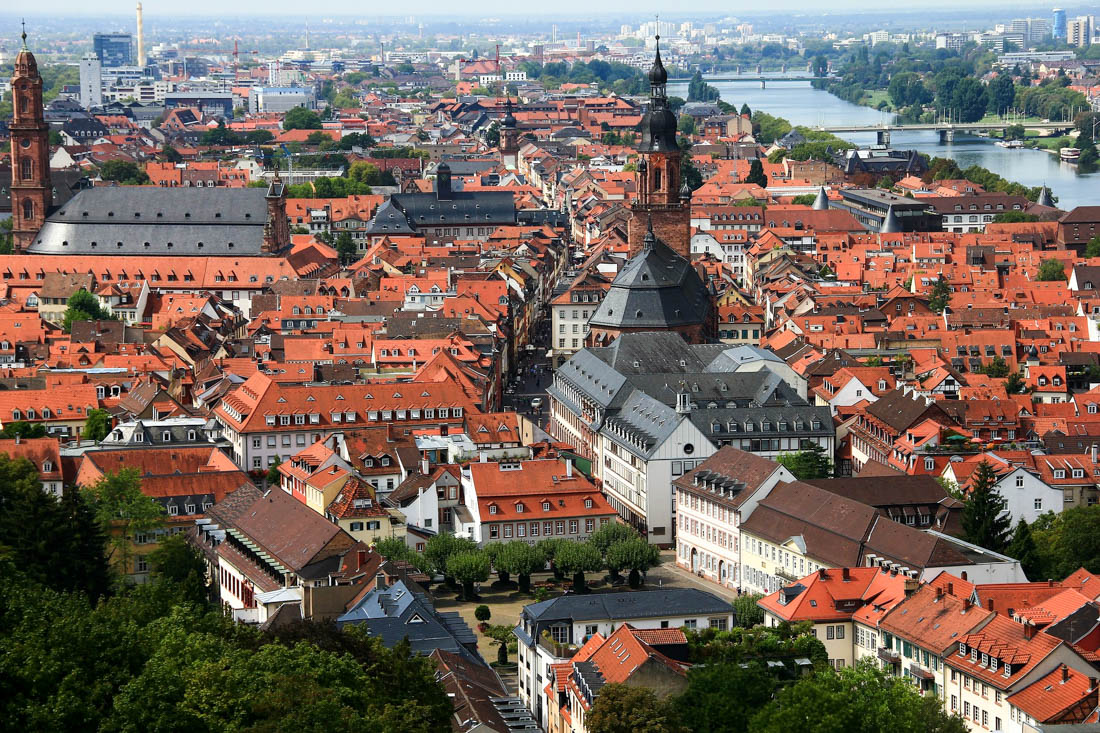
Should I spend more time in Germany or Switzerland?
How long in switzerland or germany.
Switzerland and Germany both offer a nice selection of activities for visitors. In our opinion, Switzerland has more to see and do, so we recommend that you spend more time in Switzerland than Germany . In general, 5-14 days is a good amount of time for Switzerland, and 7-14 days is enough time in Germany.
Families should spend more time in Switzerland than Germany. Because of the many family-friendly attractions and fun things to do for kids in Switzerland, it's a great place to visit with the whole family.
Couples should spend more time in Switzerland than Germany. You'll find plenty of romantic sights and fun activities in Switzerland that are great for a weekend getaway or a longer couple's trip.
Backpackers and budget travelers should spend more time in Germany than Switzerland if your budget allows for it. With a larger number of budget-friendly sights, good nightlife, and active things to do, anyone traveling on a budget would have a good time in Germany.
- How many days should I spend in Switzerland or Germany? Ideal Length of Stay --> Switzerland 5-14 Germany 7-14
A weekend in Switzerland or Germany?
In Switzerland, you'll find history and culture, skiing, and nightlife. The length of your trip often depends on your style of travel. Visiting national parks can easily take up a good amount of your time here, too. Since there is so much to do in the area, a weekend is probably not enough for all of it.
Visitors enjoy the food, hiking, and mountains when visiting the beautiful destination of Germany. Many visitors also spend a good bit of time hiking. This country offers something for everyone. Since there is so much to do in the area, a weekend is probably not enough for all of it.
Five days in Switzerland or Germany?
Switzerland is a great place to explore. It is common to spend five days here. Hikers are also drawn to this area. Five days is a great amount of time to relax and see the many things that Switzerland has to offer. Anyone can find something fun to do here.
Visitors enjoy the hiking, mountains, and shopping when visiting the beautiful destination of Germany. Make sure you spend some time hiking while you're in the area. Since there is so much to do in the area, five days is probably not enough for all of it. The length of your trip often depends on your style of travel.
A week in Switzerland or Germany?
It's hard to know how much time to spend in Switzerland. In Switzerland, you'll find nightlife, food, and hiking. Many visitors also spend a good bit of time hiking. With all of its activities, you can easily fill one week here.
Visitors enjoy the mountains, shopping, and museums when visiting the destination of Germany. Anyone can find something fun to do here. This is a popular place to visit for one week. Many travelers plan to spend time hiking while in the area. In one week, you should have a good grasp of this country.
Two weeks in Switzerland or Germany?
It's hard to know how much time to spend in Switzerland. In Switzerland, you'll find nightlife, food, and hiking. Many travelers plan to spend time at the national parks on their trip. Two weeks is a great amount of time to relax and see the many things that Switzerland has to offer.
Visitors enjoy the mountains, shopping, and museums when visiting the destination of Germany. Anyone can find something fun to do here. This is a popular place to visit for two weeks. Many travelers plan to spend time hiking while in the area. If you enjoy all that's offered here, then two weeks is just the right amount of time to spend here.
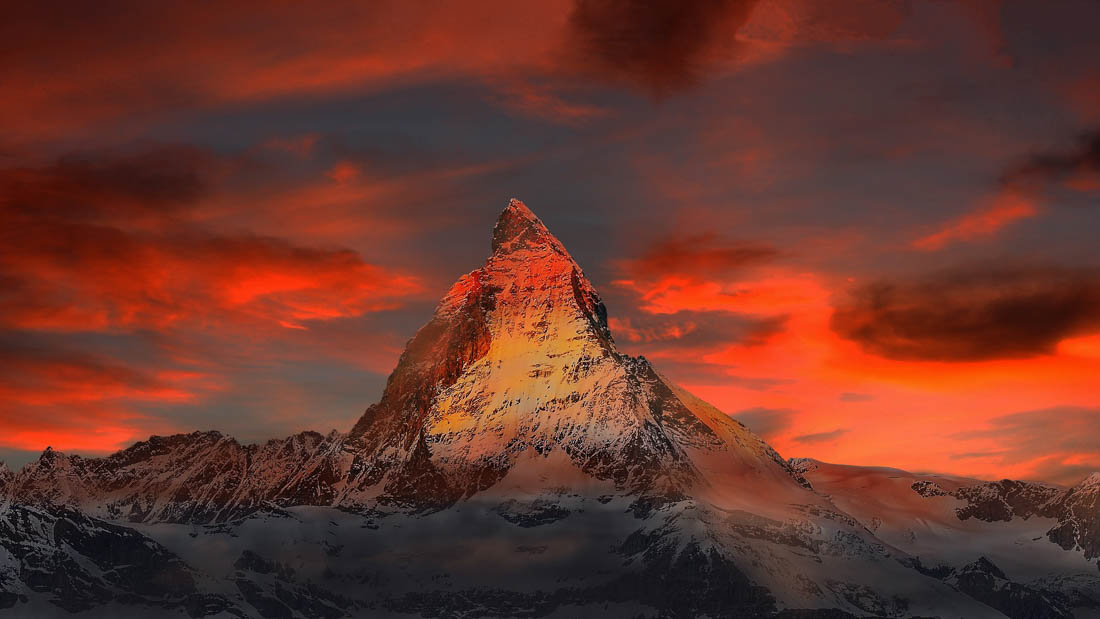
Which country is cheaper, Germany or Switzerland?
These are the overall average travel costs for the two destinations.
- Switzerland Prices Germany Prices
- Average Daily Cost Per person, per day Switzerland $ 287 Germany $ 162
The average daily cost (per person) in Switzerland is $287, while the average daily cost in Germany is $162. These costs include accommodation (assuming double occupancy, so the traveler is sharing the room), food, transportation, and entertainment. While every person is different, these costs are an average of past travelers in each country. What follows is a categorical breakdown of travel costs for Switzerland and Germany in more detail.
Accommodation
- Accommodation Hotel or hostel for one person Switzerland $ 169 Germany $ 80
- Accommodation Typical double-occupancy room Switzerland $ 338 Germany $ 160
Compare Hotels in Switzerland and Germany
Looking for a hotel in Switzerland or Germany? Prices vary by location, date, season, and the level of luxury. See below for options and compare which is best for your budget and travel style.
Hotels in Switzerland
Hotels in Germany
Kayak helps you find the best prices for hotels, flights, and rental cars for destinations around the world. Compare prices for multiple destinations when planning your next trip.
Local Transportation
- Local Transportation Taxis, local buses, subway, etc. Switzerland $ 38 Germany $ 26
Typical Local Transportation prices in Switzerland
Here are some examples of typical transportation prices from actual travelers in Switzerland:
- Cable Cars (for 2) $ 66
- City Pass (2) $ 29
Hired Cars and Shuttles in Switzerland
Also for Switzerland, here are a few examples of actual transportation services:
- Private Transfer from Nice to Geneve: $2,750
- Private Transfer from Nice to Geneve: $2,609
- ZURICH: VAN LUX 6 PAX TRANSFER FROM AIRPORT ZURICH TO DAVOS: $1,651
- ZERMATT: VAN STANDARD 6 PAX TRANSFER FROM TO AIRPORT ZURICH: $1,596
- ST. Moritz Luxury Private Transfer to Zurich Airport: $1,420
- Private Group transfer Zurich Airport - Interlaken: $1,321
- TASCH: SUV LUXURY 4 PAX TRANSFER FROM TO AIRPORT ZURICH: $1,210
- ZURIGO: SUV LUXURY 4 PAX TRANSFER FROM AIRPORT TO DAVOS: $1,210
- SUV LUXURY TRANSFER FROM AIRPORT ZURIGO to MILANO MALPENSA: $1,210
- TRANSFER FROM AIRPORT MILANO MALPENSA TO ZURIGO: $1,210
- Geneva Airport (GVA): Private Transfer to Meribel (FR): $1,148
- Private Transfer Zurich Airport to Zermatt Tasch Station: $1,094
Typical Local Transportation prices in Germany
Below are a few samples from actual travelers for transportation costs in Germany:
- Car Rental $ 54
- Short Distance Ubahn Ticket $ 1.82
- Short Trip Metro Ticket $ 1.50
- Bahn Ticket $ 3.21
- Short Taxi Ride $ 21
- Single Zone Trip on Subway $ 2.46
- Inner District Subway Day Pass $ 5.57
- City transport day ticket $ 12
Hired Cars and Shuttles in Germany
Also for Germany, here are a few examples of actual transportation services:
- Private transfer from Frankfurt am Main to Prague: $1,076
- Private transfer from Munich to Vienna: $946
- Private transfer from Berlin to Prague: $739
- Private transfer from Munich to Prague: $717
- Frankfurt: Transfer from Frankfurt Airport to Munich: $707
- Hamburg Airport(HAM): Transfer to Ostseekai Kiel Cruise Port: $655
- Ostseekai Kiel Cruise Port: Private Transfer to Hamburg: $655
- Private transfer from Nuremberg to Prague: $630
- Fredericia Cruise Port: Private Transfer to Hamburg city: $595
- Hamburg Airport (HAM): Transfer to Fredericia Cruise Port: $595
- Transfer Service from Salzburg to Hallstatt: $467
- Hamburg: Private One-Way Transfer to or from Kiel Port: $429
Is it cheaper to fly into Switzerland or Switzerland?
Prices for flights to both Germany and Switzerland change regularly based on dates and travel demand. We suggest you find the best prices for your next trip on Kayak, because you can compare the cost of flights across multiple airlines for your prefered dates.
- Food Meals for one day Switzerland $ 63 Germany $ 43
Typical Food prices in Switzerland
Here are some examples of typical meal expenses from previous travelers to Switzerland:
- Tea at Interlaken $ 33
- Breakfast for 2 $ 13
Food Tours and Cooking Classes in Switzerland
For Switzerland, here are some samples of tours and activities related to meals and dining experiences:
- Cooking delicious Spanish paella in Switzerland.: $66
- Zürich Food Tour: $99
- Lugano: Self-Guided Food Tour: $99
- Zermatt: Evening Tapas Tour with Dinner and Drinks: $120
- Lake Lucerne: Candlelight Dinner Cruise: $142
- Fondue Cooking Class and Cheese Workshop in Switzerland: $144
- Geneva City Tour with Cooking Class: $146
- Sunset hike with outdoor Cheese Fondue dinner: $153
- Geneva: City Tour and Fondue Cooking Class: $186
- From Zurich: 2-Day Mt.Titlis including 4-course dinner: $495
- Interlaken: Cheese and Chocolate Full-Day Food Tour: $737
- Food tour in Geneva: $2,421
Typical Food prices in Germany
Here are some examples of typical meal expenses from previous travelers to Germany:
- Dinner for Two $ 24
- Soda $ 1.82
- Bratwurst $ 5.36
- Coffee $ 3.75
- Fast Food Lunch $ 3.75
- Coffee $ 4.82
- Panini To Go $ 2.14
- Soda $ 2.14
- Salami $ 2.13
- Nutella $ 1.07
- Yogurt $ 1.07
Food Tours and Cooking Classes in Germany
For Germany, here are some samples of tours and activities related to meals and dining experiences:
- Berlin: English Stand-Up Comedy with Pizza and Shots: $19
- Hard Rock Cafe Berlin with Set Menu for Lunch or Dinner: $27
- Munich: Hard Rock Cafe with Set Menu for Lunch or Dinner: $27
- Cologne: Hard Rock Café with Set Menu for Lunch or Dinner: $27
- Hard Rock Cafe Munich with Set Lunch or Dinner : $30
- Dusseldorf: Flingern Food Tour: $48
- Culinary Flingern – The Food Tour: $49
- St George's Culinary Food Tour: $49
- Sternschanze kulinarisch: Die Food Tour: $49
- Köln Südstadt kulinarisch – Die Food Tour: $49
- St. Pauli kulinarisch – Die Food Tour: $49
- Kreuzberg kulinarisch – Die Food Tour: $49
Entertainment
- Entertainment Entrance tickets, shows, etc. Switzerland $ 57 Germany $ 30
Typical Entertainment prices in Switzerland
For Switzerland, here are some examples of average entertainment and activity prices from previous travelers:
- 1 Day Bicycle Rental $ 34
- The Swiss Transport Museum Entrance Fee $ 35
Tours and Activities in Switzerland
Also, here are some specific examples of entertainment, tickets, and activities for Switzerland.
- Iseltwald, Aare Gorge and Lake Brienz Experience in Switzerland: $293
- (KTG353) - Winter Tour: Gruyeres, chocolate tour from Geneva: $171
- (KTL303) - Winter Tour Montreux and Chaplin's World from Lausanne: $158
- (STTG04) - Sightseeing Cruise at Geneva with Wine and Aperitif: $33
- (STTZ01) - Zurich Open Top Bus Sightseeing Tour : $25
- 007 Elegance: Private Tour to Schilthorn from Interlaken: $483
- 007 Elegance:Exclusive Private Tour to Schilthorn from Basel: $631
- 007 Elegance:Exclusive Private Tour to Schilthorn from Bern: $631
- 007-Elegance: Exclusive Private Tour Schilthorn from Zürich: $631
- 1 Hour Sunday Vintage Tram Shared Tour in Basel: $23
- 10-Hour Customized Private Tourfrom Zurich or Lucerne by Car: $1,184
- 2 days hiking private tour sleeping on mountain hut: $429
Typical Entertainment prices in Germany
For Germany, here are some examples of average entertainment and activity prices from previous travelers:
- Formula 1 Tickets (for 2) $ 718
- Tower at St. Michael's Church $ 3.75
- Schack Gallery Entrance $ 4.29
- Munich Zoo Entrance $ 9.64
- Pub Crawl Munich Tour $ 15
- Berlin Zoo (2) $ 21
- Neuschwanstein Castle (2) $ 26
Tours and Activities in Germany
Also, here are some specific examples of entertainment, tickets, and activities for Germany.
- 2 Hour Private Guided Walking Tour: Jewish Mainz: $209
- Access Munich: A tour for blind and partially sighted people: $100
- E-scooter Sightseeing Tours in Berlin: $67
- Esslingen fountain tour with picnic from a local's perspective: $38
- Hamburg Private Walking Tour With A Professional Guide: $292
- Hamburg: Safari tour in St Pauli: $33
- Romantic Road Ticket from Würzburg(Main) to Rothenburg/Tauber (SUNDAY): $41
- Sachsenhausen Concentration Camp Memorial Tour from Berlin: $32
- Self-Guided GPS Ghost Hunting Nosferatu Walking Tour in Lubeck: $24
- The Best of Berlin: Most Famous Sites Walking Tour: $22
- "Alles Kohle"-Tour: $77
- "Cruise in the City" - Sailing Yacht Event, Hamburg/Elbe: $71
- Alcohol Drinks for one day Switzerland $ 26 Germany $ 23
Sample the Local Flavors in Switzerland
Here are a few nightlife and alcohol tours and activities from local tour providers in Switzerland:
- Basel: Pub Crawl Meet People and Hidden Bars and Clubs: $33
- Zurich: Pub Crawl Nightlife Tour with Shots and Snacks: $33
- Swiss cheese and charcuterie wine tasting: $51
- Activity in private minibus, wine tasting in Valais: $78
- Wine Tasting in Valais: $85
- Informative wine tasting with Italian appetizers in the secure wine cellar: $157
- Lake Lucerne Region Wine Tasting: $275
- Fantastic, full day, private wine tour to Alsace!: $287
- Half Day Private Cheese & Wine Tasting in Vineyard in Basel: $292
Typical Alcohol prices in Germany
Here are a few samples of the prices for alcohol and nightlife in Germany from other travelers:
- Becks Beer $ 2.14
- Night Out Drinking $ 27
- Drinks at a Show $ 15
- Hofbrauhaus $ 13
Sample the Local Flavors in Germany
Also in Germany, these are the prices for nightlife and alcohol related activities from various tour providers:
- Berlin: Mampe Schnapps Brewery Tour and Tasting: $13
- Berlin: VIP Pub Crawl with Drinks and Challenges: $16
- Düsseldorf: Old Town Pub Crawl Self-Guided Tour: $16
- Bamberg: Historical City Tour in German with Brewery Visit: $17
- Cologne: Old Town Walking Tour with Brewery and Kölsch Beer: $18
- Guided tour of the old town with a visit to the brewery in Cologne: $19
- Berlin: brewery tour with beer tasting: $20
- Hamburg: Night Pub Crawl through The Repperbahn: $22
- Düsseldorf: Night Pub Crawl through The Oldtown: $22
- Frankfurt: Night Pub Crawl through Alt-Sachsenhausen: $22
- Bremen: 3-Hour Beck's Brewery Tour: $23
- Public brewery tour in German in Cologne: $23
When we compare the travel costs of actual travelers between Switzerland and Germany, we can see that Switzerland is more expensive. And not only is Germany much less expensive, but it is actually a significantly cheaper destination. So, traveling to Germany would let you spend less money overall. Or, you could decide to spend more money in Germany and be able to afford a more luxurious travel style by staying in nicer hotels, eating at more expensive restaurants, taking tours, and experiencing more activities. The same level of travel in Switzerland would naturally cost you much more money, so you would probably want to keep your budget a little tighter in Switzerland than you might in Germany.

Why is Switzerland more expensive than Germany?
Almost everything, from food to accommodation is more expensive in Switzerland. Switzerland is on the Swiss Franc, which is a strong currency. Salaries also tend to be a bit higher in Switzerland than Germany, which can drive up the cost of eating out or other basic services.
As a tourist, the activities you might do in Switzerland also tend to be more expensive than in Germany. Everything from ski resorts to museums and restaurants come with a hefty price tag. For many, Switzerland is definitely worth the cost, but if you're not prepared to pay for it, you may miss out on a lot of what Switzerland has to offer.
What are the most expensive and cheapest cities and regions in Switzerland and Germany?
In Germany, cities like Berlin can be a bit more expensive than the countryside. In some cases though, there may only be one hostel and a few small hotels in a town. This lack of competition may drive prices up and you could end up spending more money than you anticipated.
In Switzerland, it's hard to see a dramatic difference in price between smaller towns and larger cities. Ultimately, how much you spend depends on what activities you plan to do and when you visit. Prices are slightly less during the low seasons in Switzerland. Winter sports are also particularly expensive, so be prepared to pay a premium to stay at a ski resort.
How can you save money while visiting Switzerland and Germany?
In Switzerland, activities like winter sports will likely be a large part of your budget. Research deals and see how you might get the best price before you make reservations.
Germany is a large country, so if you're budget is tight, choose just a few places to visit and stay longer in each location. This will cut down dramatically on transportation costs.
Find a place to stay with a kitchen. Eating out, wherever you are, can be expensive so having access to a kitchen will help you keep your food costs in check.
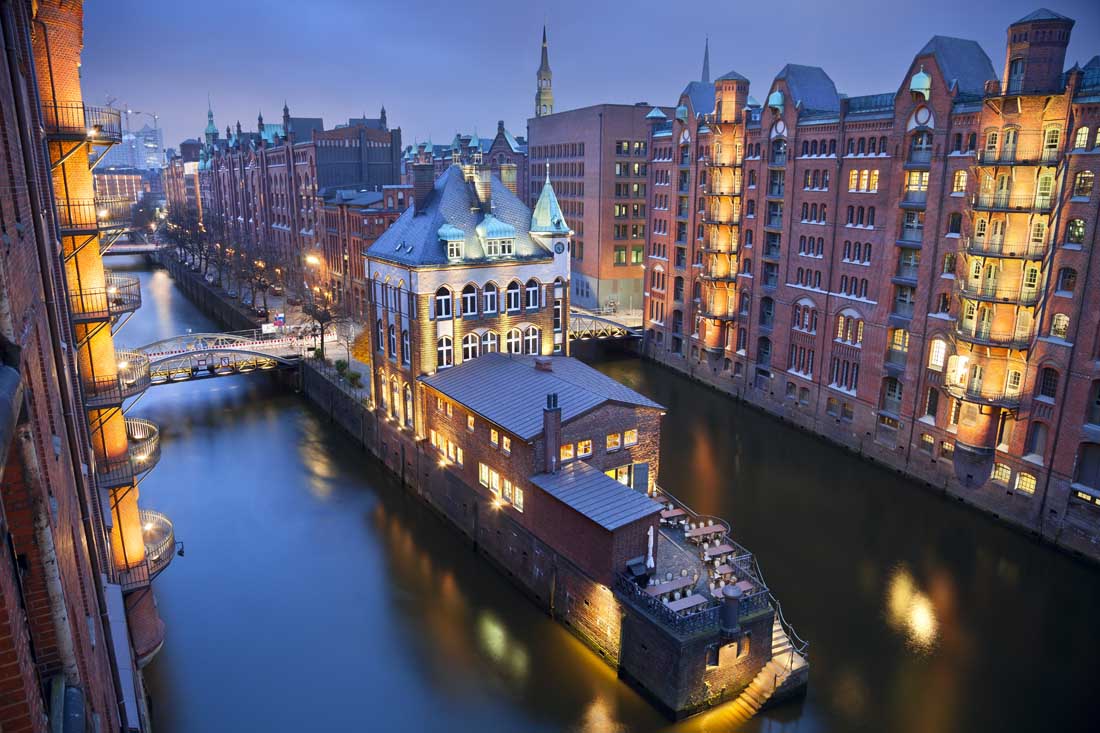
When is the best time to visit Switzerland or Germany?
Both destinations experience a temperate climate with four distinct seasons. And since both cities are in the northern hemisphere, summer is in July and winter is in January.
Because Switzerland is a mountainous nation and in the heart of Europe, you can expect cold, snowy winters here. But the summers can be warm, sunny, and pleasant. These warmer months are a great time to come for hiking and outdoor activities, as is the fall.
Germany experiences four seasons with warm summers and cold winters. The mountain ranges in the south are popular with skiers, and as such see quite a bit of snow and cold temperatures in the winter. Summers can be quite warm, especially in the central regions. Spring and autumn are both very pleasant.
Deciding when to visit Switzerland really depends on what you hope to do there. The winter months are most popular for skiing and other winter sports. March and April is when most of the ski resorts close for the season, so this is a low season in the area. As the spring progresses, more hiking trails will become accessible and by June most trails are great for hiking. July and August is the summer high season when hiking and biking are most popular. By October the weather is getting cooler but it's still too warm for skiing, so this is a low season. December is popular because of the charming Christmas atmosphere and by late December ski resorts are starting to open up.
Germany is a popular year around destination. It stays cooler than southern Europe during the summer months and there are a variety of festivals in late summer and early fall. Christmas is also a popular time to visit as many towns have a lot of charm and character.
Should I visit Switzerland or Germany in the Summer?
Both Germany and Switzerland are popular destinations to visit in the summer with plenty of activities. Most visitors come to Switzerland for the hiking and the family-friendly experiences during these months. Also, the summer months attract visitors to Germany because of the hiking and the family-friendly experiences.
In the summer, Bern is a little warmer than Berlin. Typically, the summer temperatures in Bern in July average around 21°C (70°F), and Berlin averages at about 19°C (66°F).
It's quite sunny in Berlin. The sun comes out a lot this time of the year in Bern. Bern usually receives more sunshine than Berlin during summer. Bern gets 250 hours of sunny skies, while Berlin receives 227 hours of full sun in the summer.
In July, Bern usually receives more rain than Berlin. Bern gets 63 mm (2.5 in) of rain, while Berlin receives 50 mm (2 in) of rain each month for the summer.
- Summer Average Temperatures July Bern 21°C (70°F) Bern 19°C (66°F)
Should I visit Switzerland or Germany in the Autumn?
Both Germany and Switzerland during the autumn are popular places to visit. The autumn months attract visitors to Switzerland because of the hiking trails, the shopping scene, and the natural beauty of the area. Furthermore, the hiking trails, the shopping scene, and the natural beauty of the area are the main draw to Germany this time of year.
In October, Bern is generally a little warmer than Berlin. Daily temperatures in Bern average around 13°C (55°F), and Berlin fluctuates around 10°C (50°F).
In the autumn, Bern often gets more sunshine than Berlin. Bern gets 126 hours of sunny skies this time of year, while Berlin receives 106 hours of full sun.
Bern usually gets more rain in October than Berlin. Bern gets 49 mm (1.9 in) of rain, while Berlin receives 35 mm (1.4 in) of rain this time of the year.
- Autumn Average Temperatures October Bern 13°C (55°F) Bern 10°C (50°F)
Should I visit Switzerland or Germany in the Winter?
The winter attracts plenty of travelers to both Switzerland and Germany. The skiing, the museums, the Christmas ambience, the shopping scene, and the cuisine are the main draw to Switzerland this time of year. Furthermore, many travelers come to Germany for the skiing, the museums, the Christmas ambience, the shopping scene, the theater shows, and the cuisine.
Be prepared for some very cold days in Berlin. It's quite cold in Bern in the winter. Bern is much warmer than Berlin in the winter. The daily temperature in Bern averages around 3°C (37°F) in January, and Berlin fluctuates around -0°C (31°F).
Bern usually receives more sunshine than Berlin during winter. Bern gets 65 hours of sunny skies, while Berlin receives 42 hours of full sun in the winter.
In January, Bern usually receives more rain than Berlin. Bern gets 54 mm (2.1 in) of rain, while Berlin receives 40 mm (1.6 in) of rain each month for the winter.
- Winter Average Temperatures January Bern 3°C (37°F) Bern -0°C (31°F)
Should I visit Switzerland or Germany in the Spring?
The spring brings many poeple to Switzerland as well as Germany. Many travelers come to Switzerland for the natural beauty. Additionally, many visitors come to Germany in the spring for the natural beauty.
In the spring, Bern is a little warmer than Berlin. Typically, the spring temperatures in Bern in April average around 11°C (52°F), and Berlin averages at about 9°C (47°F).
In the spring, Bern often gets around the same amount of sunshine as Berlin. Bern gets 164 hours of sunny skies this time of year, while Berlin receives 160 hours of full sun.
Bern usually gets more rain in April than Berlin. Bern gets 59 mm (2.3 in) of rain, while Berlin receives 40 mm (1.6 in) of rain this time of the year.
- Spring Average Temperatures April Bern 11°C (52°F) Bern 9°C (47°F)
Typical Weather for Berlin and Bern
Related articles for switzerland, related articles for germany.

More Destination Comparisons
Subscribe to our newsletter.
By signing up for our email newsletter, you will receive occasional updates from us with sales and discounts from major travel companies , plus tips and advice from experienced budget travelers!
Share This Page
Pin this page.
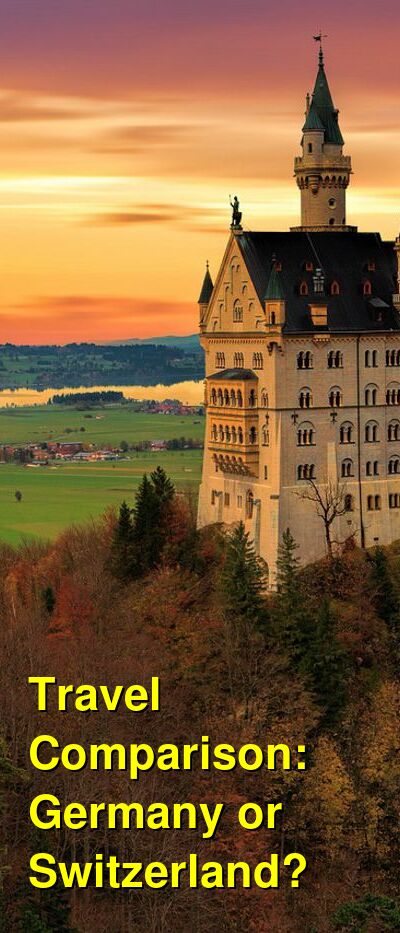
Some of the links on this website are sponsored or affiliate links which help to financially support this site. By clicking the link and making a purchase, we may receive a small commission, but this does not affect the price of your purchase.
- Privacy / Terms of Use
- Activities, Day Trips, Things To Do, and Excursions

Germany Austria Switzerland Itinerary: 10 Days on the Road
You’ve decided on your Europe trip and you’re now wondering how to plan it. I can help with that!
I lived in Southern Germany (Stuttgart) for six years and traveled to Switzerland and Austria more times than I can count. Since it was just a few hours away, we went for festivals, ski trips, summer hiking, and exploring beautiful villages and cities.
While I don’t recommend trying to cram as much as possible into one trip, I think it’s very doable to visit these three countries within 10 days.
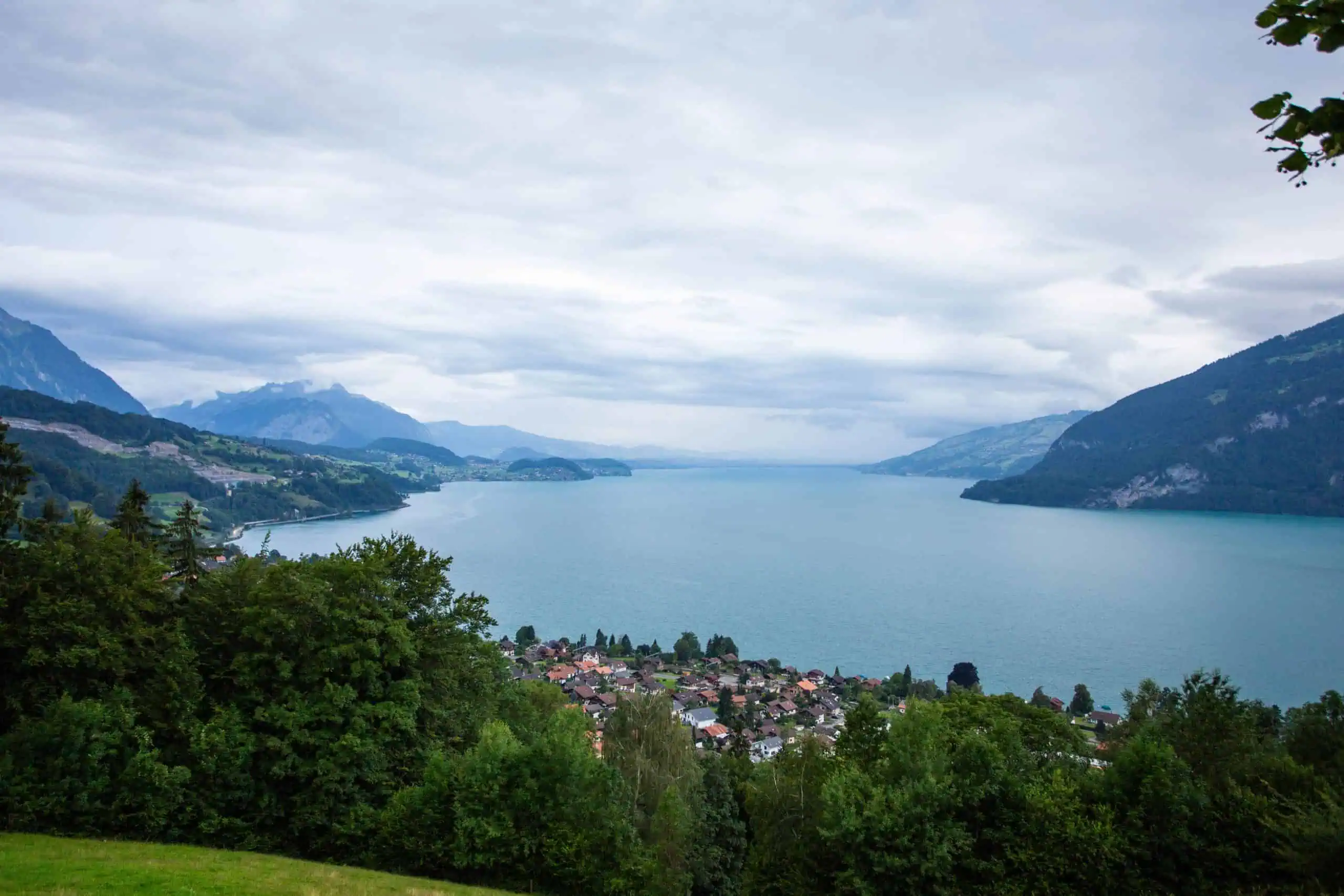
I’m sharing what I think is the best 10-day Germany, Austria & Switzerland itinerary that’ll show you how to make the most out of your time.
With this itinerary, you will stay within certain regions of each country so you’re not on the road the entire time.
You’ll have a mix of scenery, busy days, tours, and downtime. The goal is to divide your time over as many activities and places as possible without rushing through them.
Overall, you’ll be splitting your time nearly evenly in each country.
Keep reading for all the details about this itinerary. Every detail has been thought out for the most memorable trip you can have!
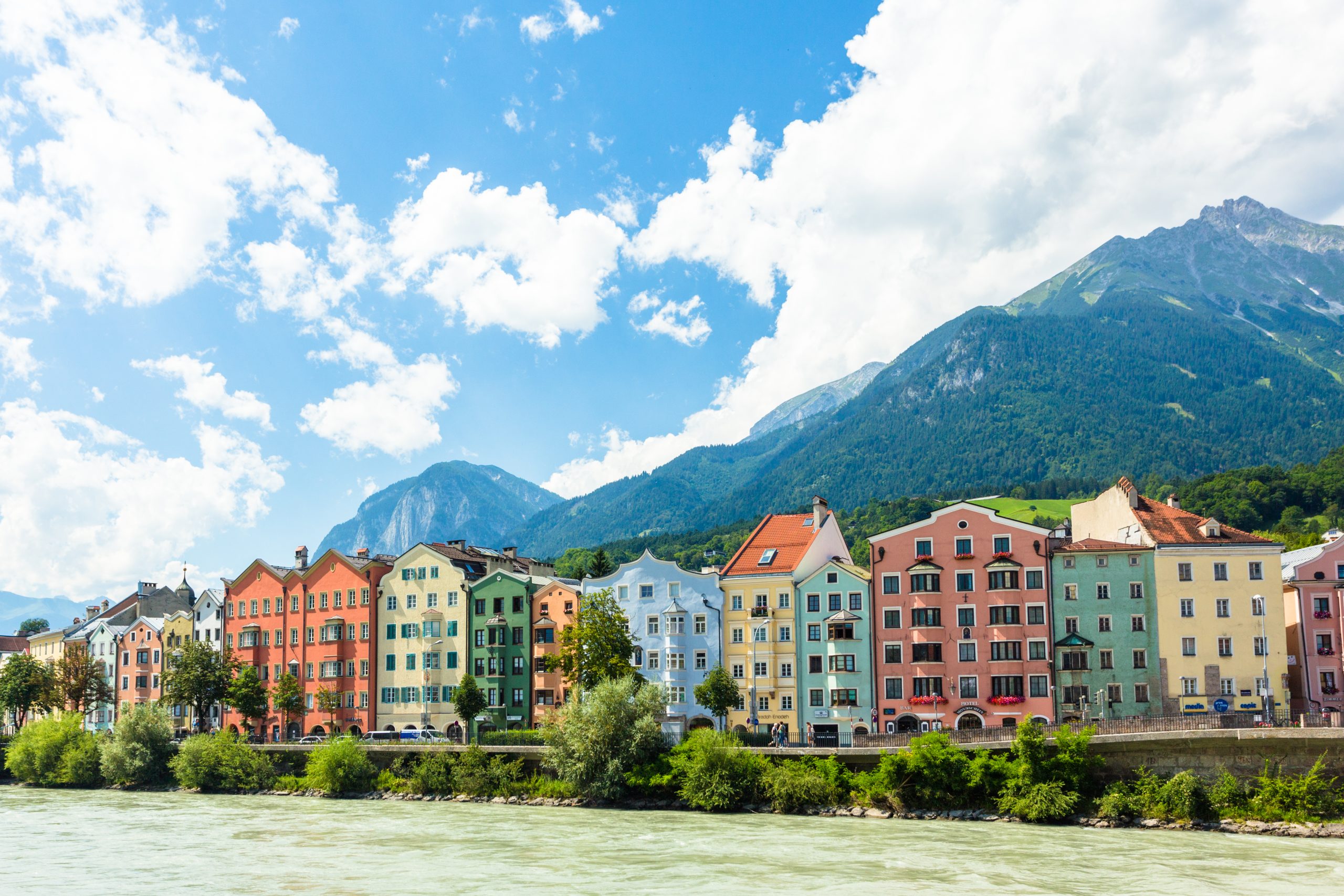
Why Combine Germany, Austria, and Switzerland on the Same Trip?
We all know Europe is full of amazing countries with wonderful spots for traveling, so why does this trip include Germany, Austria, and Switzerland instead of someplace else like Italy, Spain, or France? And why only these 3 countries?
Well, this combination has logical, geographical, and experience-related motives.
They’re Close
First, it simply makes sense to combine Germany, Austria, and Switzerland. These 3 countries are very close to one another – they literally share borders.
If you check a map of central Europe, you’ll see that Germany borders both Switzerland and Austria from the south, whereas Austria is to the east of Switzerland.
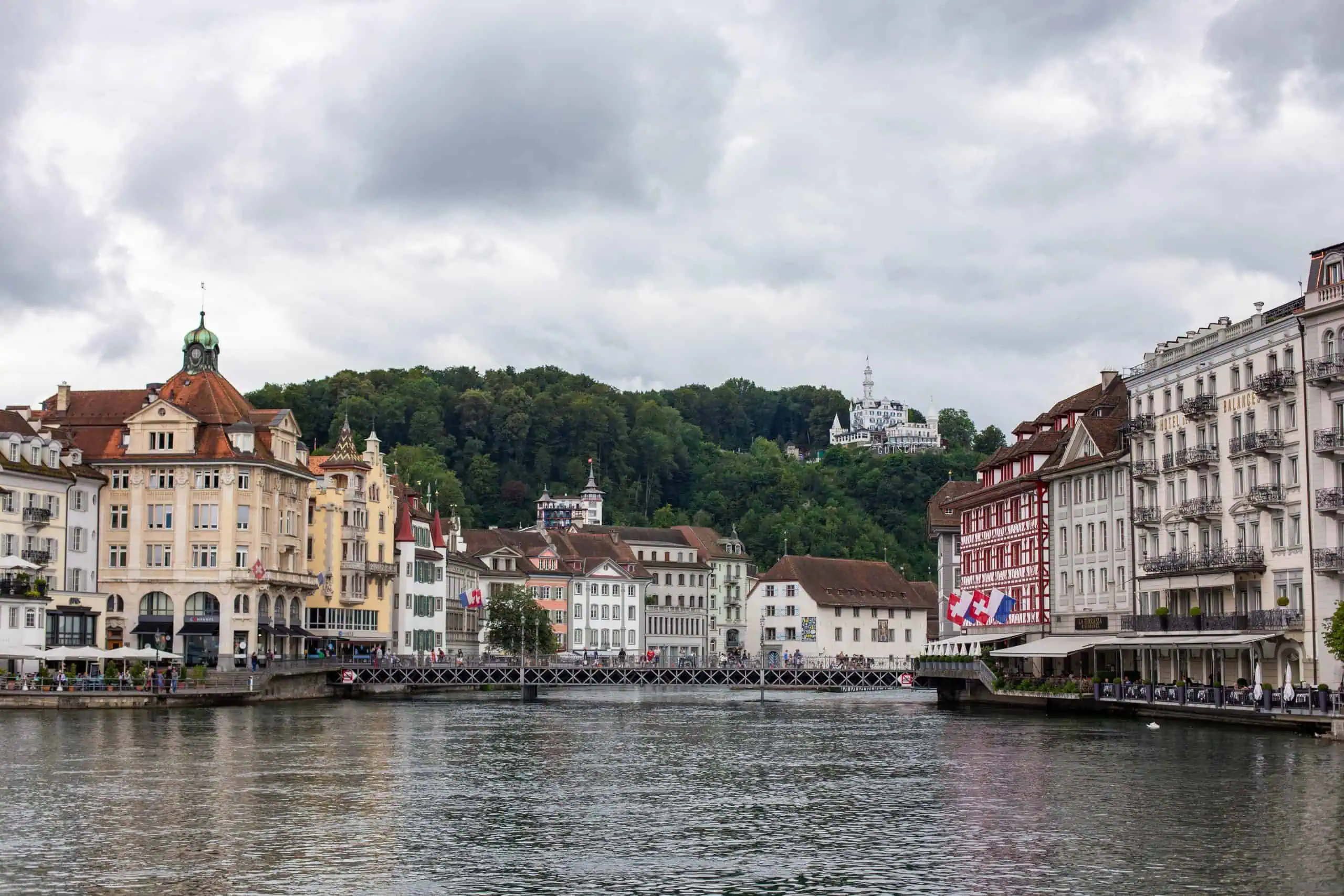
They Have the Same Language
Another reason why it’s a good idea to combine Germany, Austria, and Switzerland into one trip is the common language.
All 3 of these countries speak German. It’s one of the 4 official languages of Switzerland and the sole official one in Austria.
If you don’t speak German, this combination means you can learn some basic phrases in German and use them for all the places you’ll visit.
This isn’t an obligation since you can get by just fine with English, but showing you know a few phrases goes over well with locals.
They’re Versatile and Have a Lot to Offer
Last but not least, combining Germany, Austria, and Switzerland gives you a rich experience with a wide range of activities to satisfy different interests.
These countries have natural landscapes with lakes, waterfalls, rivers, mountains, and more. They have historical sites, museums, art, architecture, adventures like hiking or paragliding, and cuisine among many other cultural aspects.
This means you’re guaranteed to enjoy your visit no matter what you’re looking to do.
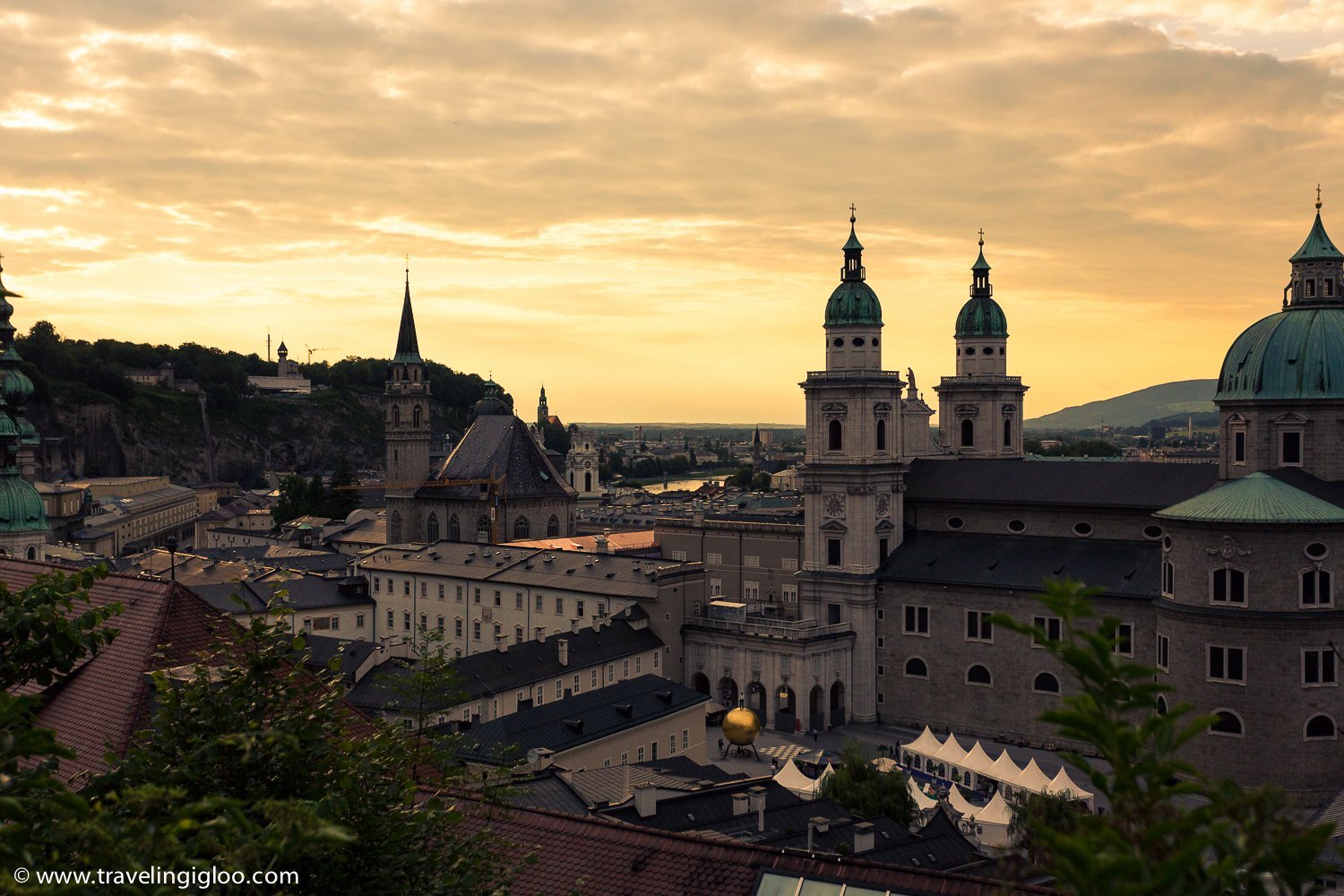
Are 10 Days Enough for Visiting Germany, Austria, and Switzerland?
The answer to this heavily depends on your travel style and what you’re looking to accomplish with the trip.
If you’re a home base type of traveler who likes to deeply explore a single location at a time, 10 days likely won’t be enough for you to thoroughly cover even 1 of the countries.
If you’re a go-go-go traveler who aims to see as much as possible of the places they go, then 10 days are probably enough to see a lot of the 3 countries since they’re quite close to one another. However, this approach isn’t the most comfortable or rewarding in my opinion.
If you prefer a balanced approach, then I believe 10 days will be enough for you to experience and enjoy a bit of each country to a pretty satisfying level. This travel style is what I’ve gone for with this itinerary.
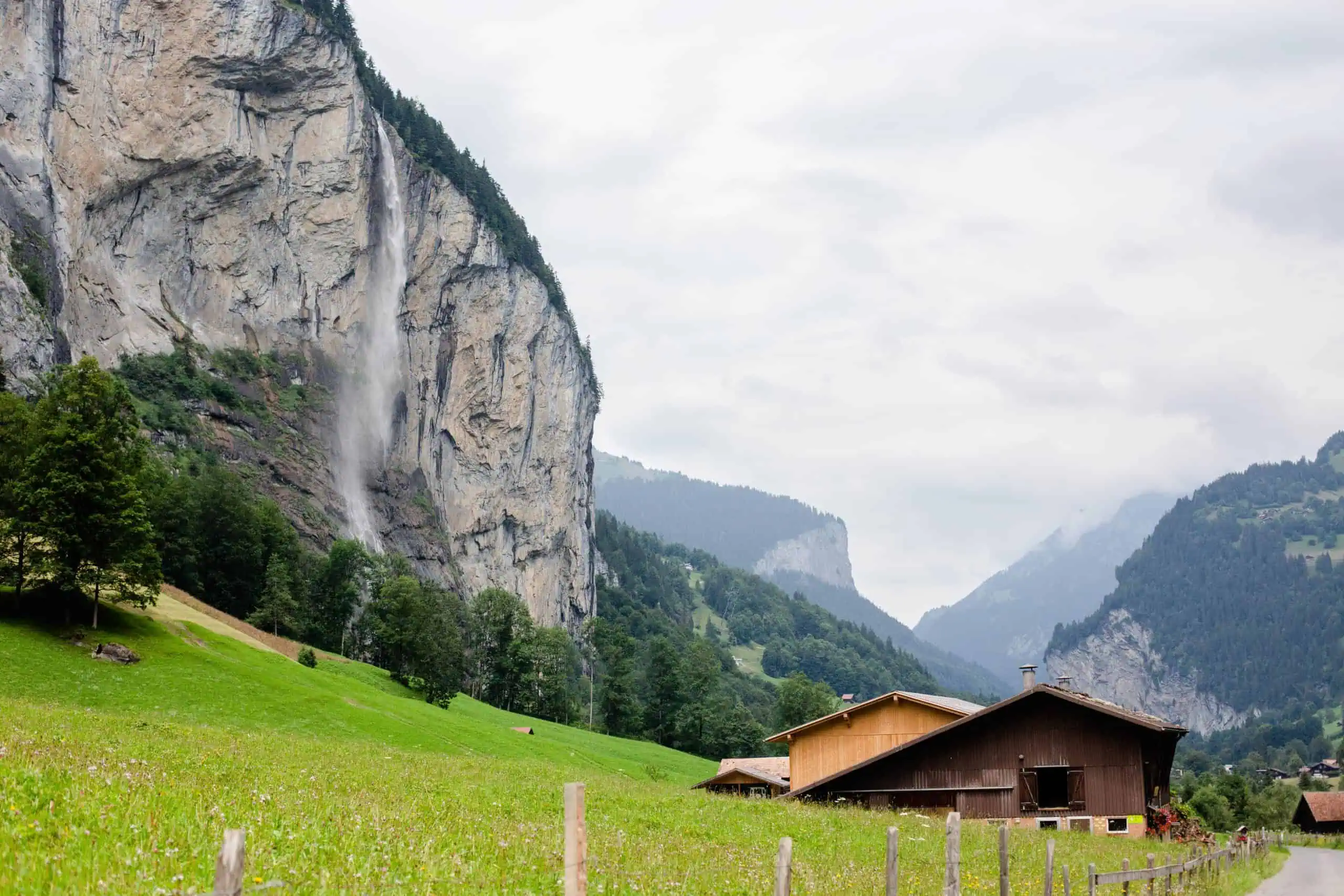
How to Get Around During a Germany, Austria, and Switzerland Trip?
Making your way around Germany, Austria, and Switzerland (or Europe in general) is basically a choice between 2 means of transportation: car or train.
Each option has its pros and cons, so I’ll highlight them in this section to help you choose what works best for you.
Taking a Car
This itinerary was created for a car, but you can just as easily take a train too.
The upside of getting around with a car is that you don’t need to worry about sticking to a departure schedule. You can set off according to your own time and you’ll never miss your ride.
A car can also be the faster method to reach some places since you can take shortcuts and don’t have to make stops along the way. Not to mention, taking a car allows you to go on side trips and make detours.
That said, taking a car in Europe can be more expensive than taking a train. Not only because of the rental cost but also the gas and road tax.
- Vignette : Austria and Switzerland both require a vignette, which is a sticker you purchase at a gas station or store to go on your windshield. In Austria, you’ll spend less than 20EUR, but the Swiss vignette runs about 40-45USD (depending on the exchange rate).
- Gas : Gas in Europe is much more expensive than in the US, about 3-4 times the cost.
- Car Rental : Compared to places like the US, a rental car will be considerably cheaper in Europe. Typically you can find a small to midsize sedan for $30-50/day. I always book through Discover Cars , an aggregate company that helps you find the best prices (often lower than through the company directly). They also have fantastic customer service, which can be hard to find in the rental car industry.
Driving in Europe can sound daunting, but these three countries are fairly easy to navigate. The roads are well-maintained and drivers follow the rules of the road. There are plenty of well-marked signs and it’s likely that your rental will have GPS included.
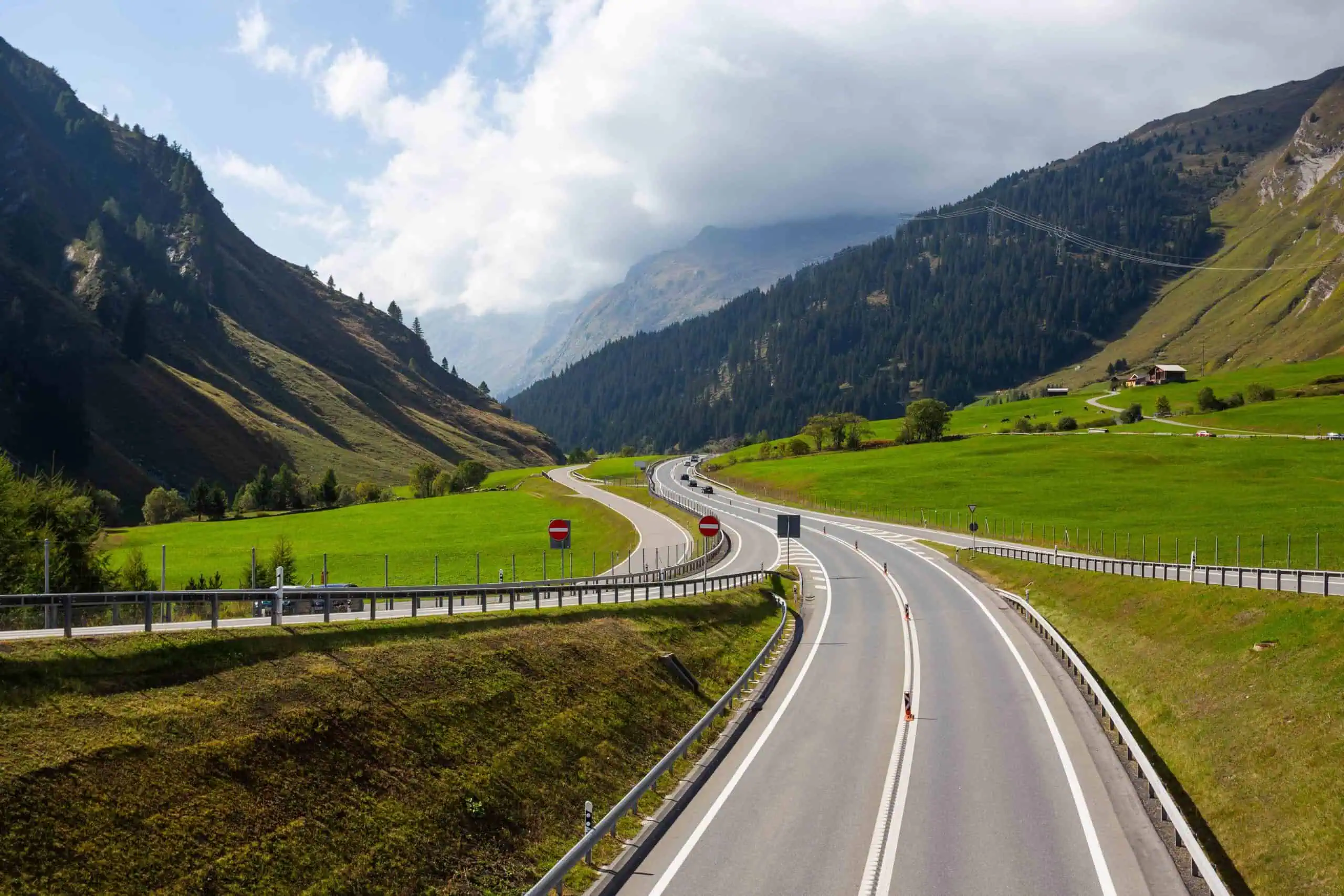
Taking a Train
While in Europe, trains are a great way to get around. They’re fast, clean, and efficient (especially in these countries!). And train stations are in the center of towns or cities, so once you disembark you’re not too far from your hotel.
They’re also pretty affordable, so you can save much of your budget for the actual visit. Also, you’ll be relieving yourself from the hassle of driving in a new/foreign country.
The downside to trains, however, is having to plan your time around their schedule. Besides the lack of flexibility, you’re also likely to take a longer time to get to your destination by train vs by car.
Some of these trips require multiple connections, so you’ll need to pay attention as well.
Additionally, some places are tricky to reach by train. You’ll get off at the nearest point but have to figure out how to make it to the specific spot you want to visit.
There are many different ways to book train tickets in Europe which deserves its own post. I priced out this trip in May via RailEurope and it is $324 per person (I’m looking about 9 months out). With the Eurail Pass, it’s $292 (but you still need to pay a few euros to reserve seats).
The Eurail Pass is more flexible (i.e. you can change train times if there are open seats) which can be more appealing. Please note the train from Salzburg to Berchtesgaden cannot be booked via Eurail.
Booking your train tickets early is key to finding low prices. If you wait until the last minute, you could end up spending a lot more on your tickets.
Children under 15 travel free via train.
TRIP OVERVIEW & MAP 10 DAYS SWITZERLAND | AUSTRIA | GERMANY ITINERARY
DAY 1: Arrive in Zurich & Head to Lucerne DAY 2: Lucerne to Interlaken/Lauterbrunnen DAY 3: Grindelwald & Junfraujoch DAY 4: Travel to Innsbruck & Overnight DAY 5: Travel to Salzburg & Explore DAY 6: Berchtesgaden | Königsee | Eagle’s Nest DAY 7: Salzburg Day Trip DAY 8: Travel to Munich & Explore DAY 9: Neuschwanstein Day Trip DAY 10: Fly Home
Click on map below to see full map in Google Maps.
Germany Austria Switzerland 10-Day Itinerary
Day 1: arrival in zurich & head to lucerne.
- Distance by car: 52.5km (32 miles)
- By Train: 40-60 minutes, no connections
- Country: Switzerland
- Currency: Swiss Franc (CHF)
Your 10-day trip to Germany, Austria, and Switzerland will start with your landing in Zurich, Switzerland’s capital
Assuming you arrive early in the morning, you’ll have 3 full days to explore Switzerland.
With this itinerary, I didn’t plan a day in Zurich because it’s a massive business city and one of the most expensive in the world. The town of Lucerne is much more quintessential Switzerland and a much cuter town.
If you would like to get a taste of the city, however, I recommend heading to the old town (Altstadt) and exploring for a few hours before heading to Lucerne. It’s only 6 miles from the airport to the city center and easily accessed via train or car.
Lucerne is only about 45 minutes from Zurich, so you could spend most of your day in Zurich and then make your way to Lucerne for the evening.

If you decide to head straight to Lucerne (which I highly suggest), here’s how to spend your day.
Grab a bite before on your way to Lucerne or have breakfast when you get there. Some of my favorite places to fill up on breakfast or lunch are Richemont Gastronomioe , Mill’Feuille , and Antons Restaurant .
After food, you’ll start exploring the old and new towns. You can walk around on your own or join a walking tour such as the one to Chapel Bridge and Old Town or one with a local via LocalBini.
While exploring the old town, don’t miss the sight of the iconic Lion Monument. It dates back to the 1820s and pays tribute to the Swiss Guards who were murdered during the French Revolution.

You can also wander along the lake or catch a boat ride over it with a 1-hour cruise .
If you’re into museum visits, here are some great options such as the Richard Wagner Museum, Sammlung Rosengart Museum, Swiss Museum of Transportation, or Chocolate Adventure Pavilion.
Don’t forget to snap some pictures at the Chapel Bridge. It’s a covered wooden footbridge that crosses the river Reuss. It contains various interior paintings dating back to the 1600s and features a unique flower pot decor along its guard rails.

When dinner time rolls in, be sure to try the country’s world-famous dishes such as fondue, raclette, Älplermagronen, and Rösti. Among my top restaurants for Swiss cuisine are Restaurant Balances , Hermitage , and Gasthaus Schlüssel .
Hotel Recommendations
Most hotels are located in the Old Town, so head over to Waldstatterhof Swiss Quality Hotel or Ibis Styles Luzern for the night whenever you’re ready.

Day 2: Exploring Lauterbrunnen & Interlaken
- Distance by car: 67.6km (42 miles)
- By Train: 2.5-3.5hrs (1+ connections)
Start the day with breakfast at your hotel or at one of the restaurants I mentioned above. Then, you’ll leave from Lucerne to Lauterbrunnen.
Lauterbrunnen looks like something out of a storybook. Here you’ll see mountains jutting out of the ground and 72 waterfalls all over the mountain valley.
These mountains are sheer rock faces overlooking a wide valley. It was formed by glaciers over millions of years. You’ll often spot base jumpers and other extreme sports enthusiasts enjoying nature’s playground.
Interlaken is a beautiful little town between the green glacial lakes of Thunersee and Brienzersee (‘see’ means lake). It’s about a 20-minute drive from Interlaken to Lauterbrunnen, and you can stay at either location for beautiful views (although Lauterbrunnen sits right in the valley).
Tip: This area has many cable cars going up mountains, boat rides on the lakes, funiculars, and trains to the tops of mountains. There are a lot of ways to see this area! If you want to dig in and explore, I recommend purchasing the Jungfrau Travel Pass . It covers nearly everything with a few exceptions that you can read about here .
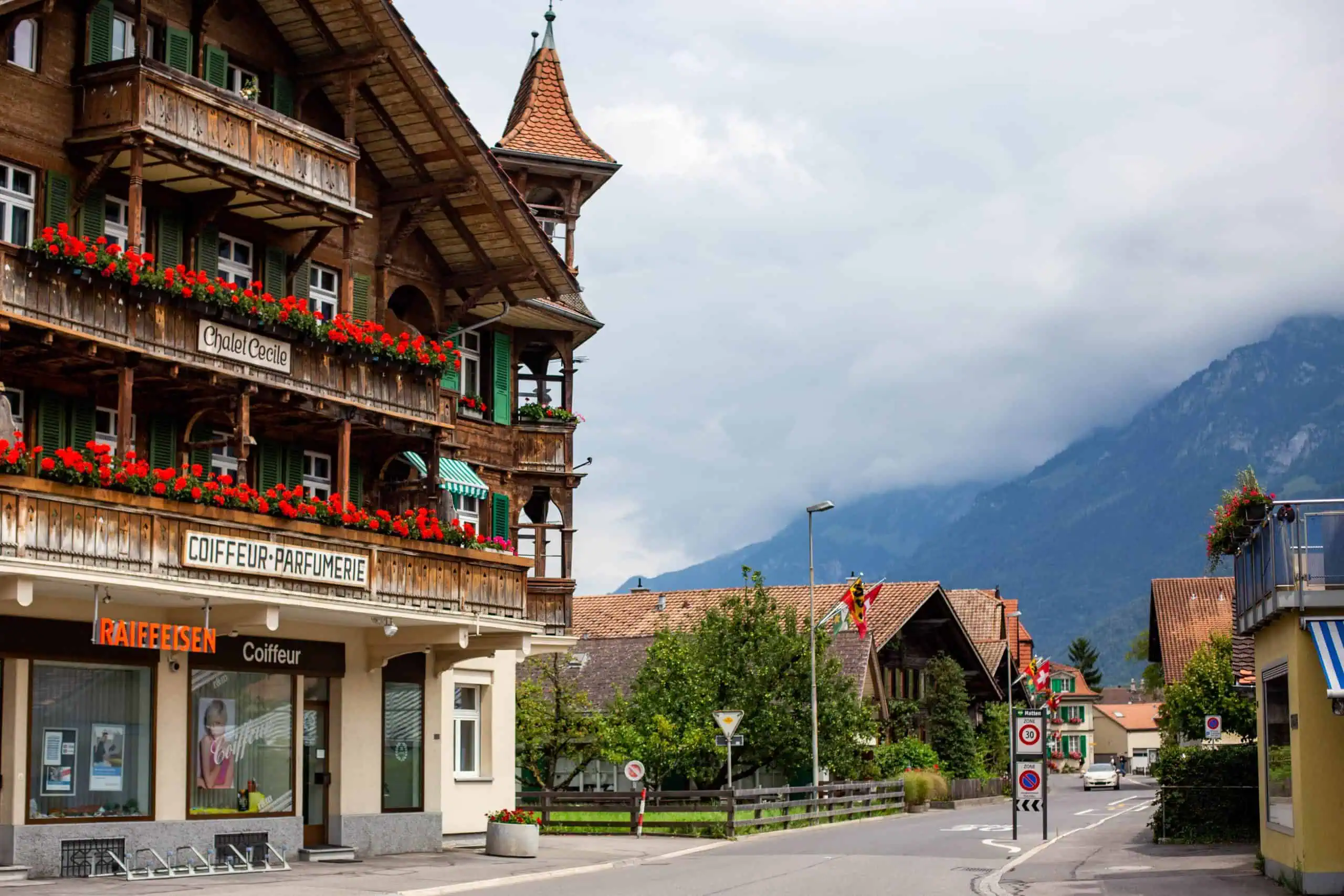
Here are my top recommendations for a day in Lauterbrunnen:
WALK THROUGH THE BEAUTIFUL VALLEY FLOOR
Make your way into the valley and park at Lauterbrunnen. From here, walk one of the many trails throughout the valley. You could go on for miles or take a quick stroll.
If you want to really see all the highlights, though, book this guided tour from Interlaken . You’ll see the best waterfalls in the area and learn about the history of this beautiful valley. This is a great option especially if you don’t have a car.

GO PARAGLIDING IN INTERLAKEN
Paragliding in Interlaken was my absolute favorite activity the last time we visited the area. We went nearly 10 years ago and we still talk about it today. It was a highlight for sure! Because you just drove in today, I recommend doing this early the next morning so you can really explore the valley. I booked with this tour company and loved them.
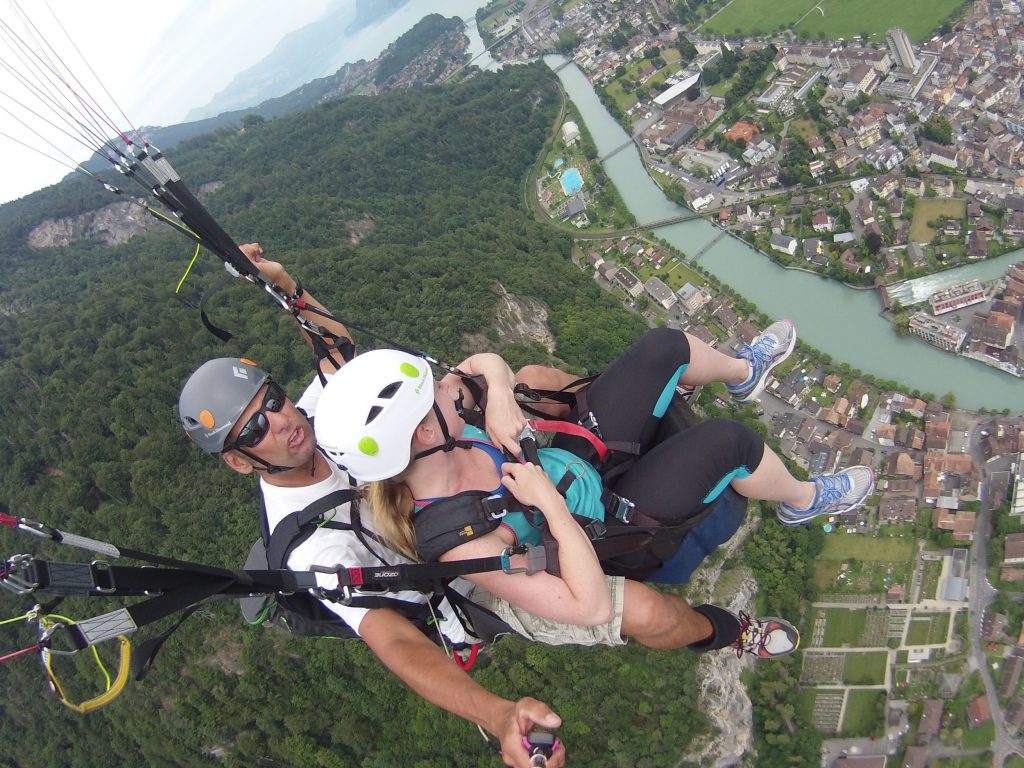
VISIT TRÜMMELBACH FALLS
Trümmelbach is the only glacier waterfall in the world that can be accessed underground. These are Europe’s largest subterranean waterfalls and are impressive to see in person.
There are three glaciers feeding meltwater through here to create these falls. And it’s a lot of water! At 20,000 liters per second, you can imagine how powerful and mighty these falls are.
HIKE ONE OF THE WATERFALL TRAILS
There are tons of hiking opportunities throughout the massive valley. And some lead to villages such as Murren or Wengen.
Some hotels I’d recommend for your stay are Chalet Rosa B&B and Hotel Oberland .
If you don’t wish to stay in Lauterbrunnen, there are so many options in this area. One time we stayed at this small hotel in Le issigen, a small town above Lake Thun (Thunersee). I liked it here because it’s so quiet and you stay at a traditional Swiss mountain home that’s been converted into a hotel.
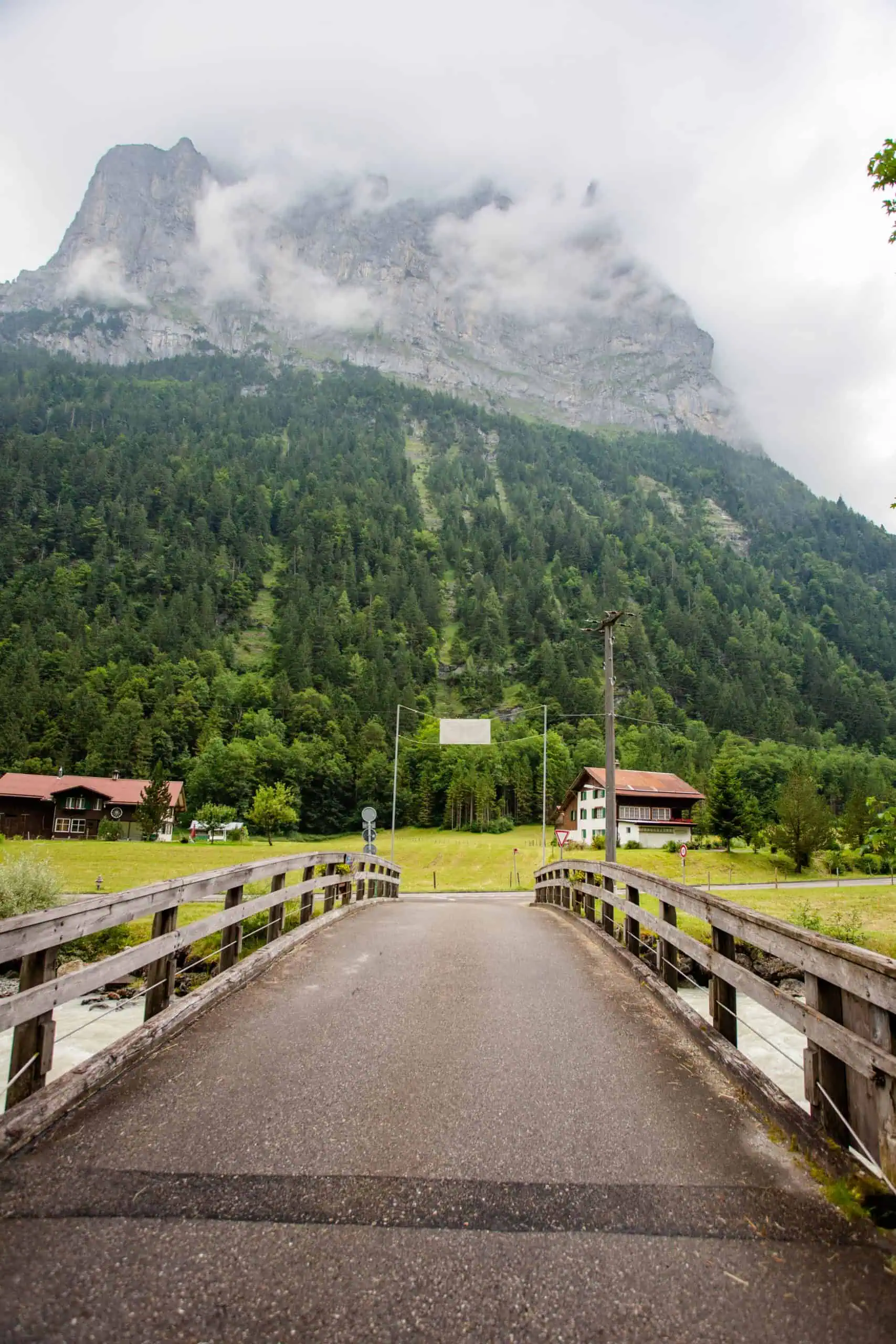
Day 3: Exploring Grindelwald and Jungfraujoch (Top of Europe)
- Distance by car: 20.3km (12 miles) to Grindelwald. Train required after Grindelwald.
- By Train: 43 minutes to Grindelwald. Then train to Jungfraujoch.
Today you’ll head to Grindelwald and then to Jungfraujoch, called the Top of Europe. This trip takes a bit of time so I recommend starting early. To reach Jungfraujoch, you need to take a train from Grindelwald.
Grindelwald is a small Swiss village in the beautiful Swiss Alps. It’s also a great launching point for Jungfraujoch, a massive mountain at 11,000ft and the tallest in Europe!

GO TO THE TOP OF JUNGFRAUJOCH
From Grindelwald, you can take the Eiger Express train to the top and back (be sure to book these tickets ahead of time). When you book, you can select how long you wish to stay at the top. There’s plenty to do, including seeing the longest glacier in Europe, taking in the sweeping views, and exploring an underground ice palace with ice sculptures.
I recommend going up Jungfraujoch in the morning so you can spend your afternoon at Grindelwald, but it’s really up to you how you want to plan your day. I prefer to not feel like I’m waiting around to board a train, so I prefer to do those activities in the morning and then be free to explore the rest of the day.
EXPLORE GRINDELWALD
Grindelwald itself has tons to do. Since you’re short on time, I recommend walking the town and grabbing a bite to eat.
For something more adventurous, there’s plenty to do! Soar like an eagle on a fast-moving glider , walk on the cliff walk overlooking the mountains below, or drive a mountain cart , among other things. Note that some of these things require a gondola or cable car ride.
If you prefer to keep your feet planted, go on one of the many hikes in the region such as the Kleine Scheidegg .
At the end of the day make your way back to Interlaken or Lauterbrunnen for your last night in Switzerland.
Day 4: Explore Innsbruck
- Distance by car: 380km (236 miles)
- By Train: 6-7 hours with 3+ connections
- Country: Austria
- Currency: Euro
The following morning you’ll travel from Interlaken to Innsbruck, a cute college town in the mountains of Austria.
This town makes for a great stopping point between Switzerland and Salzburg.
If you went straight through, the drive would take about 7 hours (assuming there’s zero traffic and you don’t stop), and even longer via train. So I recommend a stopover night in this beautiful and historic town to break up your trip.
I also like this drive because you go through some spectacular mountain scenery, and even cross through the small country of Liechtenstein (look out for the black license plates!).

If you prefer something a bit quieter, I recommend looking into the Achensee, a pretty Alpine lake about 55km (34 miles) from Innsbruck.
If you’re driving, don’t forget to get a Vignette sticker before you cross the border to Austria. It‘ll cost you around 10 EUR, and if you don’t buy one you could get a huge fine of over 100EUR. Vignettes are available at all gas stations.
Since the drive will fill a good portion of your day, here is how I recommend spending your afternoon/evening:
- Walk the cute old town (Altstadt) and check out some of the shops, cafes, and restaurants.
- Visit OlympiaWorld and learn about the 1976 Olympics.
- Climb the town tower for beautiful views.
Each time we’ve been to Innsbruck, we’ve stayed at these beautifully maintained apartments just up the hill from the old town. There are hiking trails from the apartment and a lovely farm-to-table restaurant on the mountainside called Gasthaus Planötzenhof Andreas Heis . If you like pretty views with your meal, then I recommend this place!

Day 5: Explore Salzburg
- Distance by car: 166km (103 miles)
- By Train: 2 hours, no connections
Today you will make your way to Salzburg, just a few hours from Innsbruck. As you’re likely tired from all this travel, you’ll get a chance to relax and enjoy a few nights in the Salzburg area.
Expect more scenic views and an easy drive. If you’re driving, there are three routes to get there, and you can’t go wrong with any of them.
When you arrive at Salzburg (aka the City of Mozart ), you’ll probably be ready to explore.
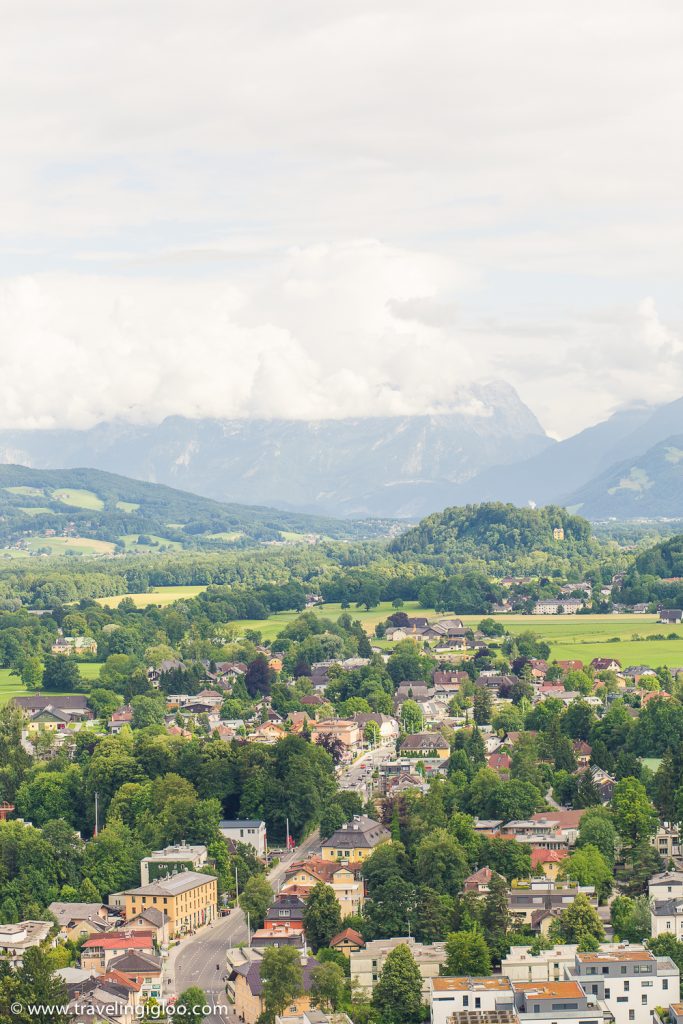
Make your way to the Old Town (Altstadt). It’s a small but packed old town filled with shops, restaurants, cafes, bars, and cathedrals.
A must-see spot is Mozart’s birthplace at the intersection of Hagenauerplatz Square and Getreidegasse Street.
There are various walking tours, but you can easily walk yourself. If you want to learn about the history of the area, I recommend this 2.5-hour tour that starts at Palace Mirabell and takes you through the Makartplatz, New & Old Town, Mozart’s Birthplace and ends at the top of Mönchsberg Hill (optional).
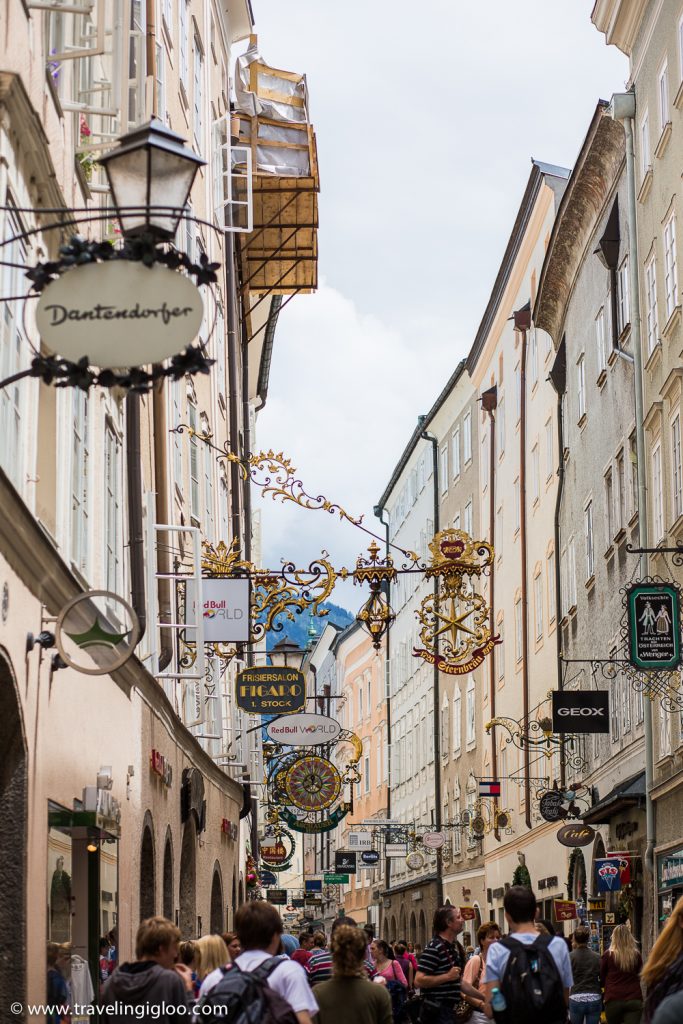
You’ll also see River/Mozartsteg, Toscanini Hof, St. Peter’s Cemetery/Church, Alter Markt, Mirabell Gardens, Kapitelplatz, and many more places.
There are also food tours where you can see the city while experiencing Austrian cuisine. I recommend this one for food tasting or this one for beer tasting in Old Town
It’s hard to miss the imposing Hohensalzburg Fortress perched above the Altstadt. To get there, you can either walk the switchback path to it or take the funicular for about 5EUR (ascent and descent, admission included).
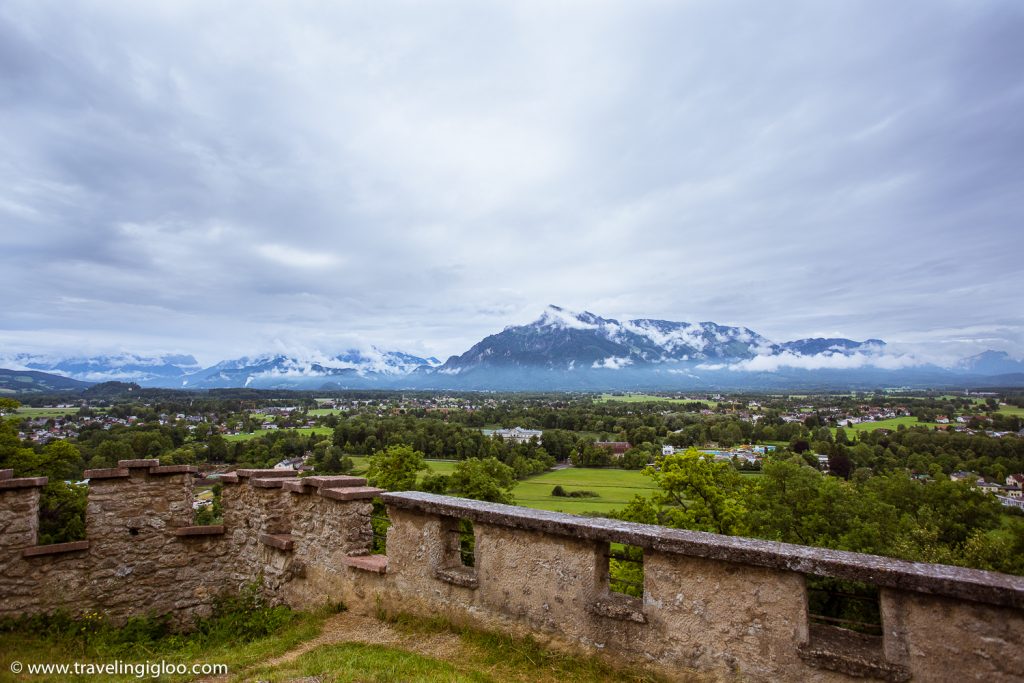
Once at the top, get ready to be blown away by the 360 views. Explore the medieval interior of Europe’s largest intact medieval castle. You can see the Salzburg Bull, the Archbishop Chapel, Golden Hall, and Golden Chamber.
Don’t go back down too soon. You can take the Monchsberg road to reach Augustiner bräu – Kloster Mülln, Austria’s largest beer tavern. For a delicious meal, try the Gasthaus Burgschenke .
My top recommendation for dinner is the Mozart Dinner Concert at St. Peter Stiftskulinarium in the old town. It’s the oldest restaurant in Central Europe.
Call it a night at Altstadt Hotel Hofwirt Salzburg or MEININGER Hotel Salzburg City Center .

Day 6: Explore Salzburg/Berchtesgaden
- Distance by car: 34.6km (21 miles)
- By Train: 1 hour with 1 connection
- Country: Germany & Austria
Since Berchtesgaden is a short distance from Salzburg, we’ll keep our base in the city and do a day trip from here.
Today you’ll go on a day trip to Berchtesgaden, a national park with the looming Eagle’s Nest. There are a few options for your day, depending on your interests:
TAKE A BOAT RIDE AT KÖNIGSEE
The Koenigsee is a beautiful large lake in the southern German Alps. There’s a popular boat ride that takes you along the lake to St. Bartholomew’s Church. They even have a trumpet player that shows you how well this mountain valley can echo! Once at the church, you have time for lunch and a drink before heading back. It’s a beautiful way to spend the day.

VISIT THE EAGLE’S NEST
Alternative to Lake Königsee, you can visit Hitler’s Eagle’s Nest at the top of Mount Kehlstein and the Documentation Museum. You can take a guided tour from Salzburg or a bus directly from Salzburg to the documentation center.
You can also drive yourself as well.
Once you’re done exploring, head back and recharge for the next day.
Day 7: Explore Around Salzburg: Hallstatt | Sound of Music Tour
- Distance by car: Varies
- By Train: Bus only
In and around Salzburg, there are many day trips and activities that you can enjoy early in the morning. Here are some of my recommendations.
- Sound of Music Tour : you’ll visit locations used in the movies, hear songs, take photos, and enjoy the countryside.
- Day Trip to Hallstatt : hike up the Salzberg mountain and enjoy the view of the sunrise from the Skywalk (with a photographer)
- Bike Tour Around Salzburg : about 3.5 hours through the city and countryside.
Hallstatt has become really popular in the past few years, but there are many other lakes in the area. Surrounding Salzburg, there are a total of nine lakes in this region.
Mondsee is a good option for a cute town on a pretty lake (but you won’t have the same striking town as Hallstatt). This lake is also on the Sound of Music tour as well. Attersee is the largest in the region and the most striking with mountains in the background.
Alternative Option: If you’re excited to get to Munich, you could alternatively head there today to have an extra day to explore.

Day 8: Explore Munich
- Distance by car: 147km (91 miles)
- Country: Germany
Today you’ll make your way to Munich, the beautiful capital of Bavaria and home to BMW.
Although it’s a large city, the central area is quite walkable and easy to navigate.
There is also a robust train system. The trains within cities in Germany are called ‘U-Bahn’, so look for those signs when walking around. Tickets can be purchased at the kiosks directly at the stations, or you can use their app to book your tickets.
EXPLORE MARIENPLATZ
Once you arrive and get settled, head to the center of town, Marienplatz. This has been Munich’s center square since 1158. I recommend walking around the area and exploring the shops and one of the many breweries.
You’ll see the New and Old Rathaus (town hall), St. Peter’s Church, and the Marian Column among many others. Interestingly, this place was rebuilt in the traditional style years after its demolition at the end of WWII, so it may not be physically old, but it looks the part.
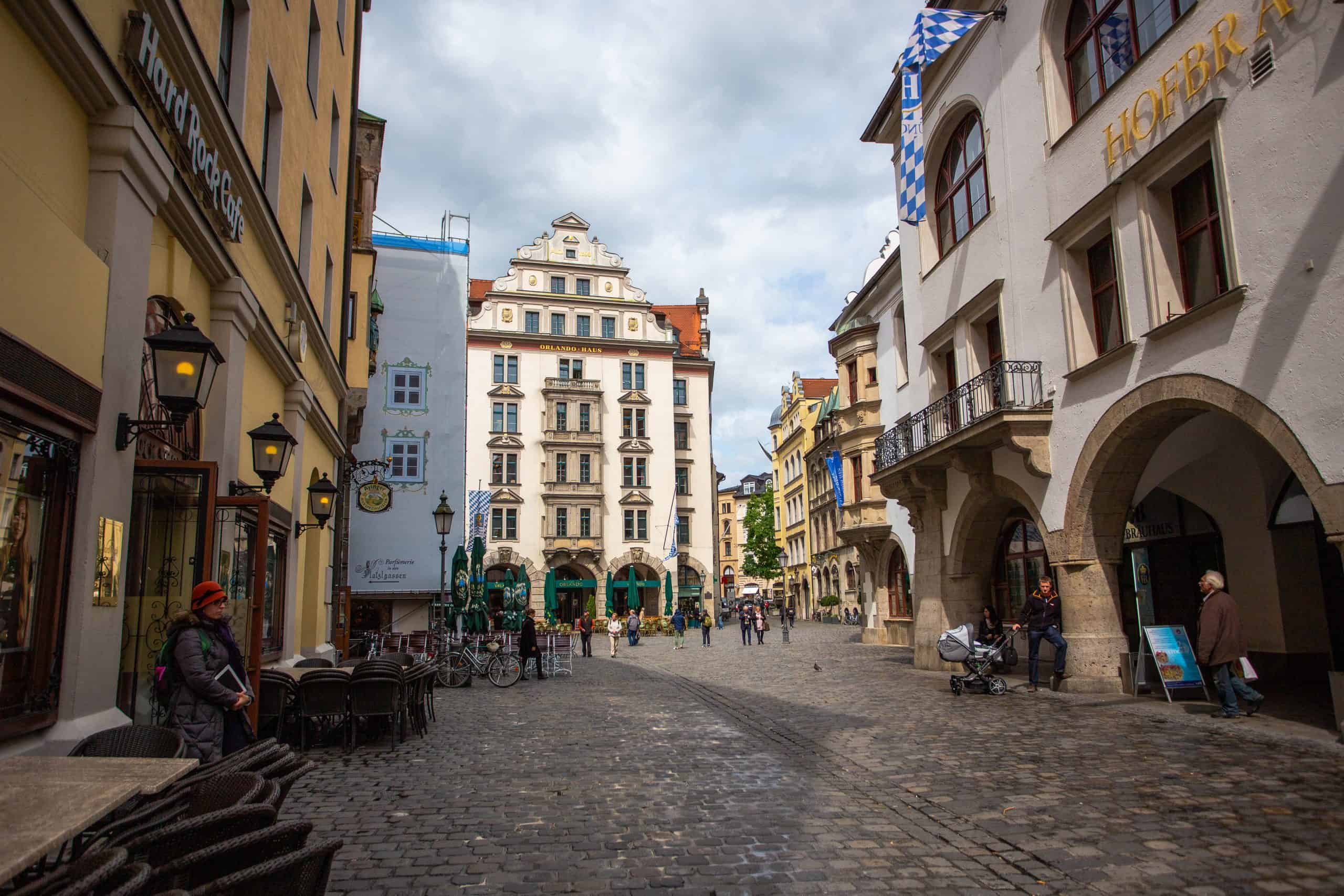
CLIMB ST PETER’S TOWER & GLOCKENSPIEL SHOW
From there, make your way to St. Peter’s Tower (best to arrive about 30 minutes before 11 or 12 to make the climb before the show starts). Go up to the observation point for a spectacular bird’s eye view of the Platz and a chance to catch the Glockenspiel show away from the crowds.
The Glockenspiel show is a 15-minute spectacle that reenacts bits of the city’s history. It takes place at 11 and 12 daily, ending with 3 chirps from a golden rooster at the top of the square’s mechanical clock.
TAKE A WALKING TOUR
If you’re into walking tours, there are many free options that start right at Marienplatz.
For something a bit more in-depth, I recommend this 1.5-hour tour of the inner city. It starts at the Marienplatz, showing you the highlights, and then heads to the Frauenkirche church, the Royal Brewery, as well as the cathedral and Theatine Church. The tour ends at the Viktualienmarkt.
When it’s time for lunch, the daily food market (Viktualienmarkt) is a fantastic option. It’s about 4 minutes from the city center. Alternatively, you can go to a beer garden for a meal and a drink.
After eating and depending on how late it is, you can explore Munich’s iconic cathedral; the Frauenkirche, the Nymphenburg Palace, or the English Garden.
WALK THE ENGLISH GARDEN
The English Garden (Englisch Garten) is a massive public park in the center of Munich. It’s even larger than Central Park.
Inside there is a huge network of trails that can keep you busy for days. If you prefer a guide to show you around, there are some great tours like this one (via GetYo urGuide) that take you through Marienplatz and the English Garden.
The English Garden is close to Marienplatz, so you can simply head here once you’re done exploring the Marienplatz area.
Here are my top 3 things to do:
- Watch people surf at the Eisbachwelle . This is located at the very south end of the English Garden next to a road. But stopping here is worth it! I thought it was so fun to watch people surfing in the center of a huge city. If you are heading to the English Garden from Marienplatz, you can stop here first.
- Visit the Chinese Tower (Chinesischer Turm) . The Chinese Tower was built as an observation tower. Sadly it was destroyed in WWII, but has been rebuilt in its former style. The second largest beer garden is here, and it’s a great place to grab a beer and have something to eat. It’s about a 15-20 minute walk (less than a mile) from the surfing area.
- Stroll Around and Explore . Aside from the beer garden (biergarten) at the Chinese Tower, there are many other biergartens and restaurants inside the park. There’s also a Japanese Tea House, areas to relax in the grass, ponds, and even a sheep farm.

DINNER AT A BREWERY
Wrap up the day at the Hofbrauhaus restaurant near Marienplatz (a 5-minute walk) for a taste of German cuisine, beer, and atmosphere. The Augustiner restaurant is also a great choice (a 20-minute walk from Marienplatz) with its delicious beer, schnitzel, and maultaschen.
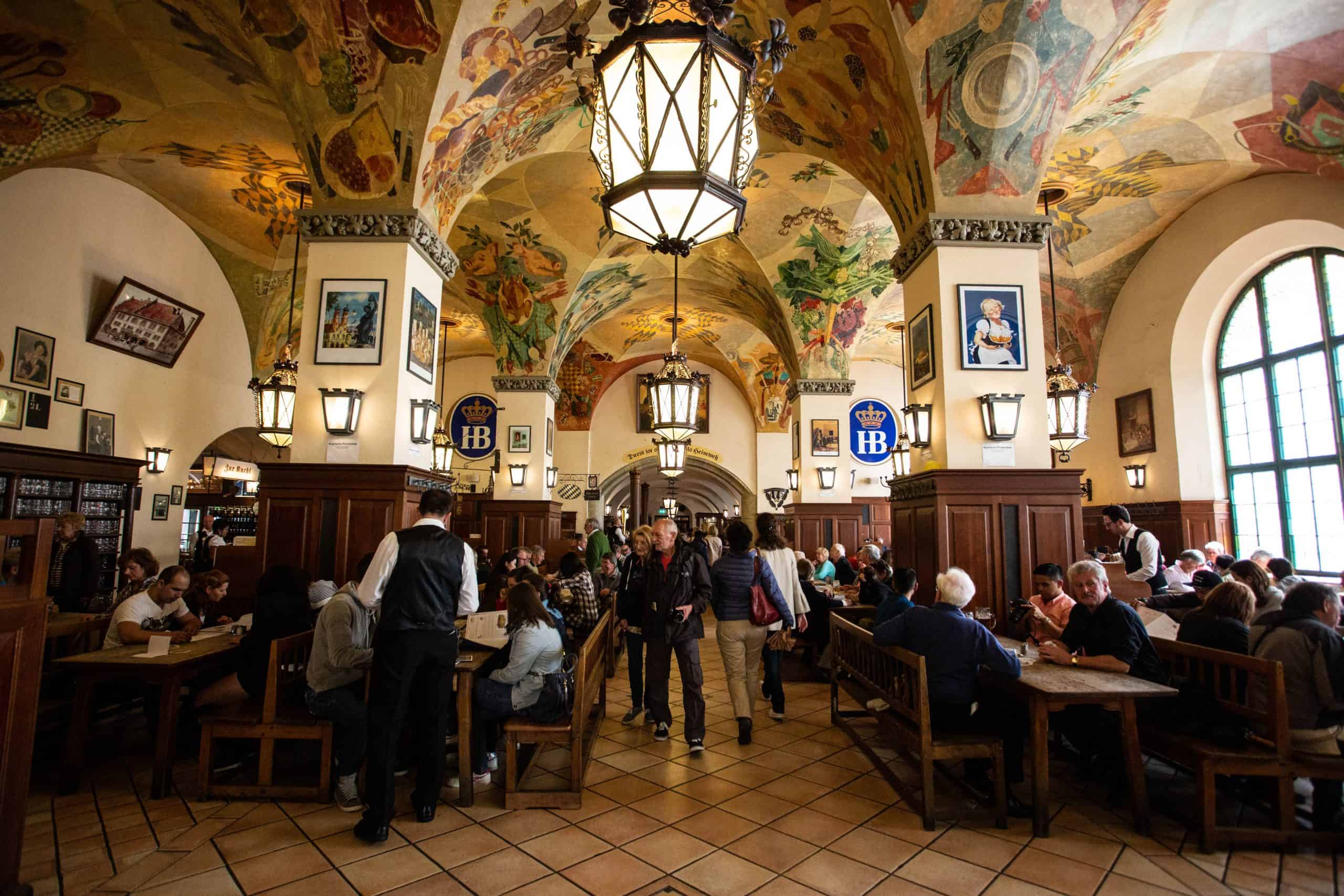
For accommodation, I recommend the Arthotel Munich or Bento Inn Munich Messe .
Day 9: Explore Neuschwanstein Castle
- Distance by car: 109km (67 miles)
- By Train: 3+ hours each way with bus connections (I recommend a tour instead, see below)
Today you’ll be going on a day trip to Füssen, south of Munich.
If you have time, start with a hefty white sausage breakfast – classic Bavaria style. It’s called Weißwurst in Germany, and you can have a tasty one at Schneider Brauhaus, Airbraeu Brauhaus, or Hofbraeukeller.
Füssen is the town that sits at the base of Neuschwanstein Castle, Germany’s most famous castle. It’s the inspiration behind Disney’s castle in Sleeping Beauty.
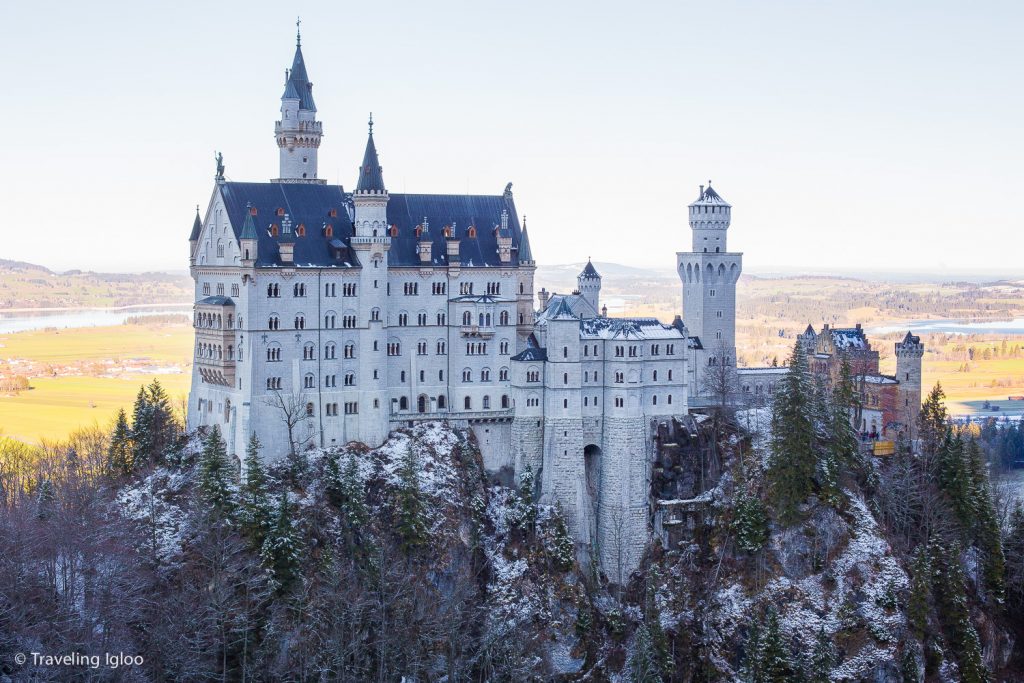
The fastest way to get to the castle from Munich is by car, and there’s also the option to take the train (which requires many connections).
Or, you can book an inexpensive day tour like this one and have everything done for you. This is my personal recommendation to avoid parking, purchasing tickets, and a lot of waiting.
I recommend booking your tour ahead of time as the line can get really long quickly.
There are actually a few castles in this area. The tour of Neuschwanstein is a bit anti-climactic, so if you don’t want to wait in line for tickets, you can simply walk up to the castle and explore the courtyard.
The Marienbrücke Bridge is where you can get the famous photo (see above) of the castle. It’s free and is a short walk to the right.
Please keep in mind the bridge site is high above a gorge and can get absolutely packed with people. The boards you walk on are not well secured either, so take caution if you decide to walk across it. From here you can continue a bit further up for even better views (note it is steep).
The only way to avoid the crowds is to arrive early.
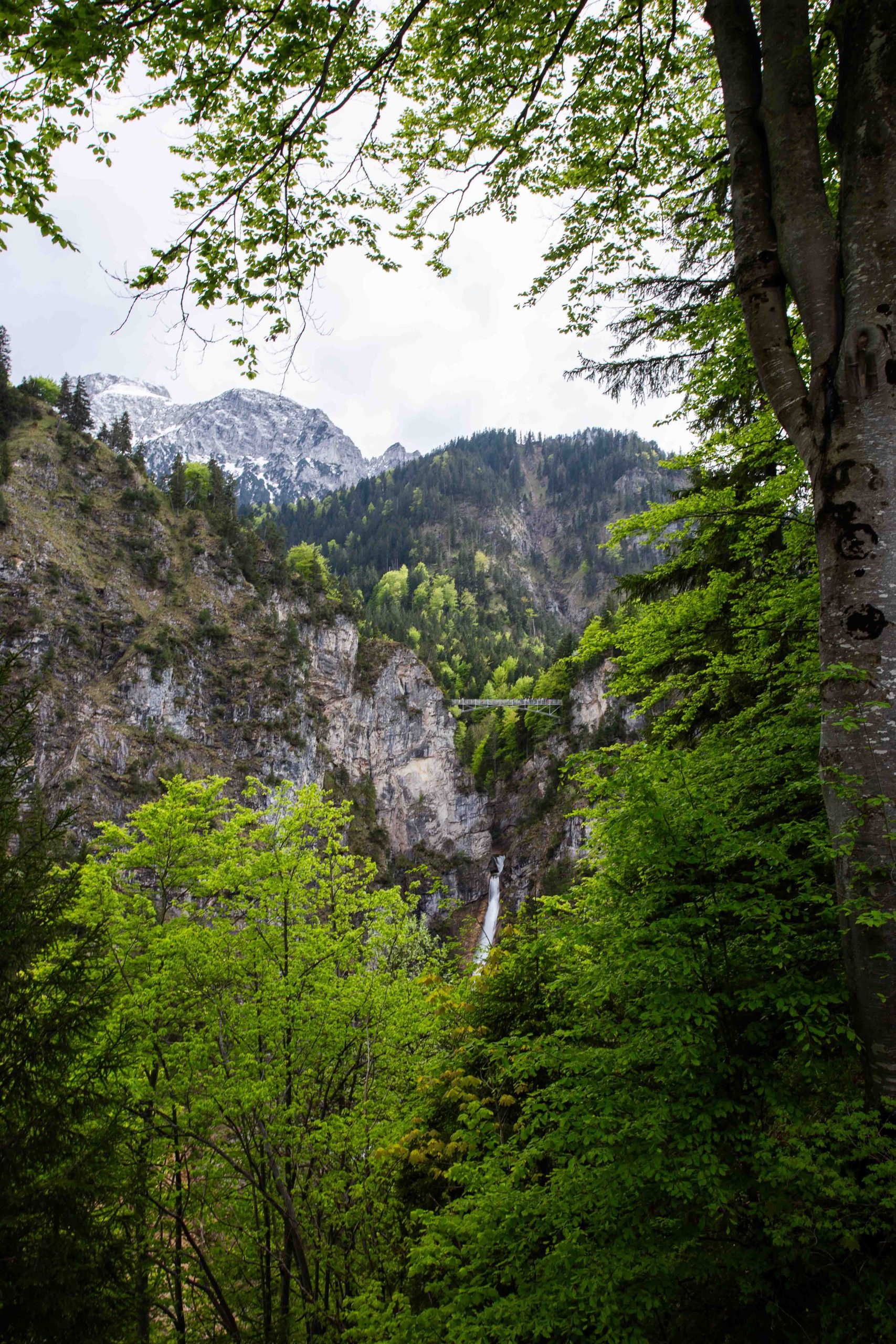
If you’re into a mesmerizing, adrenaline-packed activity, don’t miss out on paragliding in the Alps (over the castle too!). F ly Royal is a fantastic team to book this activity with; you’ll take off from Tegelberg Mountain and the duration of the flight depends on the package you choose.
Alternatively, you can stay on the ground and explore the lake, take a bus or train ride through the castle’s surroundings, go to vantage points, and discover the tale of King Ludwig, it’s all in this tour .
Once you’re done exploring the castle and area, you’ll head back to Munich. That’s your chance to get your fill of Bavarian beer and cuisine at Steinheil 16, Schiller Brau, and Servus Heidi.
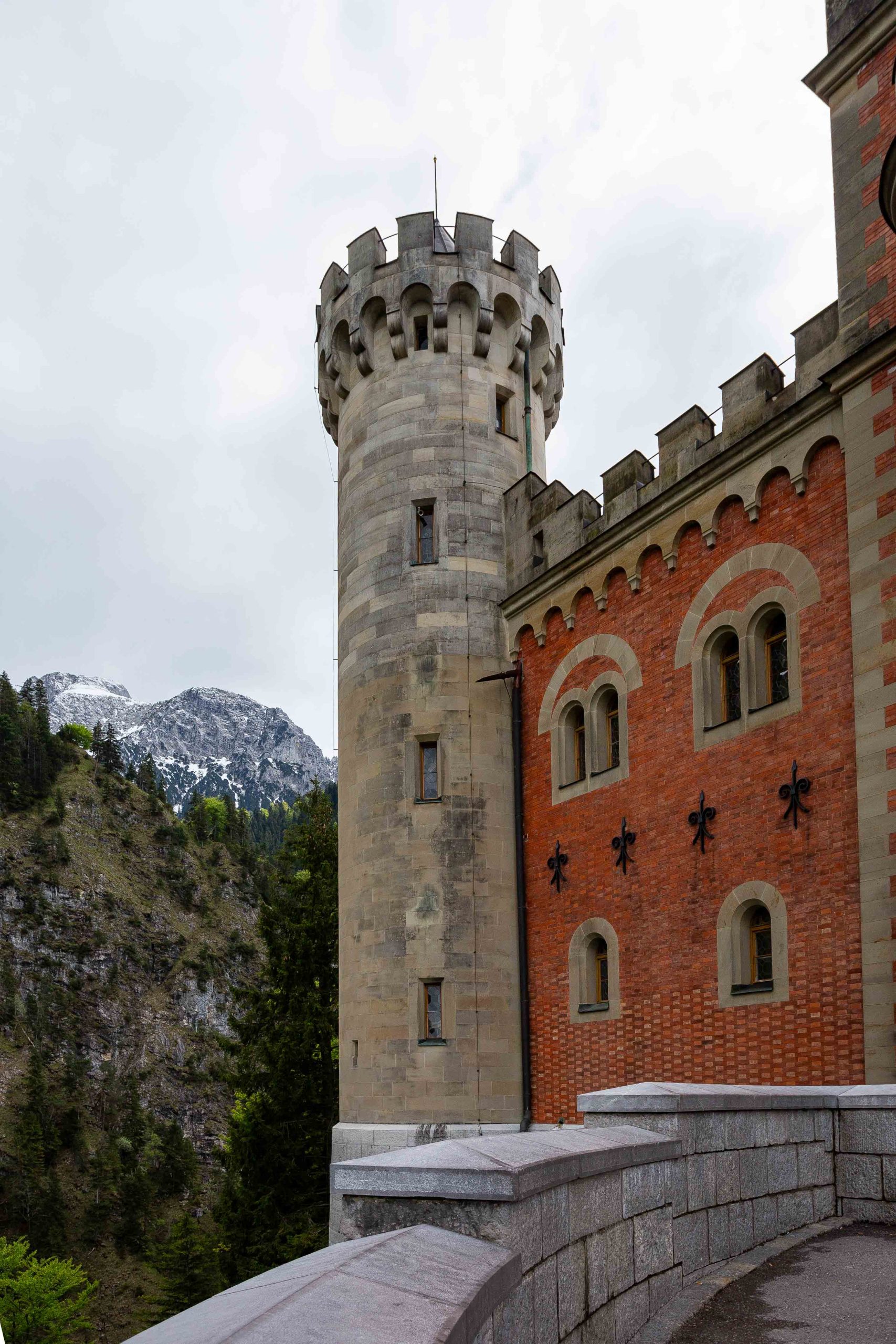
Day 10: Munich/Departure
The last day is all about wrapping up your time in Munich and making your way to the airport to fly back home. If you have time, you can do some last-day shopping at Maximilianstrasse.
If you’re flying from Munich Airport, it’ll take you about 30 minutes by car and around 1 hour by train from the center of Munich.
If you’re departing from Zurich Airport (only because you booked a two-way ticket), a car drive will take you there in about 3 to 4 hours while a train will do it in 5 to 6 hours. Be sure to factor in construction or train delays so you don’t miss your flight.

Things to Keep In Mind When Traveling to Germany, Austria & Switzerland
Here are a few pointers to keep in mind during your Germany, Austria & Switzerland trip:
- All 3 countries speak German, so you only need to learn common phrases in that one language. That saves you a lot of time and hassle, although English will get you by just fine.
- All 3 countries are included in the Schengen visa agreement.
- Germany and Austria use the Euro, but Switzerland uses the Swiss franc.
- Scheduling your trip during the shoulder season (March through April and September through November) should get you lower rates and fewer crowds.
- While getting around by train is more affordable and less confusing, it typically takes longer and may not reach all locations.
- Getting around by car is more costly and forces you to worry about direction/parking, it offers more flexibility and usually takes less time.
Final Thoughts
That brings us to the end of a full-packed 10-day Germany, Austria & Switzerland itinerary for an unforgettable trip. The only thing left for you to do is actually get the show on the road!

I'm Brea, an Alaskan with a serious case of wanderlust. Join me as I share insider information and firsthand accounts to help with your travels. Find destination guides, itineraries, general travel tips, learn how to take better photos, and more! Follow me on Instagram for all my up-to-date travels @travelingigloo
Similar Posts

A Week Spent Skiing In Sölden, Austria
Buying local, raw milk in germany.

Visiting Vienna in The Winter: Things to do and Itinerary
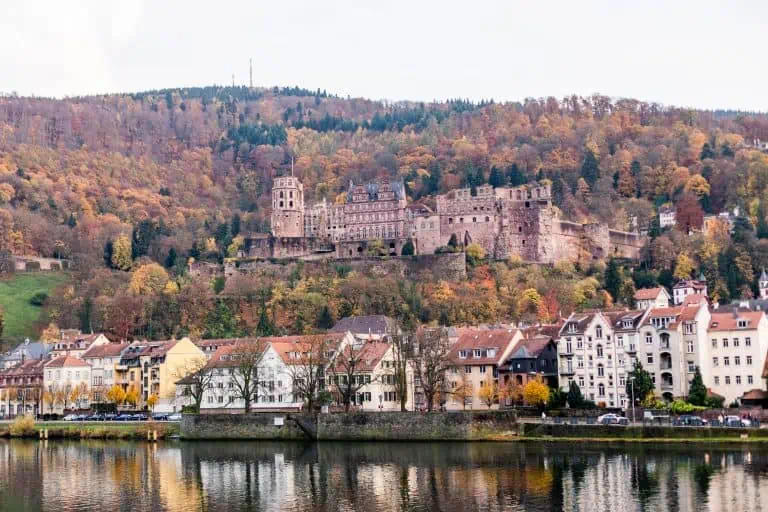
17 Perfect Weekend Trip Ideas from Stuttgart

17 Best Castles To Visit Near Stuttgart

Frauen Parking in Germany
Leave a reply cancel reply.
Your email address will not be published. Required fields are marked *
Save my name, email, and website in this browser for the next time I comment.
Deals of the Week All of Europe's finest Up to 50% OFF
Austria, Germany and Switzerland Tours & Trips
Find the right tour for you through Austria, Germany and Switzerland. We've got 105 tours going to Austria, Germany and Switzerland, starting from just 6 days in length, and the longest tour is 30 days. The most popular month to go is July, which has the highest number of tour departures. 10 days in Germany or 7 days in the Netherlands ? Check here the best travel itineraries.
105 Austria, Germany and Switzerland tour packages with 1,119 reviews
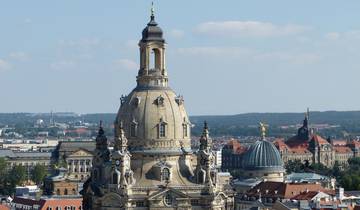
- In-depth Cultural
- Coach / Bus
- Christmas & New Year
Magnificent Four
brilliant. The tour spent the perfect amount of time in each location, the tour guides - shout-out to both Gabby and Linus! - were so brilliantly customer focused, informative, patient, professional. They removed any hiccups and made the trip easy to just enjoy.
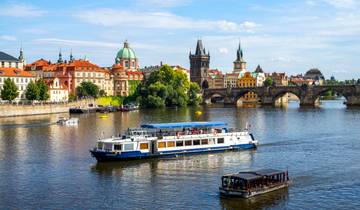
From Prague to Zurich
Overall is good. The tour guide shd have more knowledge. The bus shd be better and wifi available during long voyages. Time given for us to shop is limited.
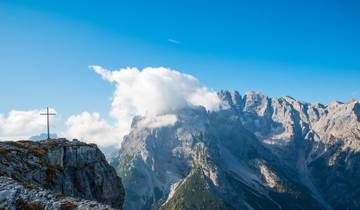
Switzerland and Austria (2024, 13 Days)
We had a fantastic Tour Guide Dr Qiu Moayad, and Venci our Coach Captain, both brilliant.
- €100 deposit on some dates Some departure dates offer you the chance to book this tour with a lower deposit.
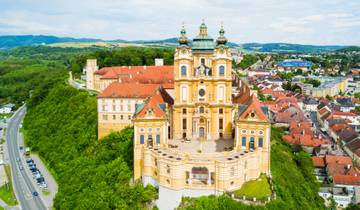
- River Cruise
Enchanted Europe with 2 Nights in Budapest for Beer Enthusiasts (Westbound)

- Sightseeing
Exploring the Alpine Countries Austria - Germany - Switzerland (Vienna to Lucerne) (2024)
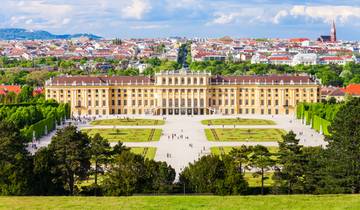
The Best of Austria & Switzerland with Romantic Rhine 2024

Winter Wonderland (Small Groups, 9 Days)

10-Days Cheese & Alps Euro Rail Trail: Milan, Switzerland, Liechtenstein, Germany, Austria

Alpine Christmas Markets (Classic, 9 Days)
A beautiful alpine itinerary with fairytale scenery dusted in snow that certainly put me in the mood for Christmas. We visited a great variety of places and sampled some wonderful dining - my highlight was hearty German pork knuckle. The activities and experiences that stood out to me were exploring Salzburg with a Local Expert, visiting Oberammergau and riding on a horse-drawn carriage through Tyrol. It certainly would have been challenging to access many of the experiences had I been in the area travelling independently, and I doubt I would have managed to create such a full and rich sightseeing agenda. John was a great Travel Director and overall, I would definitely recommend this trip.
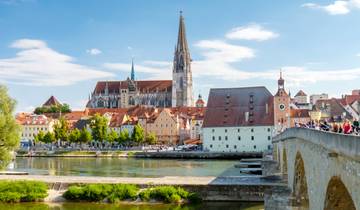
Grand Central Europe & Zurich (2024) (Zurich to Vienna, 2024)

- Self-Guided Cycling
Alpine Rhine Cycle
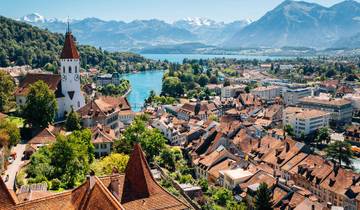
CLASSIC ALPS GERMANY, SWITZERLAND & AUSTRIA

Grand Central Europe (2024) (Basel to Vienna, 2024)
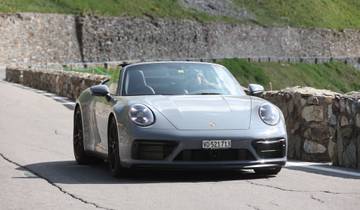
Summer 5-Country Alpine Tour in a Porsche: Pre-set sat-nav guided

- Train & Rail
Grand Alpine - Salzburg
What people love about austria, germany and switzerland tours.
The hotels that we stayed in are nice. We had two guides throughout the 6 day tour.
Unbelievable experience Fantastic company coach and tour guide amazing
- Fully Guided (91)
- Family (73)
- River Cruise (47)
- In-depth Cultural (25)
- Coach / Bus (19)
- Personalized (14)
- Private (8)
- Self-Guided (7)
- Train & Rail (7)
Travel Styles
- Small Group (5)
- Luxury (16)
- Singles and Solo (39)
- For Couples (41)
- Seniors (33)
- 10 Day Tours (11)
- 2 Week Tours (8)
- 3 Week Tours (20)
- 1 Month+ Tours (5)
- Spring 2024 (2)
- Summer 2024 (24)
- Fall / Autumn 2024 (22)
- Winter 2024 / 2025 (8)
- Spring 2025 (12)
- Summer 2025 (12)
- Fall / Autumn 2025 (12)
- Winter 2025 / 2026 (6)
- May 2024 (10)
- June 2024 (17)
- July 2024 (24)
- August 2024 (16)
- September 2024 (17)
- October 2024 (18)
- November 2024 (10)
- December 2024 (8)
- January 2025 (5)
- February 2025 (5)
- March 2025 (7)
- April 2025 (5)
- May 2025 (12)
- June 2025 (9)
- July 2025 (11)
- August 2025 (8)
- September 2025 (8)
- October 2025 (6)
- November 2025 (7)
- December 2025 (6)
Discover TourRadar
- Serengeti Safari
- New Zealand Tours
- Iceland Adventure: Northern Lights & Snæfellsnes Peninsula
- Wonders of India And Nepal
- Croatia + Bosnia all seasons discovery 9 days tour from Zagreb to Dubrovnik. UNESCO sites, Venetian fortresses, medieval towns, and panoramic roads.
- Birding Under Blue Skies: the Great Bustard Adventure
- 10 Days Best of Kenya and Tanzania Safari

IMAGES
VIDEO
COMMENTS
What companies run services between Switzerland and Germany? Swiss flies from Zürich to Stuttgart 3 times a day. Alternatively, Deutsche Bahn Intercity-Express operates a train from Zuerich Hb to Berlin Hbf twice daily. Tickets cost €130 - €150 and the journey takes 8h 33m. ÖBB also services this route 4 times a day.
Train rides between Germany and Switzerland can be as cheap as CHF 20 to CHF 35, even for long routes from northern Germany. Some commercial bus companies offer similar low fares. However, there are fewer bus connections than train connections. The buses usually don't depart from, and arrive in, the town centers.
Also, you can give yourself more time to enjoy the actual traveling, as road tripping and train travel (at least in Switzerland) give you the option to enjoy the breathtaking scenery, and you can take some rest and just soak in the beauty. Berlin - 1,5 Days. Munich - 1,5 Days. Neuschwanstein Castle & Füssen - 1 Day.
Discover Germany & Switzerland with Gate 1 Travel's Central Europe Tours. We offer great deals on Germany & Switzerland vacation packages. Get away and discover the beauty of Central Europe./ ... Our trip to Germany, Switzerland and Austria was fabulous. Our tour guide Julian was extraordinary. He anticipated every need, made clear each day's ...
Rome2Rio makes travelling from Germany to Switzerland easy. Rome2Rio is a door-to-door travel information and booking engine, helping you get to and from any location in the world. Find all the transport options for your trip from Germany to Switzerland right here.
Winter travel in Germany can be cold but beautiful. One of my favorite times of year to travel in Germany is during the four weeks of advent at Christmas. Yes, it gets dark early (by 5pm or a bit earlier) but the lights, decorations, and Christmas markets more than make up for it. Plus, you can go skiing and enjoy other winter activities.
The Hotels in Switzerland were all top notch. Our tours visiting Castles and Towns were as good as we remembered others from earlier tours. Our admiration and respect for Scenic remains very strong. Destinations Switzerland, Germany, France, Netherlands +2 more Age Range up to 99 year olds Ships
Call us in Washington, D.C. at 1-888-407-4747 (toll-free in the United States and Canada) or 1-202-501-4444 (from all other countries) from 8:00 a.m. to 8:00 p.m., Eastern Standard Time, Monday through Friday (except U.S. federal holidays). See the State Department's travel website for the Worldwide Caution and Travel Advisories.
Drive from Frankfurt to Zürich. car. 257.7 mi. $84-121. Train, train to Frankfurt, fly to Basel • 5h 46m. Take the train from Markt Bibart to Würzburg Hbf. train. Take the train from Wuerzburg Hbf to Frankfurt (M) Flughafen Fernbf. train.
Entry from Schengen / EU / EFTA: possible without restrictions. Entry from third countries: With effect from 2 May 2022, all remaining countries are removed from the SEM risk country list. This means that entry into Switzerland from all countries in the world will again be possible as before the pandemic. More information: Travel-Check (FOPH)
2. Re: Travel itinerary for Switzerland and Germany. Hello Sujit, I fully agree with Pore: a week in central Switzerland with base in Lucerne and visits to the Swiss transport museum, the Tierpark in Goldau, the mount Rigi (roundtrip with cogwheel trains and boat), the Ballenberg, the Glasi, the Titlis.
The flight from Switzerland to Germany travelling the Zurich - Munich route usually takes 1:25 hours. How much does a flight from Switzerland to cost on swiss.com? On swiss.com we offer flights for the Zurich, Switzerland, - Munich, Germany route from CHF 124. From which airports in Switzerland do flights to Germany depart that can be booked on ...
Itinerary Overview. Day 1: Overnight Flight. Day 2: Munich Sight Seeing. Day 3: Neuschwanstein Castle. Day 4: Drive to Venice + Lunch in Austria. Day 5: Explore Venice. Day 6: Drive to Swizerland + lunch in Verona. Day 7: Explore Switzerland + Mt. Pilatus. Day 8: Drive to Frankfurt.
Germany Travel Itinerary 7 Days - West. For this itinerary, the total driving time would be around 14 - 15 hours and the distance would be slightly over 1100 km. For these calculations, we included the day trip to Monschau (and back to Cologne) as well as the day trip to Freiburg im Breisgau (and back to Stuttgart), which would be a longer ...
What follows is a categorical breakdown of travel costs for Switzerland and Germany in more detail. Accommodation. Accommodation Hotel or hostel for one person Switzerland $ 169 Germany $ 80 Accommodation Typical double-occupancy room Switzerland $ 338. Germany $ 160. Compare Hotels in Switzerland and Germany ...
There are 10 ways to get from Geneva to Germany by plane, bus, train, night train, or car. Select an option below to see step-by-step directions and to compare ticket prices and travel times in Rome2rio's travel planner. Recommended option. Fly Geneva to Frankfurt • 3h 57m
Travelers of all ages and interests will find something to love on a trip here. Combine your choice of destinations into a customized Germany, Switzerland & Austria itinerary and we'll make sure the whole trip goes like Swiss clockwork. From alpine lakes and soaring peaks to quaint market towns to impressive old imperial cities, this trio of ...
Accommodation and Lodging. Your 10 Day Germany Austria and Switzerland Itinerary. 2 Days in Munich and One Day Trip from Munich. Day Trip: Neuschwanstein Castle from Munich. Salzburg 2 Days with a Day Trip. Salzburg Day 1. Salzburg Day 2. Salzburg Day Trip (Salzburg Day 3) Switzerland.
Best of Germany, Austria & Switzerland in 14 Days Tour. from $4,695 per person + air. On this two-week tour, mountains, Mozart, and mugs of beer all clink together to create a totally yodel-y adventure. Starting in Koblenz, at the confluence of Germany's mighty Rhine River and the misty Mosel, your Rick Steves guide will make this region's ...
Germany Austria Switzerland 10-Day Itinerary. Day 1: Arrival in Zurich & Head to Lucerne. Day 2: Exploring Lauterbrunnen & Interlaken. Day 3: Exploring Grindelwald and Jungfraujoch (Top of Europe) Day 4: Explore Innsbruck. Day 5: Explore Salzburg. Day 6: Explore Salzburg/Berchtesgaden.
Swiss Railways (SBB/CFF/FFS) operates a train from Zuerich Hb to Muenchen Hbf Gl.27-36 every 4 hours. Tickets cost €100 - €190 and the journey takes 3h 31m. Alternatively, FlixBus operates a bus from Zurich Bus Station to Munich central bus station hourly. Tickets cost €25 - €35 and the journey takes 3h 50m.
Starting Point#2: Germany's Black Forest. Located in the southwestern region of Germany, the Black Forest is an ideal starting point for exploring both Germany and Switzerland. We recommend making one place in the Black Forest your home base and exploring the rest through day trips.
Find the right tour for you through Austria, Germany and Switzerland. We've got 105 tours going to Austria, Germany and Switzerland, starting from just 6 days in length, and the longest tour is 30 days. The most popular month to go is July, which has the highest number of tour departures. 10 days in Germany or 7 days in the Netherlands?